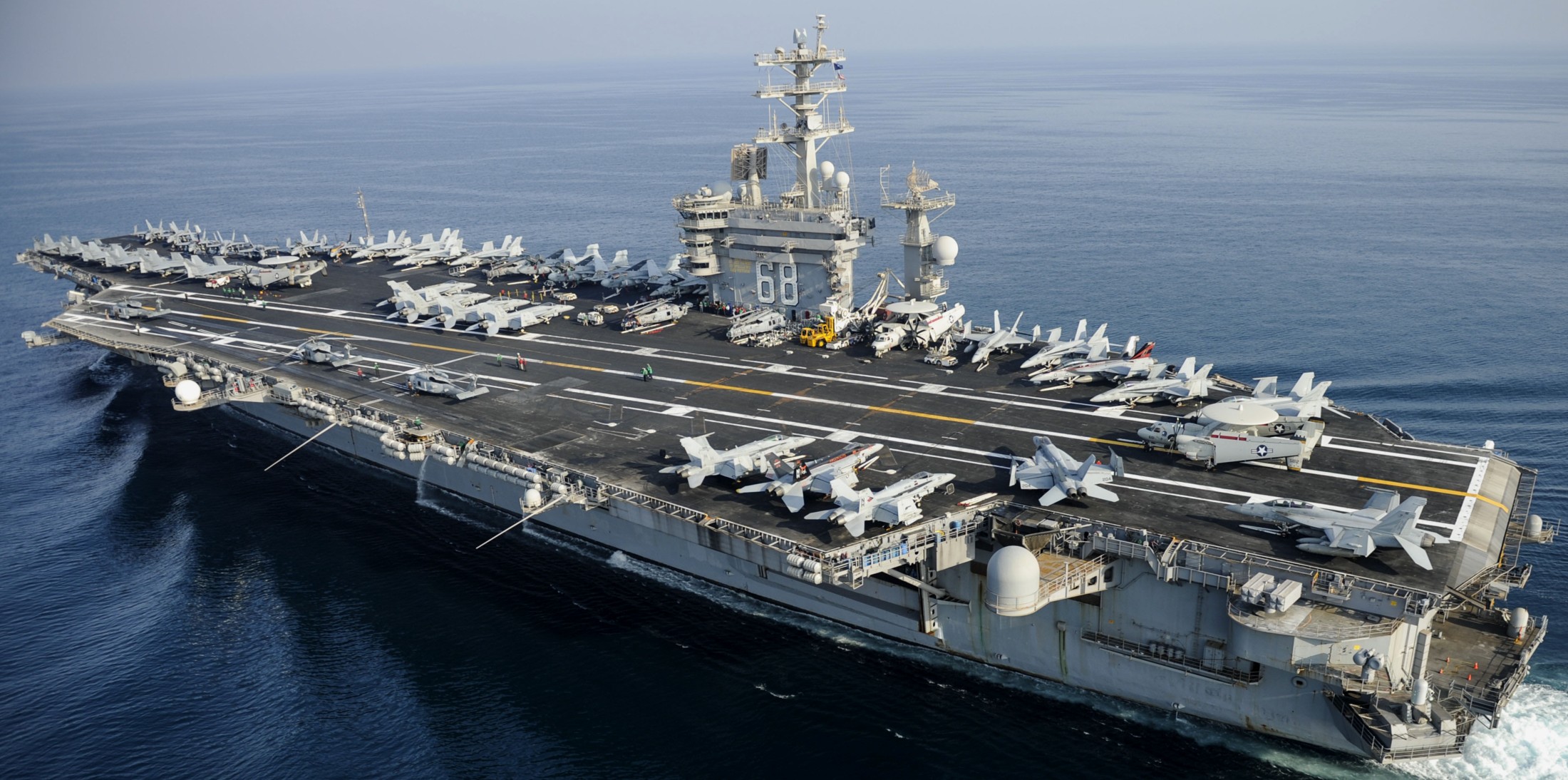 |
||
|
HOME
|
US Navy -
ships
|
US Navy - air
units
|
USMC - air
units
|
International
Navies
|
Weapon Systems
|
Special Reports |
||
|
US Navy - Aircraft Carrier CVN 68 - USS Nimitz |
||
|
||
| 08/25 | ||
|
Type, class: Aircraft
Carrier - CVN; Nimitz class Builder: Newport News Shipbuilding, Newport News, Virginia, USA STATUS: Awarded: March 31, 1967 Laid down: June 22, 1968 Launched: May 13, 1972 Commissioned: May 3, 1975 IN SERVICE Homeport: Naval Base Kitsap, Bremerton, Washington Namesake: FADM Chester W. Nimitz (1885-1966) Ships Motto: TEAMWORK, A TRADITION Technical Data: see: INFO > Nimitz class Aircraft Carrier - CVN |
||
|
Deployments / Carrier Air Wings embarked / major maintenance periods: July 1975 - September 1975 with Carrier Air Wing 8 (CVW-8) - Northern Atlantic July 1976 - February 1977 with Carrier Air Wing 8 (CVW-8) - Mediterranean Sea December 1977 - July 1978 with Carrier Air Wing 8 (CVW-8) - Mediterranean Sea September 1979 - May 1980 with Carrier Air Wing 8 (CVW-8) - Mediterranean Sea, Indian Ocean, Arabian Sea August 1980 - October 1980 with Carrier Air Wing 8 (CVW-8) - exercise Teamwork 80 August 1981 - February 1982 with Carrier Air Wing 8 (CVW-8) - Mediterranean Sea November 1982 - May 1983 with Carrier Air Wing 8 (CVW-8) - Mediterranean Sea June 1983 - July 1984 - Complex Overhaul (COH) at Newport News Shipbuilding & Dry Dock, Virginia March 1985 - October 1985 with Carrier Air Wing 8 (CVW-8) - Mediterranean Sea, Caribbean Sea, Atlantic Ocean August 1986 - October 1986 with Carrier Air Wing 8 (CVW-8) - North Atlantic December 1986 - July 1987 with Carrier Air Wing 8 (CVW-8) - East Coast to West Coast via Cape Horn June 1988 - August 1988 with Carrier Air Wing 9 (CVW-9) - exercise RIMPAC 88 September 1988 - March 1989 with Carrier Air Wing 9 (CVW-9) - Pacific Ocean, Indian Ocean August 1989 - March 1990 - Drydocking Selected Restricted Availability (DSRA) at Puget Sound Naval Shipyard, Bremerton, Washington February 1991 - August 1991 with Carrier Air Wing 9 (CVW-9) - Pacific Ocean, Indian Ocean, Persian Gulf February 1993 - August 1993 with Carrier Air Wing 9 (CVW-9) - Pacific Ocean, Indian Ocean, Persian Gulf December 1993 - January 1995 - Extended Drydocking Selected Restricted Availability (EDSRA) at Puget Sound Naval Shipyard, Bremerton, Washington November 1995 - May 1996 with Carrier Air Wing 9 (CVW-9) - Pacific Ocean, Indian Ocean, Persian Gulf September 1997 - March 1998 with Carrier Air Wing 9 (CVW-9) - World Cruise - Bremerton to Norfolk May 1998 - June 2001 - Refueling and Complex Oferhaul (RCOH) at Newport News Shipbuilding & Dry Dock, Virginia September 2001 - November 2001 with Carrier Air Wing Reserve 20 (CVWR-20) - Norfolk to San Diego via Cape Horn March 2003 - November 2003 with Carrier Air Wing 11 (CVW-11) - Pacific Ocean, Persian Gulf May 2005 - November 2005 with Carrier Air Wing 11 (CVW-11) - Pacific Ocean, Persian Gulf April 2007 - September 2007 with Carrier Air Wing 11 (CVW-11) - Pacific Ocean, Persian Gulf January 2008 - June 2008 with Carrier Air Wing 11 (CVW-11) - Pacific Ocean July 2009 - March 2010 with Carrier Air Wing 11 (CVW-11) - Pacific Ocean, Arabian Sea October 2010 - March 2012 - Drydocking Planned Incremental Availability (DPIA) at Puget Sound Naval Shipyard, Bremerton, Washington June 2012 - August 2012 with Carrier Air Wing 11 (CVW-11) - exercise RIMPAC 2012 March 2013 - December 2013 with Carrier Air Wing 11 (CVW-11) - Pacific Ocean, Mediterranean Sea, Arabian Sea January 2015 - October 2016 - Planned Incremental Availability (PIA) at Puget Sound Naval Shipyard, Bremerton, Washington June 2017 - December 2017 with Carrier Air Wing 11 (CVW-11) - Pacific Ocean, 5th & 7th Fleet AOR March 2018 - May 2019 - Drydocking Planned Incremental Availability (DPIA) at Puget Sound Naval Shipyard, Bremerton, Washington June 2020 - February 2021 with Carrier Air Wing 17 (CVW-17) - Pacific Ocean, 5th & 7th Fleet AOR March 2021 - November 2021 - Planned Incremental Availability (PIA) at Puget Sound Naval Shipyard, Bremerton, Washington November 2022 - June 2023 with Carrier Air Wing 17 (CVW-17) - Pacific Ocean, 7th Fleet AOR March 2025 - ?? with Carrier Air Wing 17 (CVW-17) - Pacific Ocean (final deployment?) Carrier Air Wing 17 (CVW-17) squadrons 2025: Strike Fighter Squadron 22 / VFA-22 Fighting Redcocks Strike Fighter Squadron 94 / VFA-94 Shrikes Strike Fighter Squadron 137 / VFA-137 Kestrels Strike Fighter Squadron 146 / Blue Diamonds Electronic Attack Squadron 139 / VAQ-139 Cougars Airborne Command & Control Squadron 121 / VAW-121 Bluetails Helicopter Sea Combat Squadron 6 / HSC-6 Indians Helicopter Maritime Strike Squadron 73 / HSM-73 Battlecats Fleet Logistics Support Squadron 40 / VRC-40 Rawhides |
||
| images (2018-2025) | ||
 with CVW-17 embarked - Manama, Bahrain - August 10, 2025  underway replenishment - 5th Fleet AOR - August 2025  with CVW-17 embarked - alongside USS Carl Vinson (CVN 70) - CENTCOM AOR - July 2025 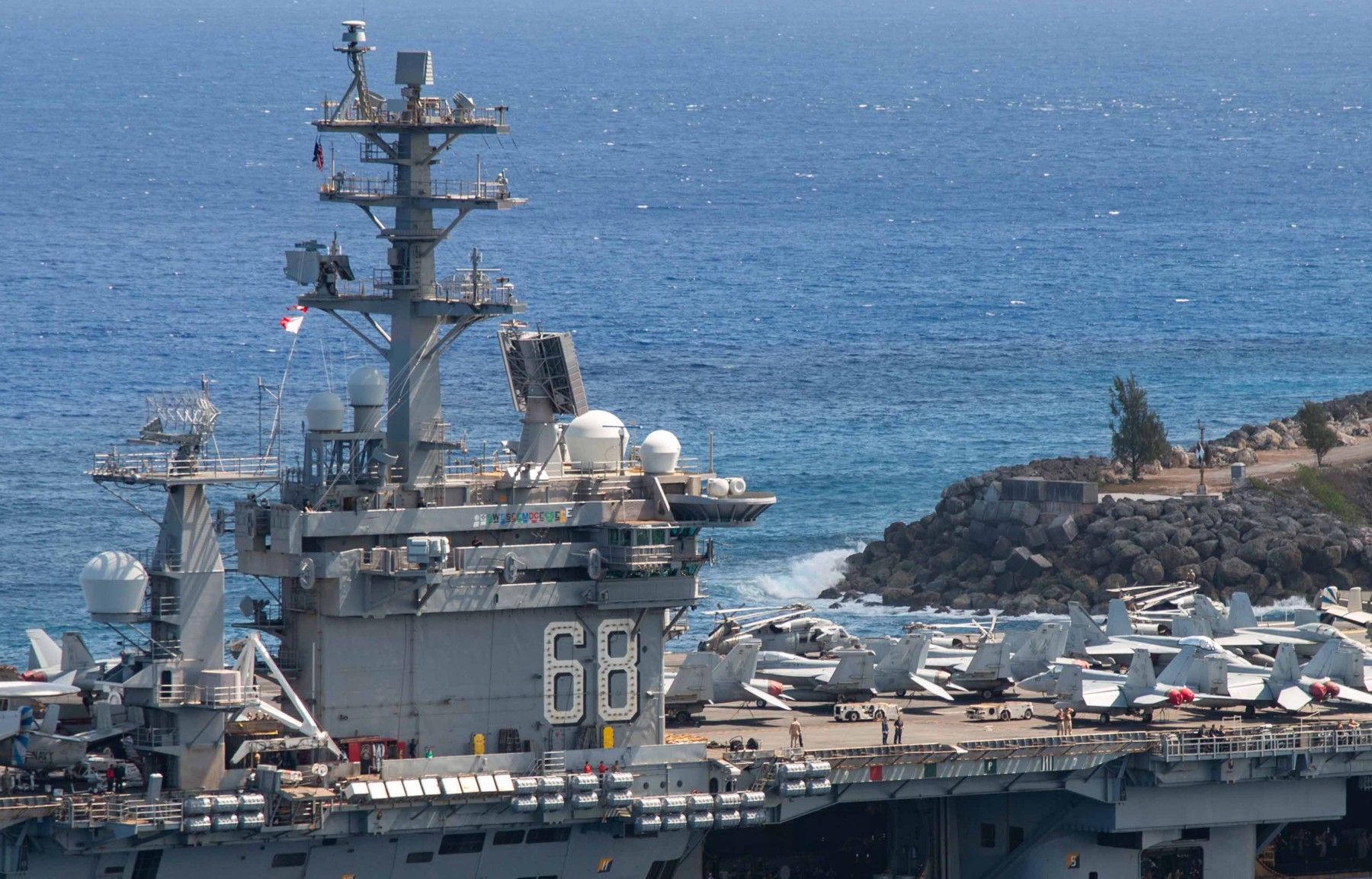 with CVW-17 embarked - arriving in Apra Harbor, Guam - April 18, 2025 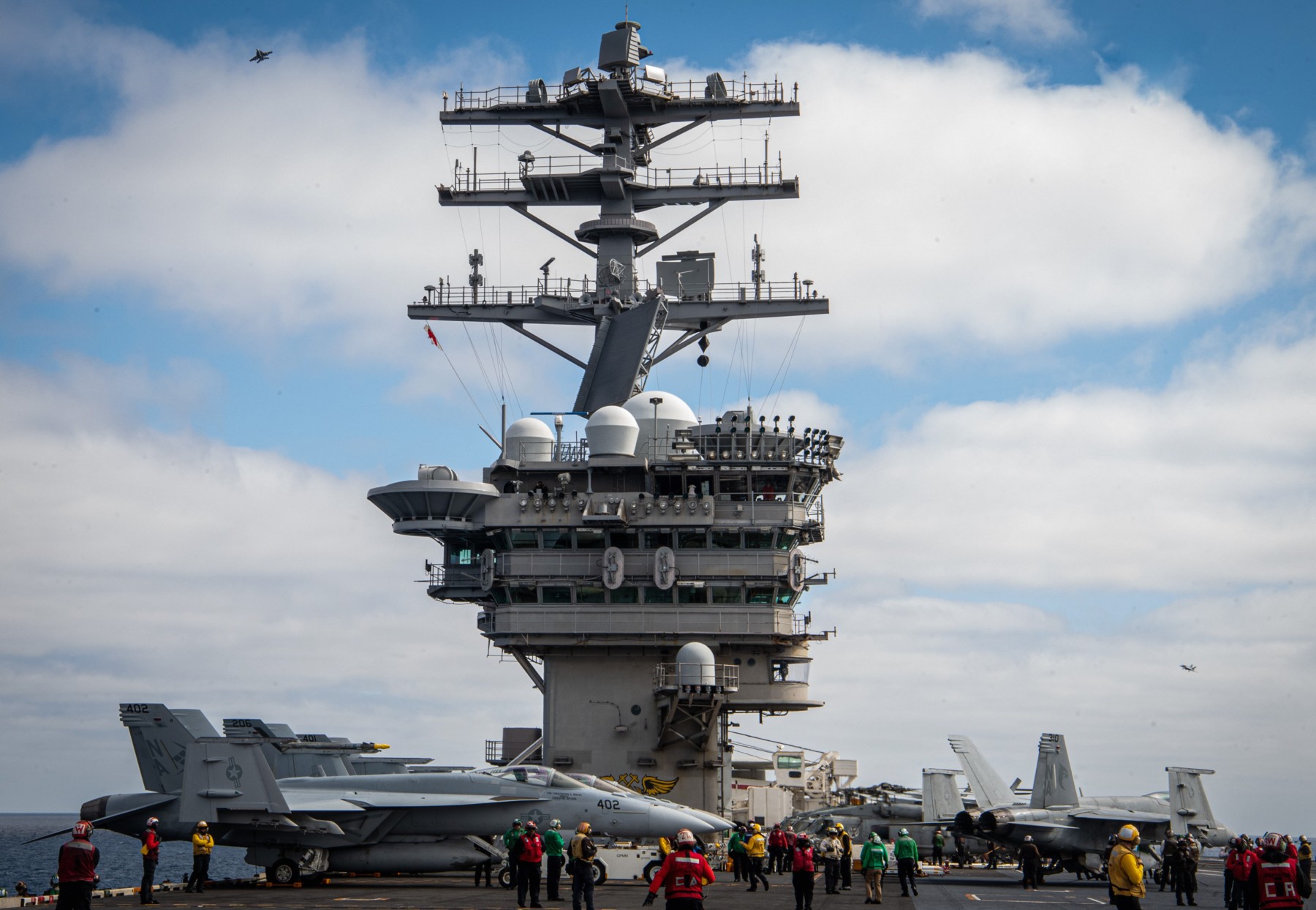 with CVW-17 embarked - Tailored Ship's Training Availability and Final Evaluation Problem (TSTA/FEP) - Pacific Ocean - September 2024 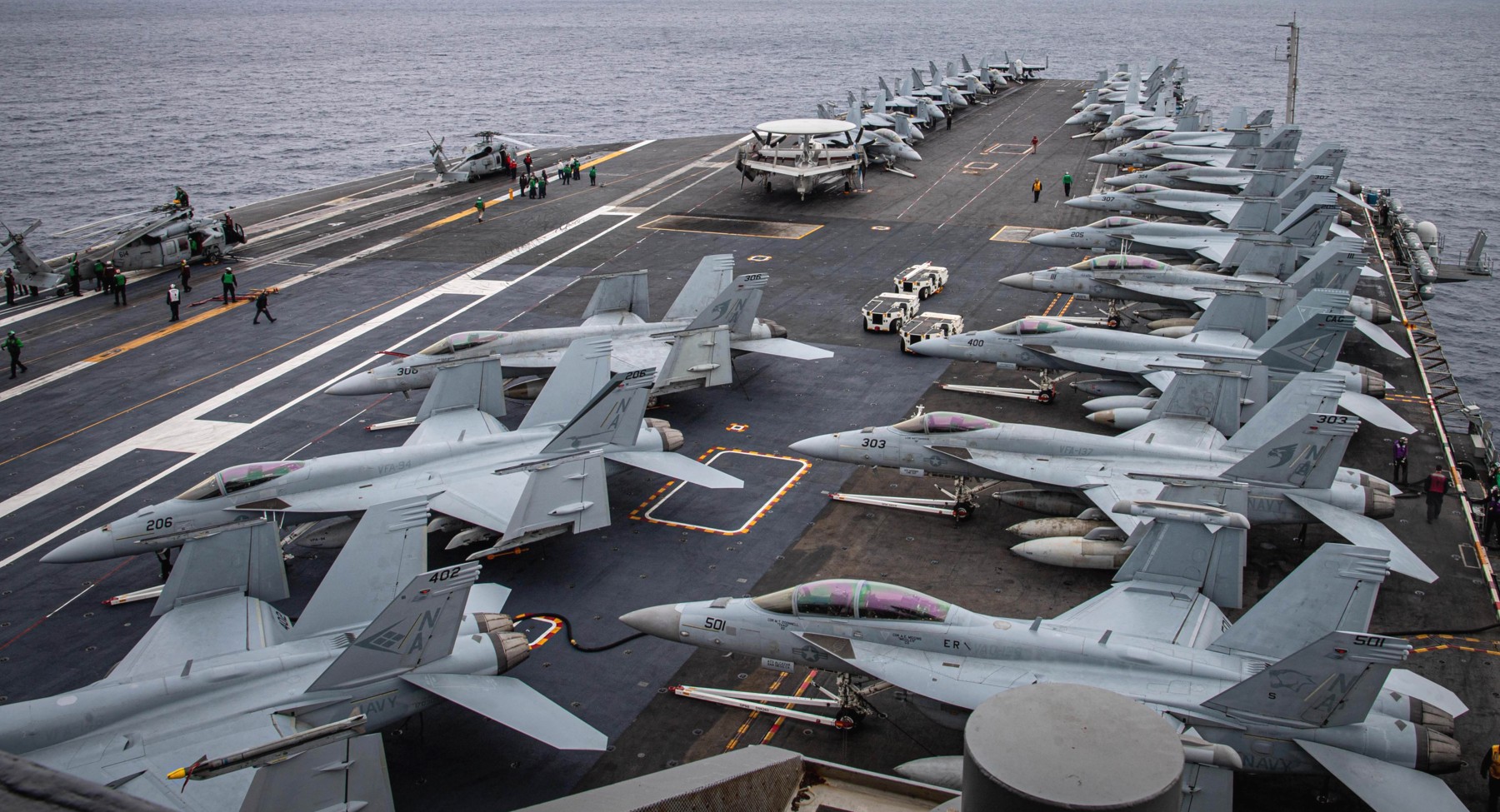 with CVW-17 embarked - Tailored Ship's Training Availability and Final Evaluation Problem (TSTA/FEP) - Pacific Ocean - September 2024 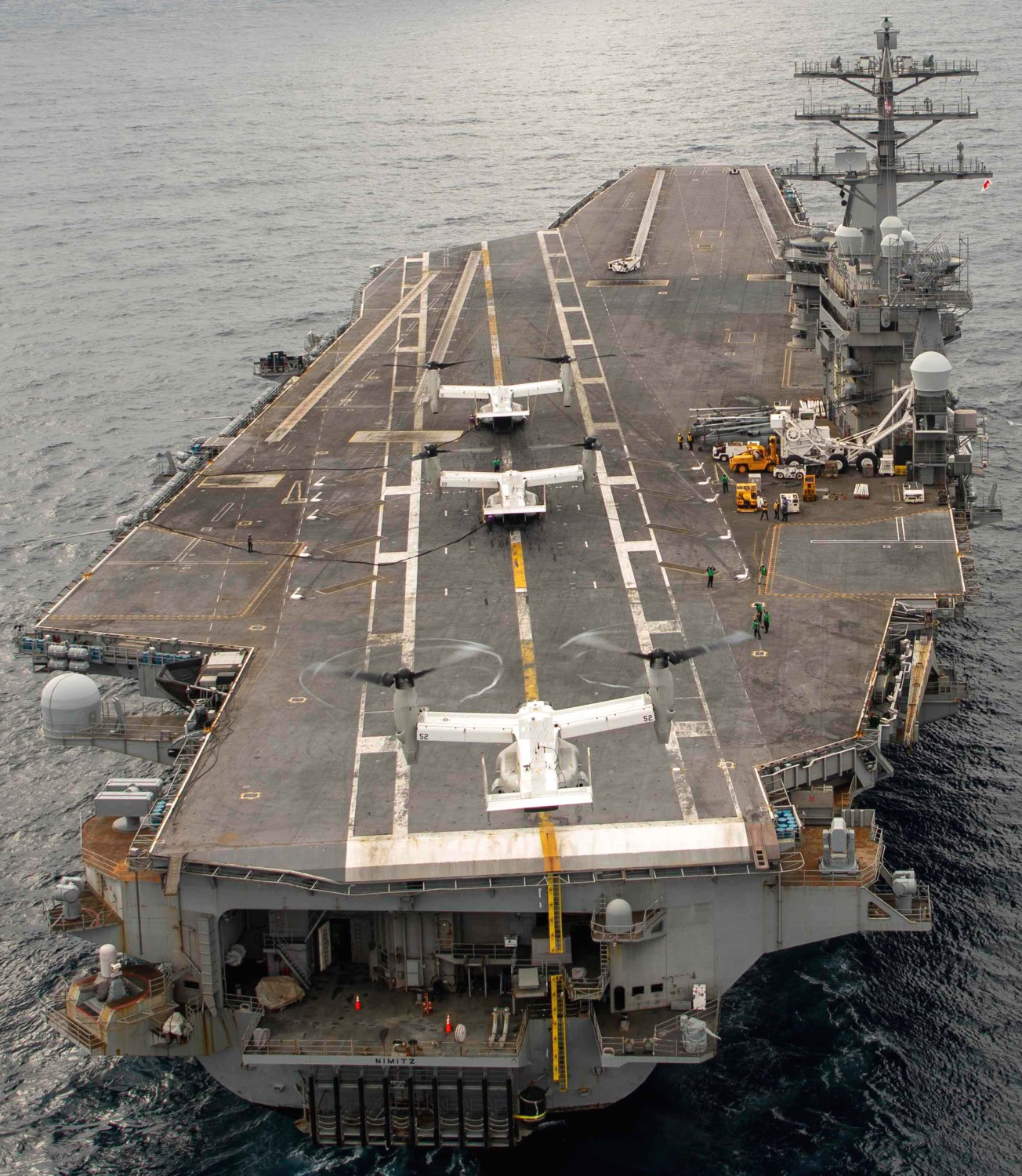 carrier qualifications - Pacific Ocean - July 2024 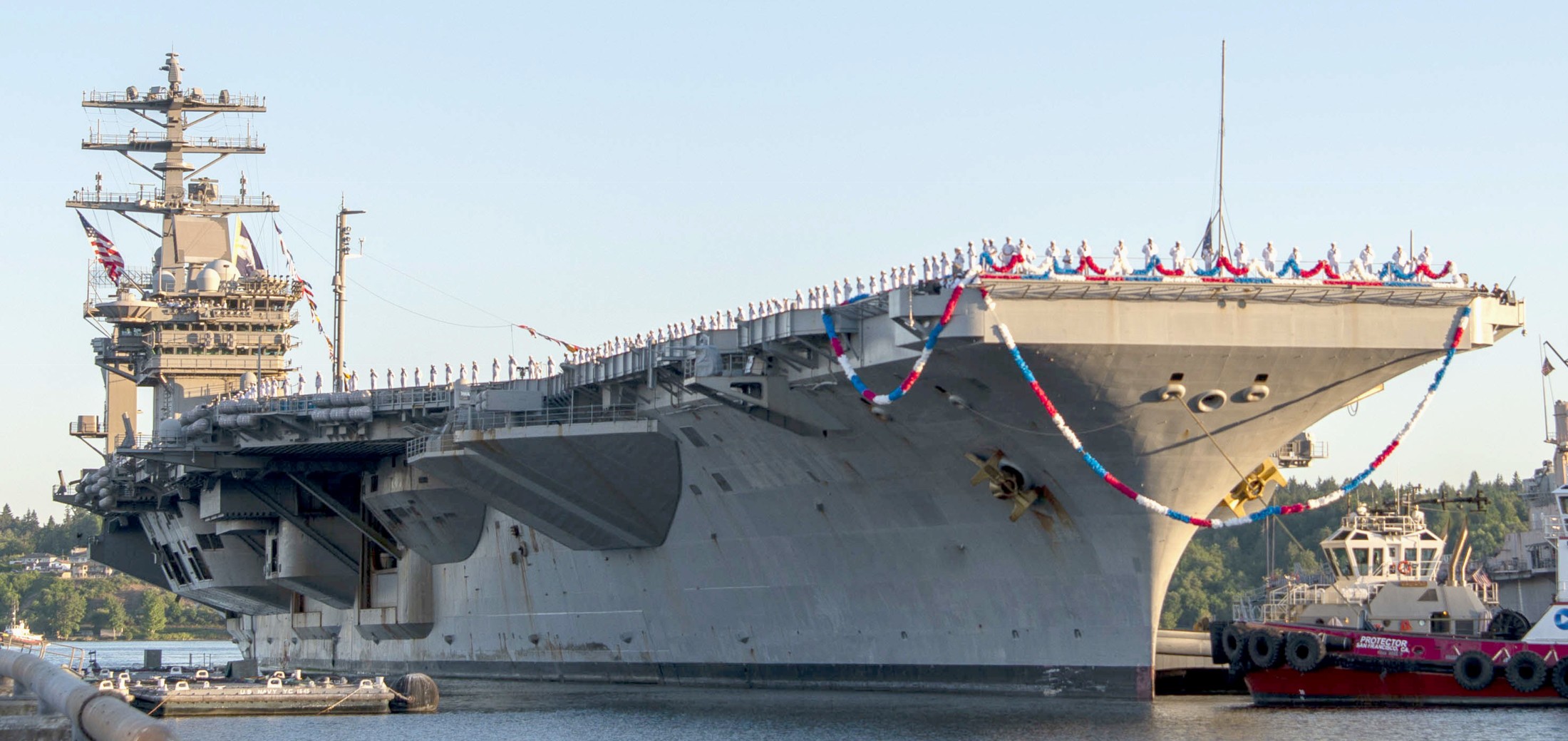 returning to Naval Base Kitsap-Bremerton, Washington - July 2, 2023  returning to Naval Base Kitsap-Bremerton, Washington - July 2, 2023  arriving in San Diego, California to disembark the air wing - June 28, 2023 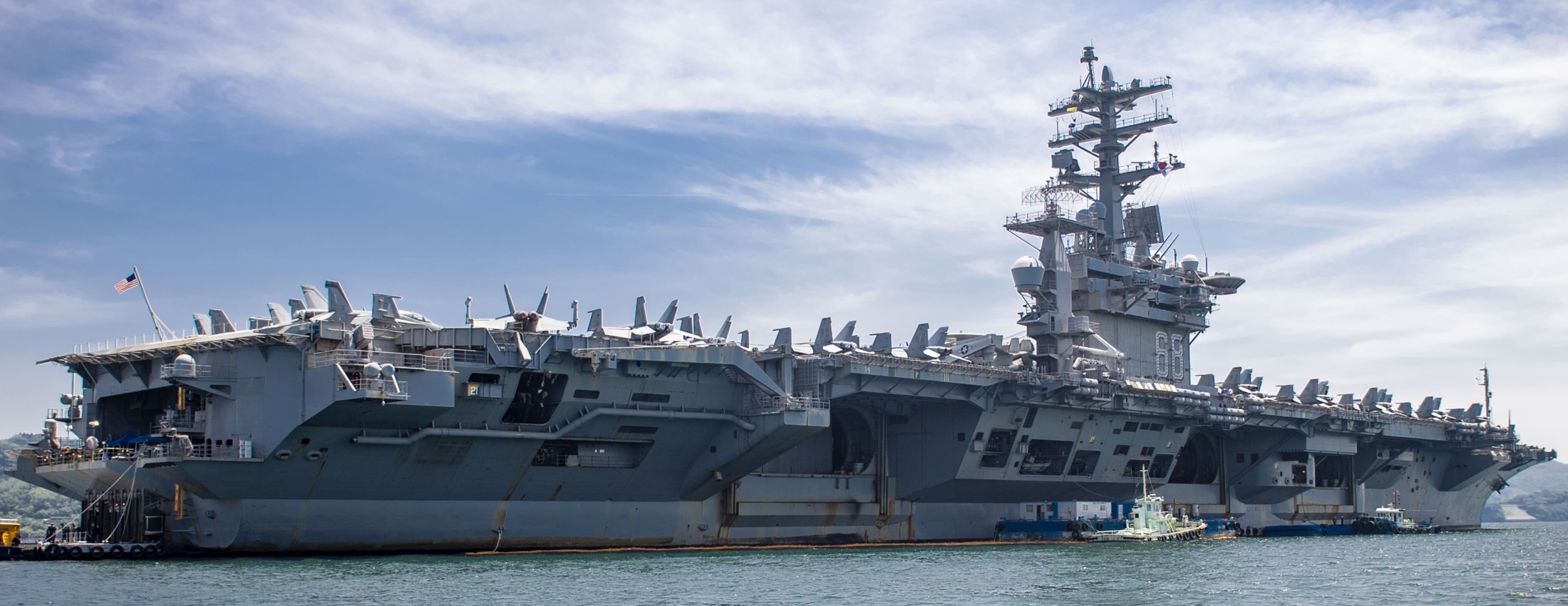 with CVW-17 embarked - Fleet Activities Sasebo, Japan - May 2023 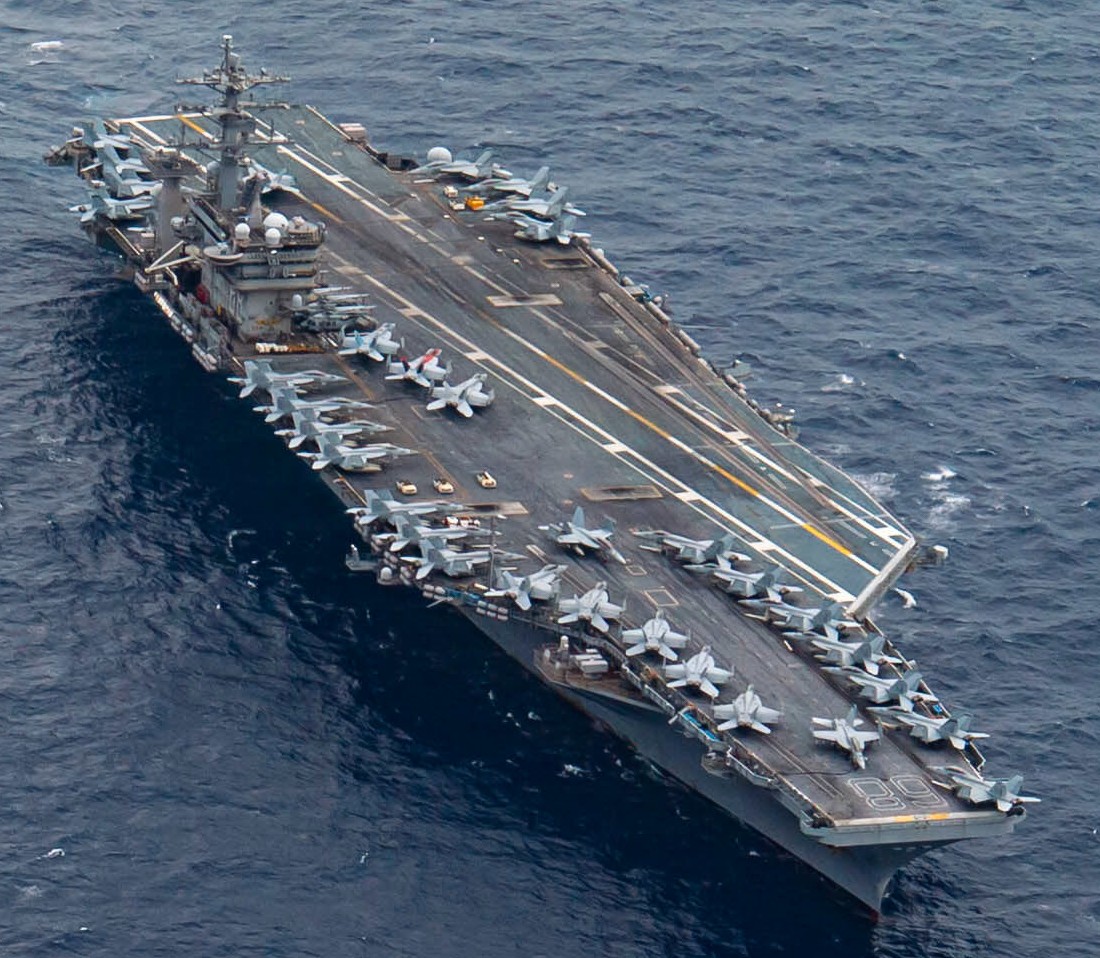 with CVW-17 embarked - Philippine Sea - March 2023 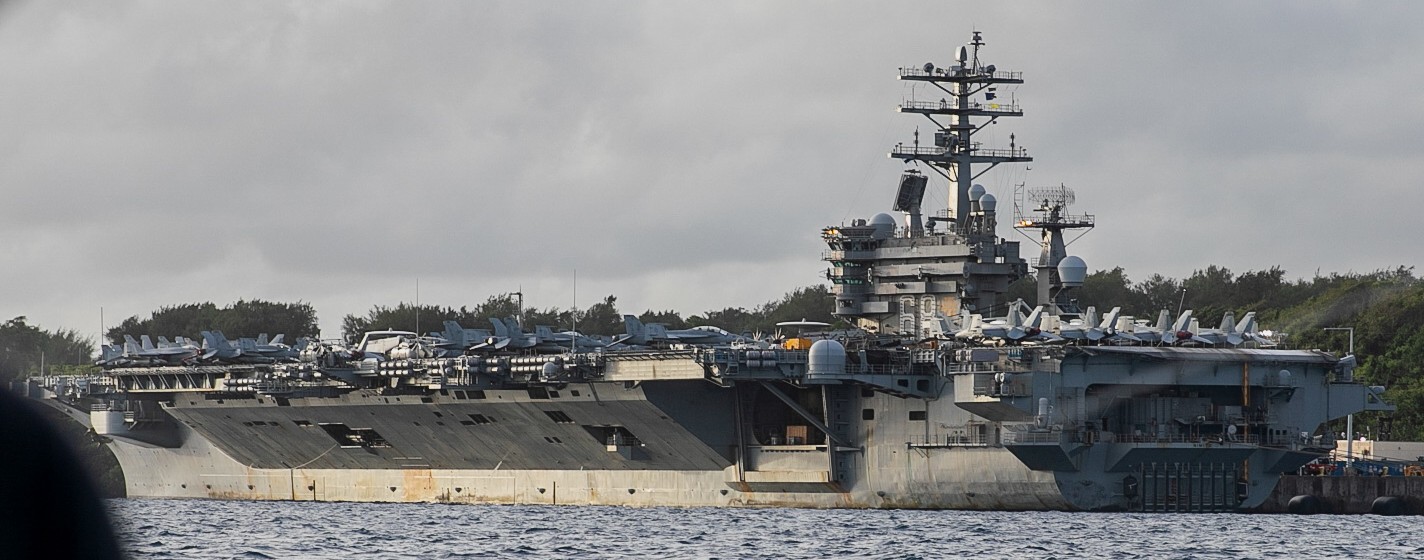 with CVW-17 embarked - Apra Harbor, Guam - March 2023  with CVW-17 embarked - Philippine Sea - February 2023 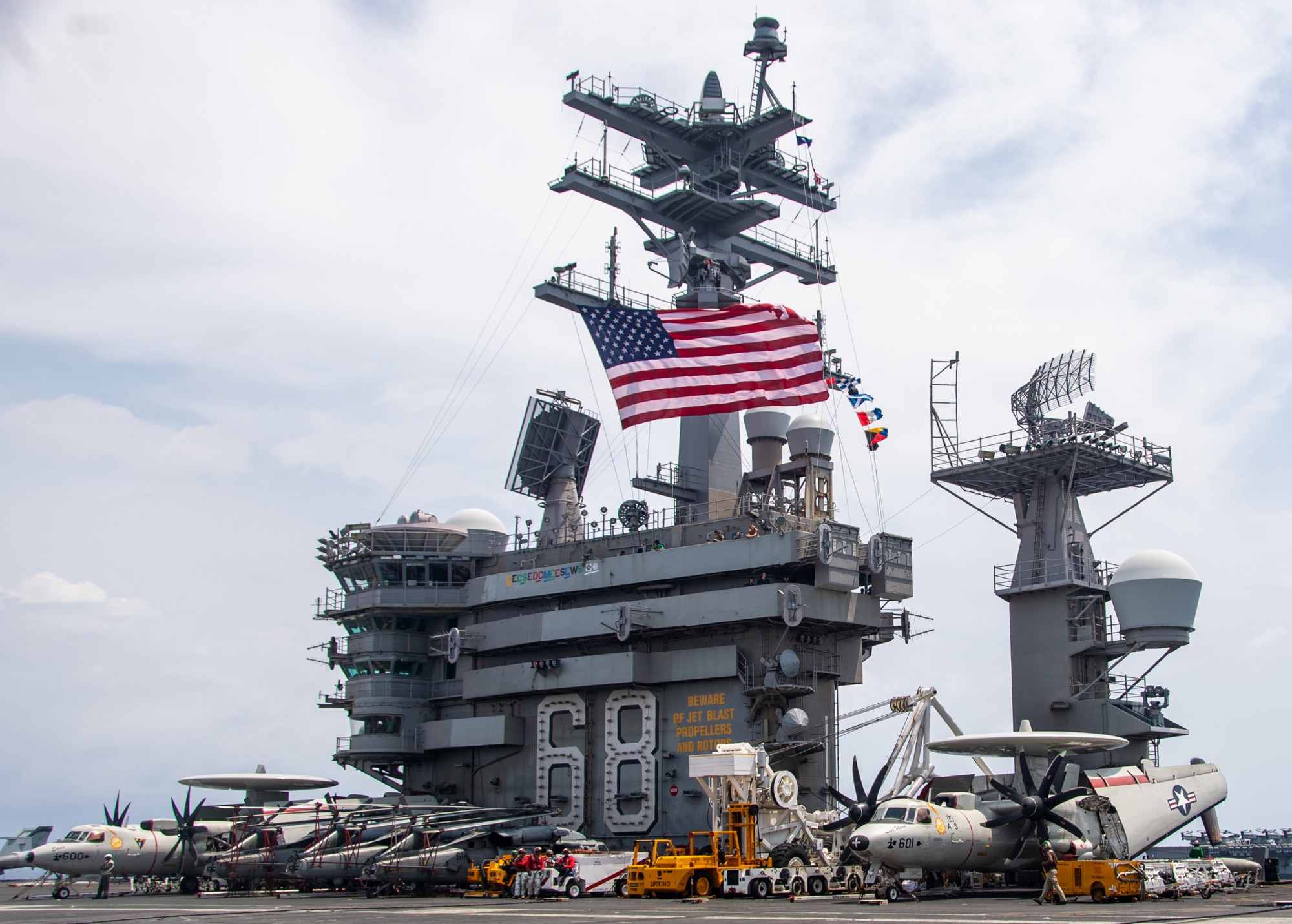 with CVW-17 embarked - South China Sea - February 2023  with CVW-17 embarked - South China Sea - February 2023 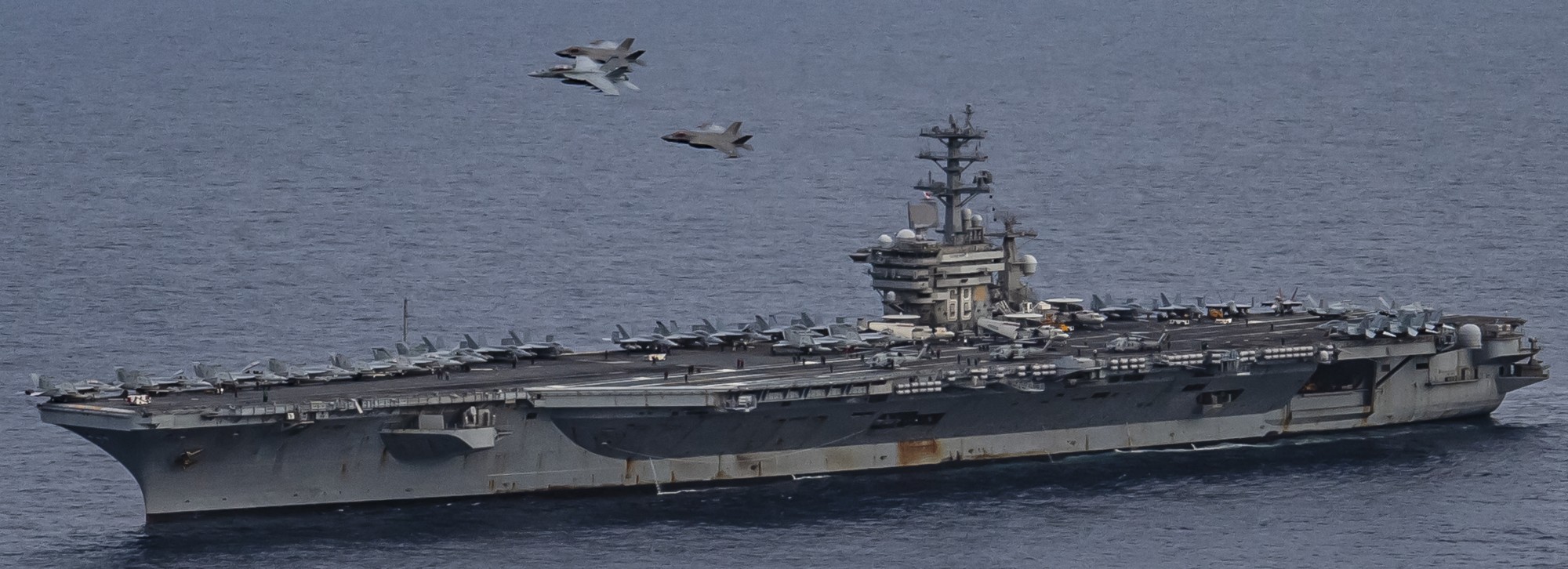 with CVW-17 embarked - South China Sea - February 2023  with CVW-17 embarked - Pacific Ocean - December 2022 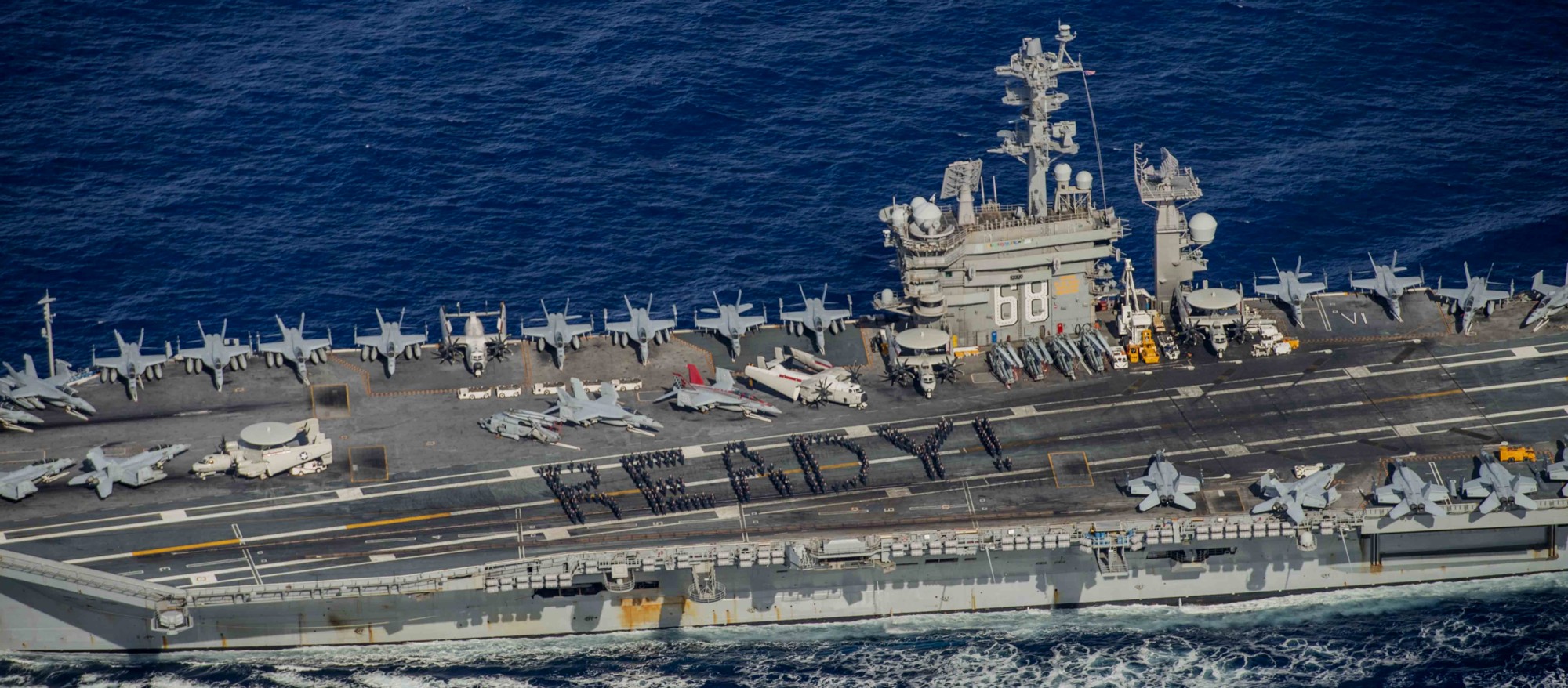 with CVW-17 embarked - Pacific Ocean - December 2022 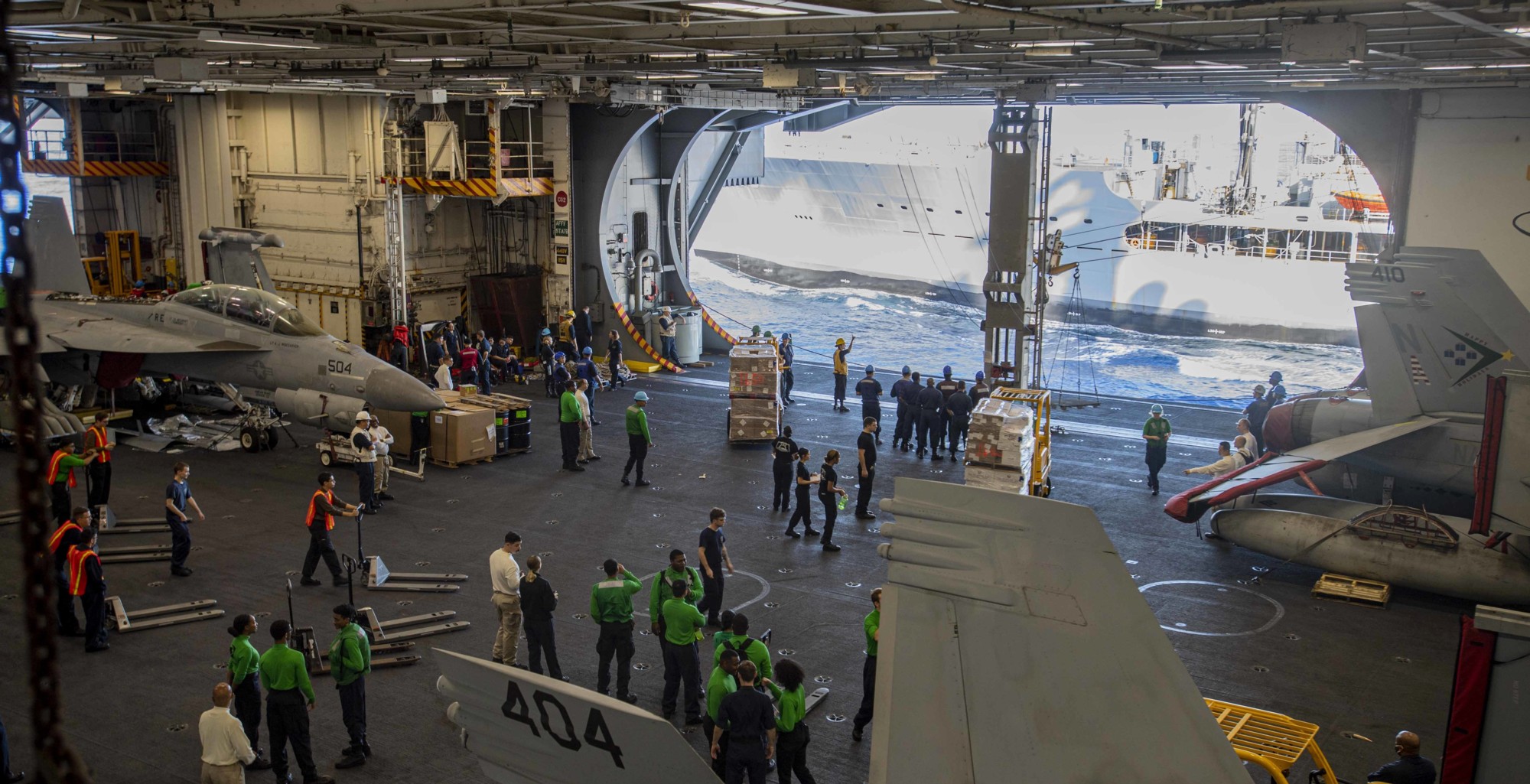 with CVW-17 embarked - Pacific Ocean - December 2022 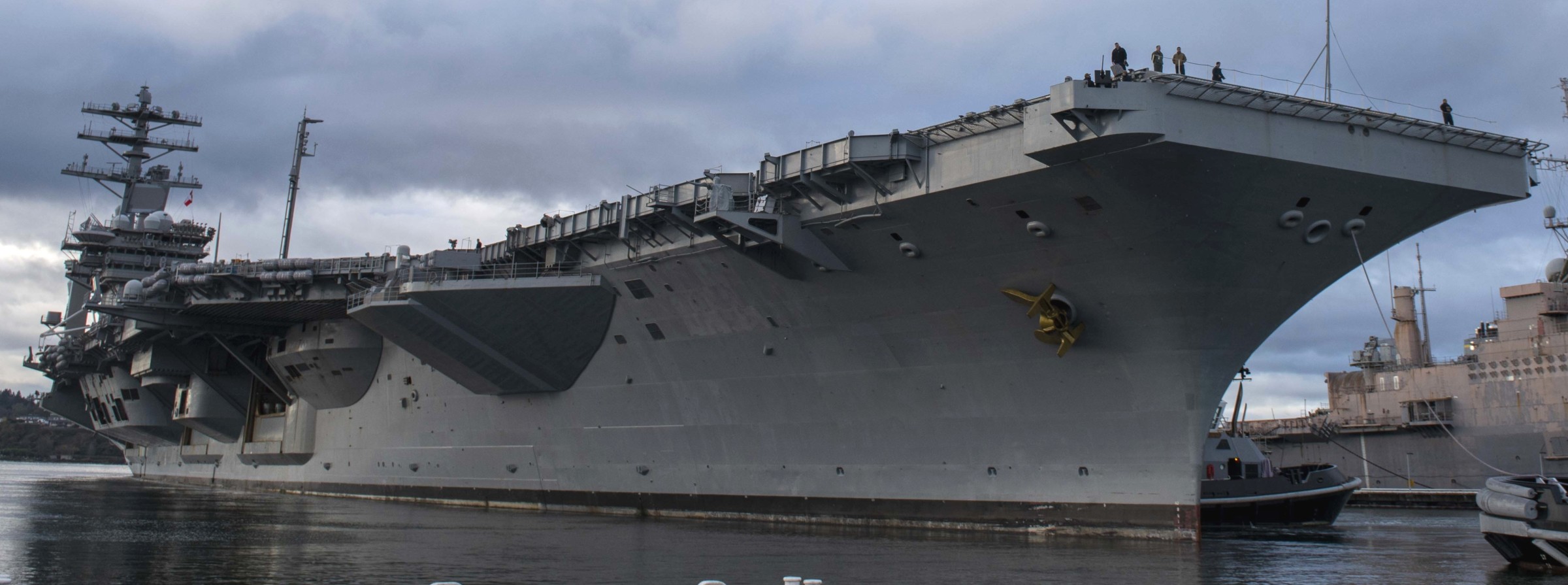 departing Naval Base Kitsap, Bremerton, Washington - November 28, 2022 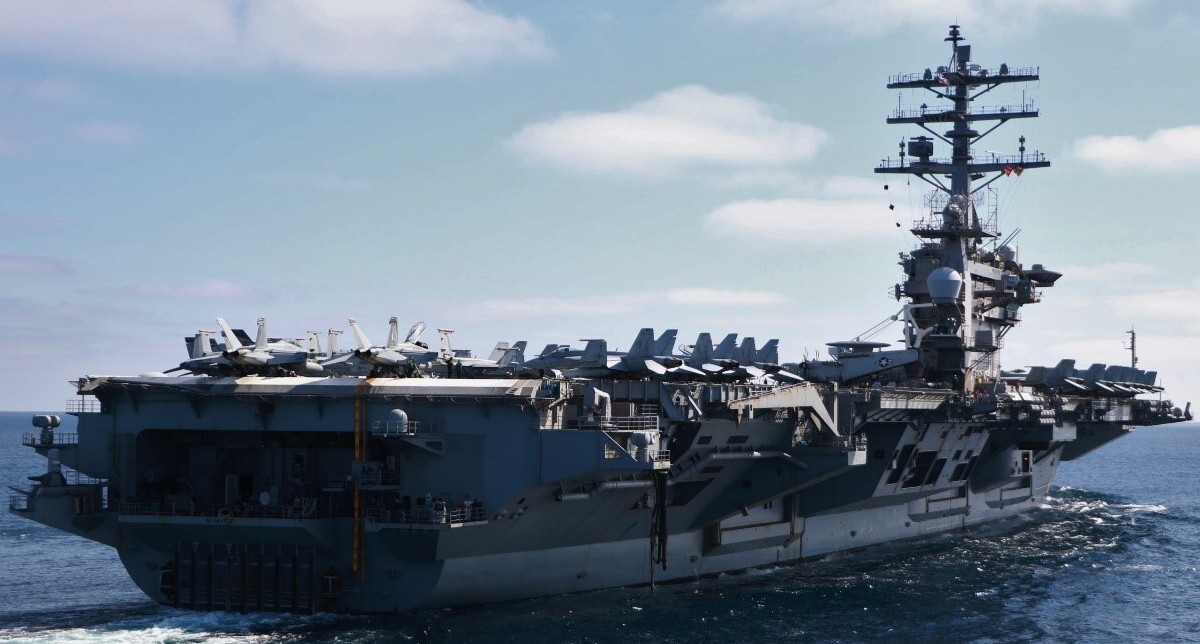 with CVW-17 embarked - Pacific Ocean - October 2022 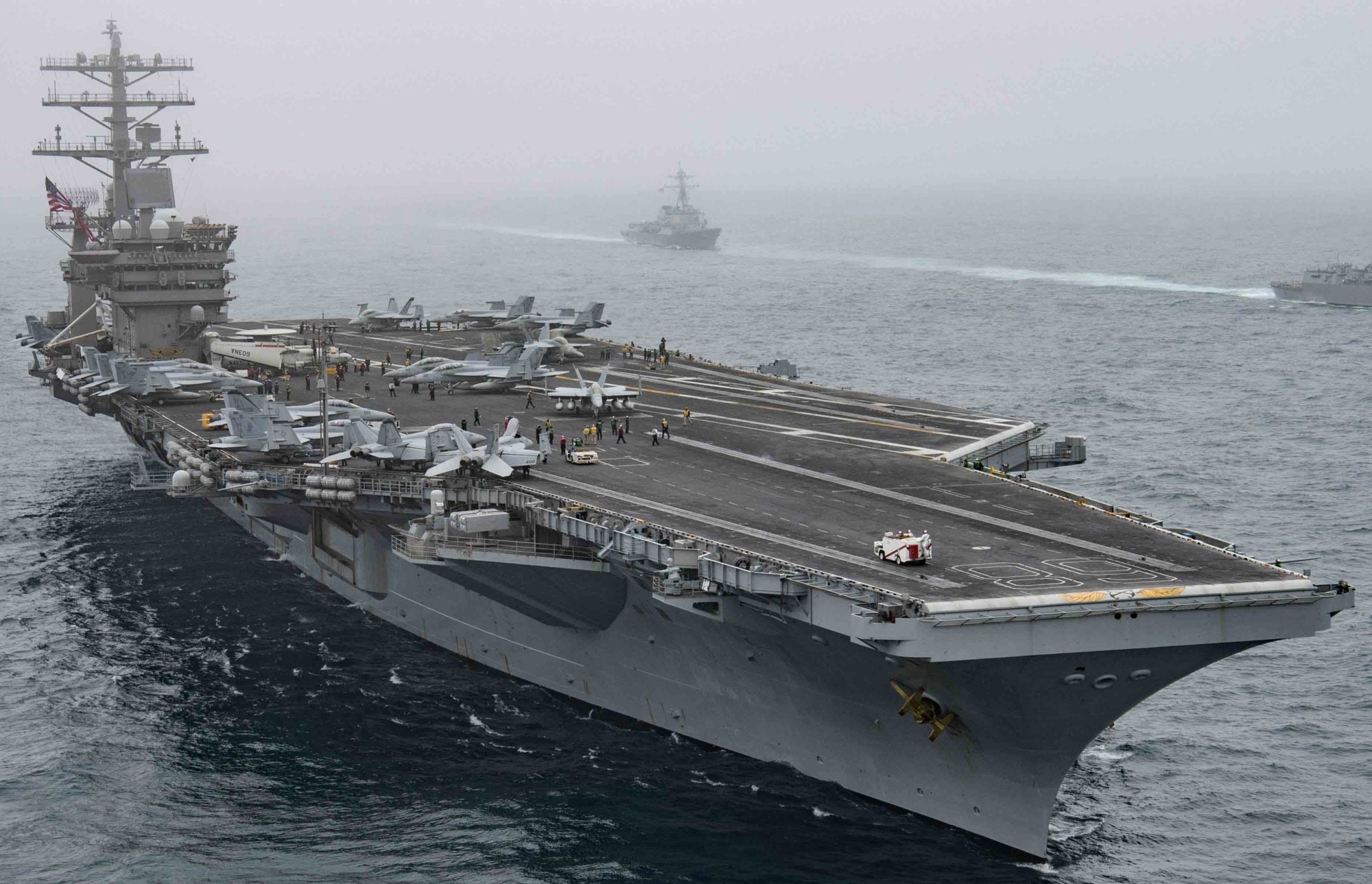 with CVW-17 embarked - Pacific Ocean - June 2022 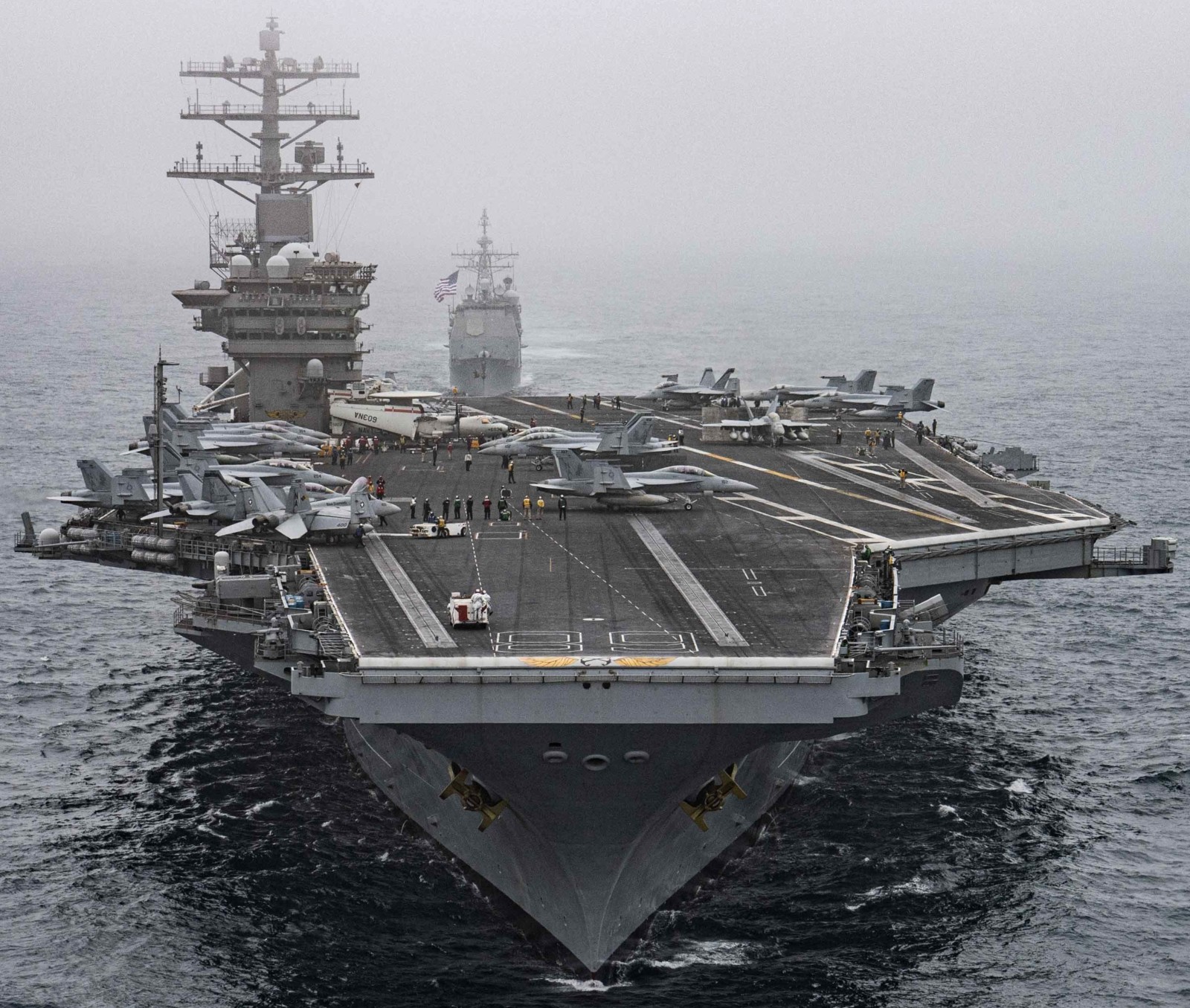 with CVW-17 embarked - Pacific Ocean - June 2022  Puget Sound, Washington - May 2022 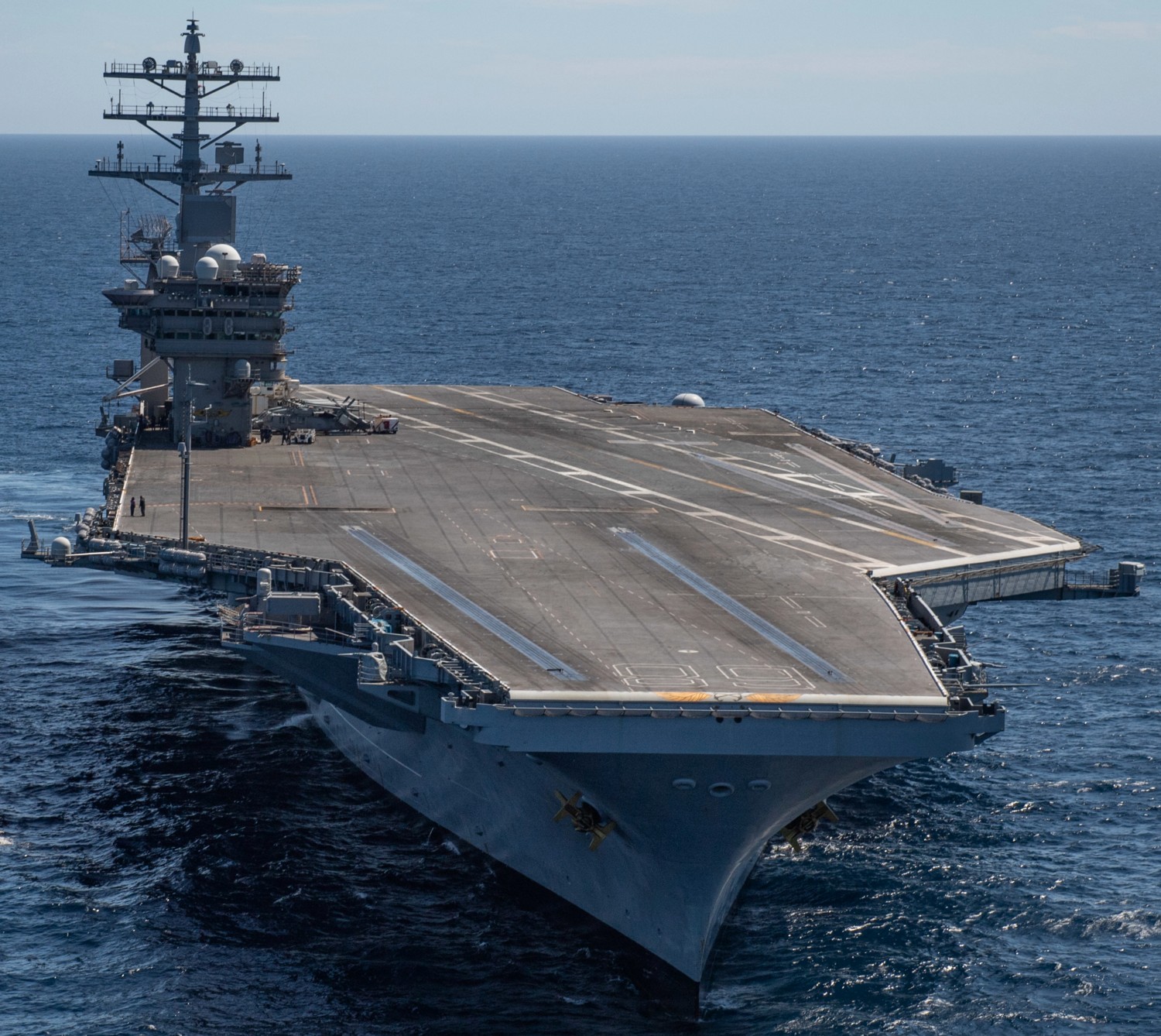 Pacific Ocean - March 2022 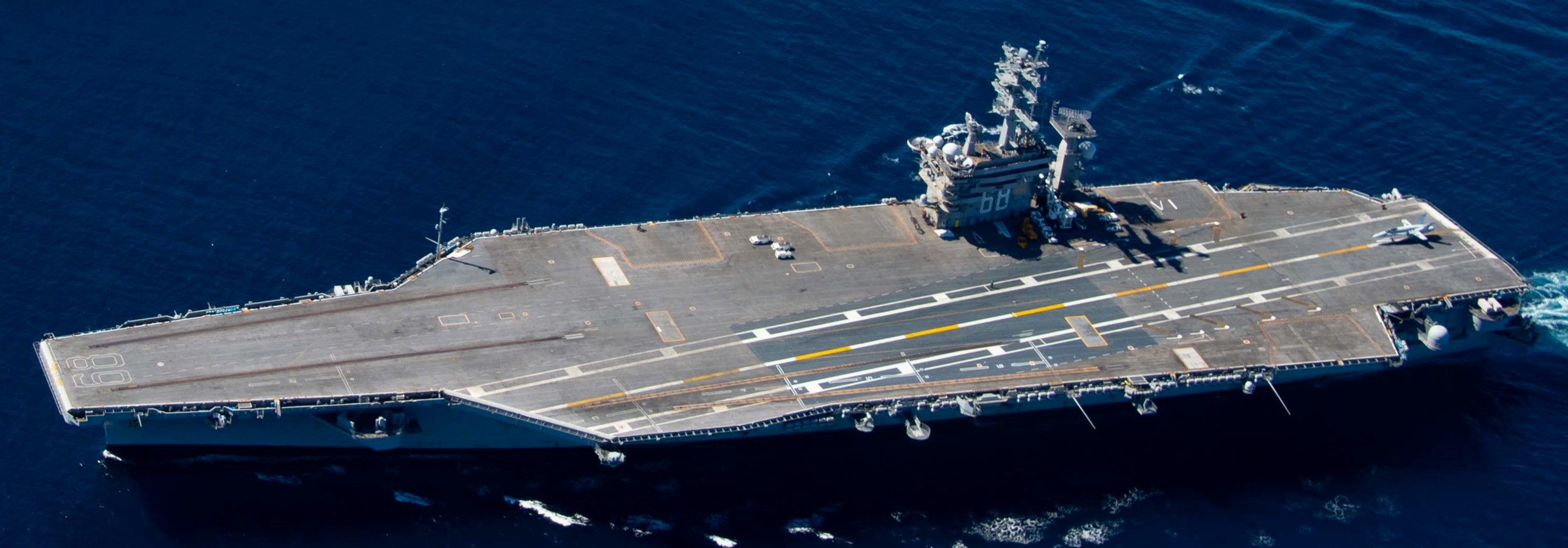 Pacific Ocean - February 2022 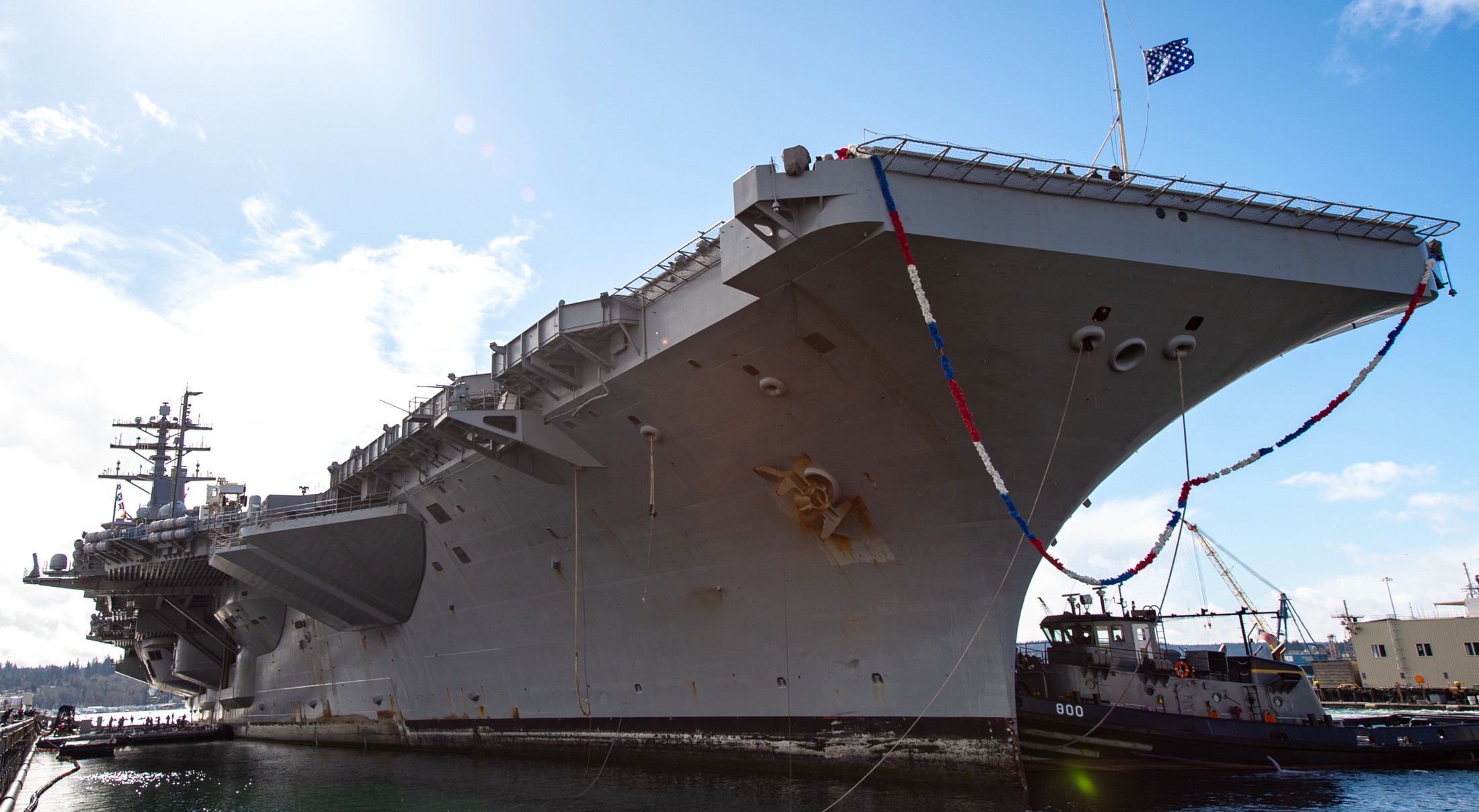 returning to Naval Base Kitsap, Bremerton, Washington - March 7, 2021 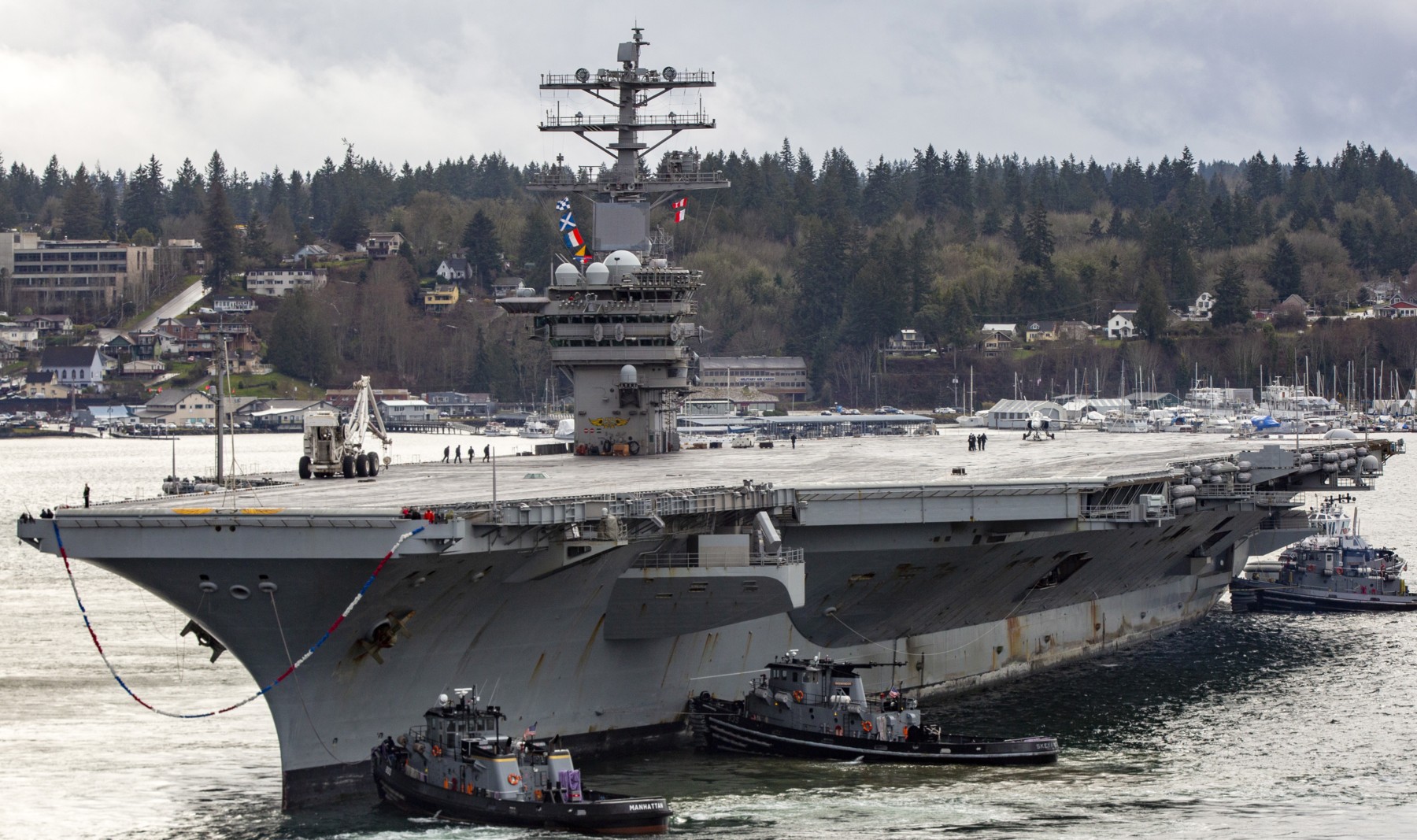 returning to Naval Base Kitsap, Bremerton, Washington - March 7, 2021 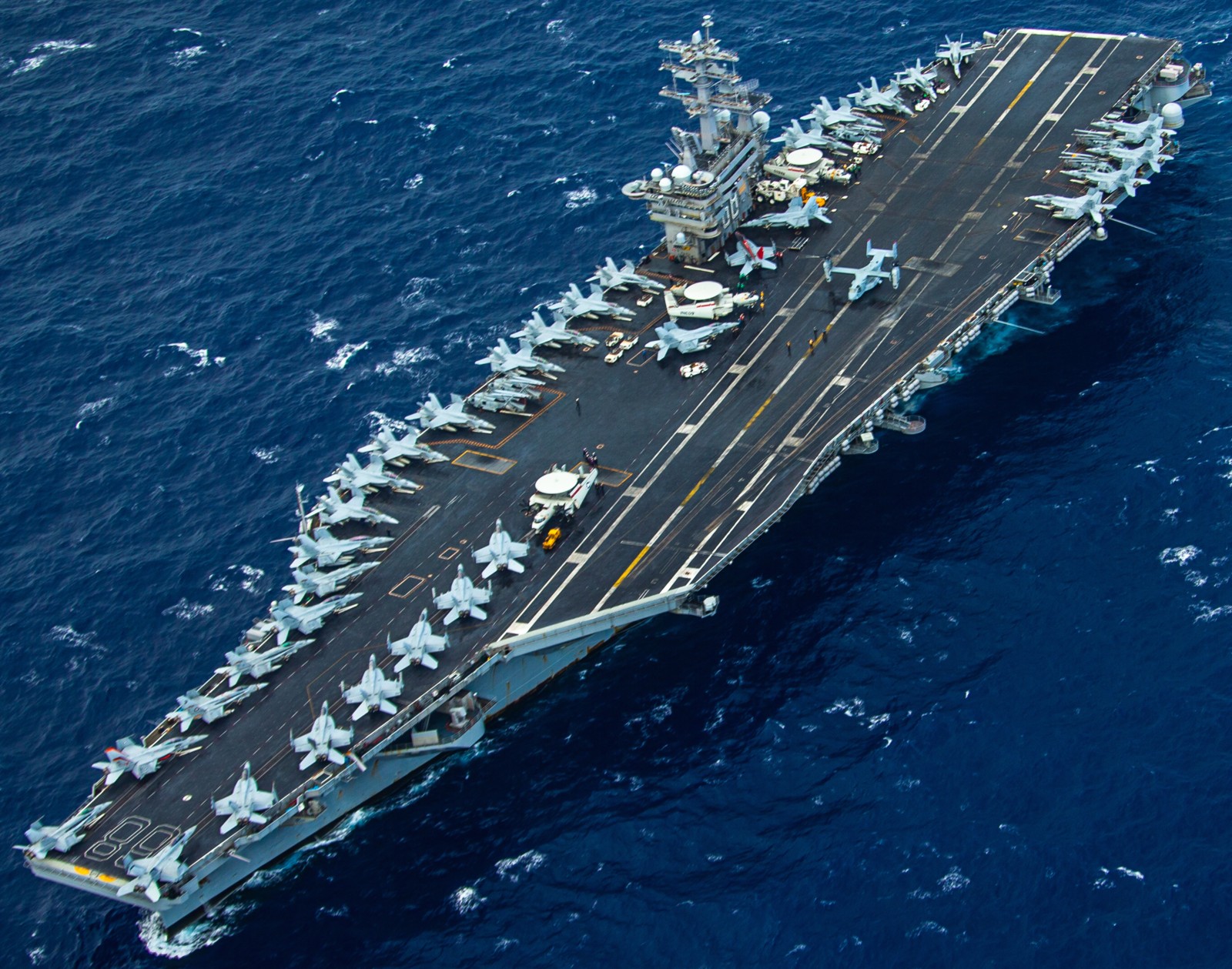 with CVW-17 embarked - Pacific Ocean - February 2021 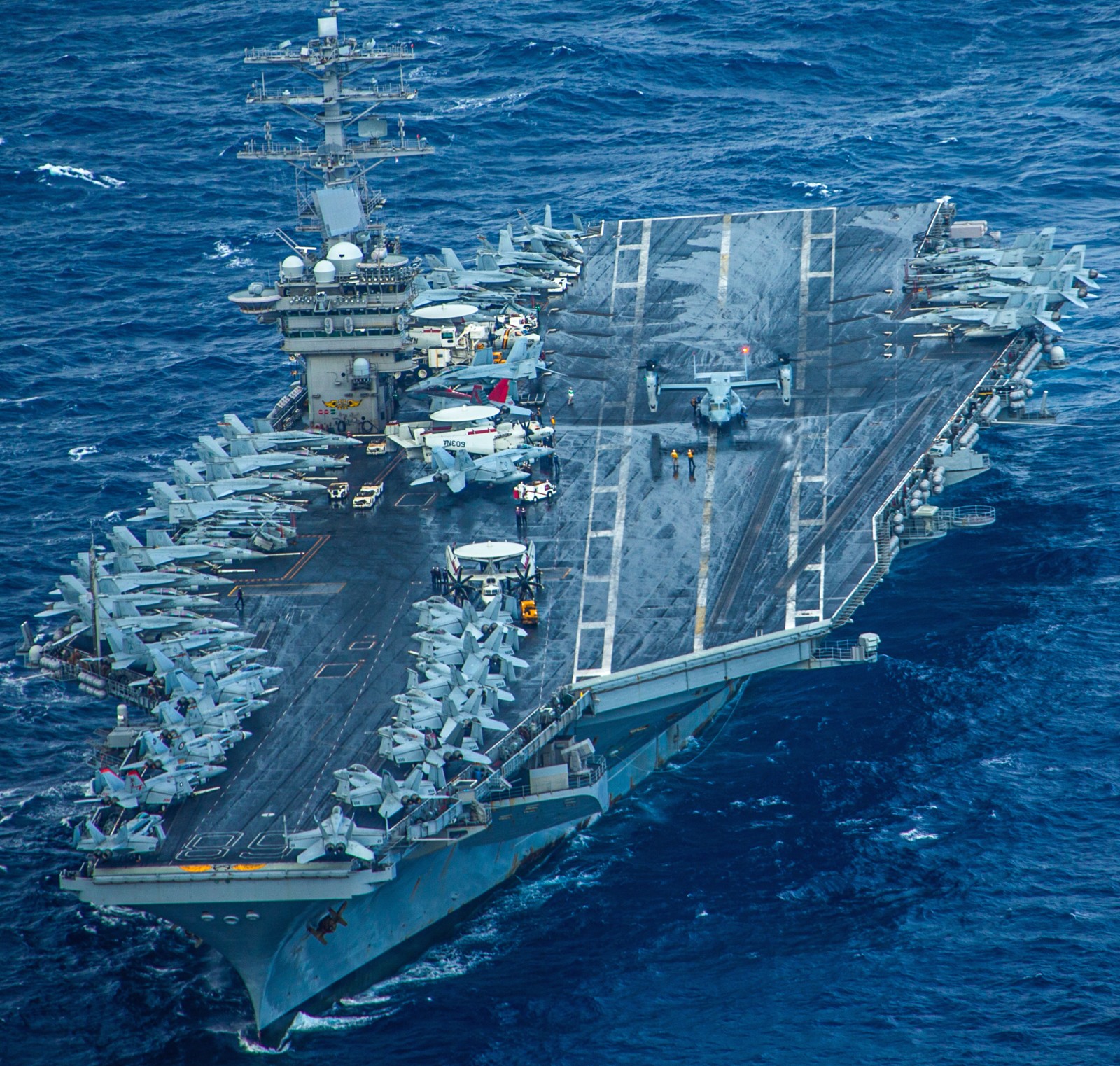 with CVW-17 embarked - Pacific Ocean - February 2021  with CVW-17 embarked - South China Sea - February 2021 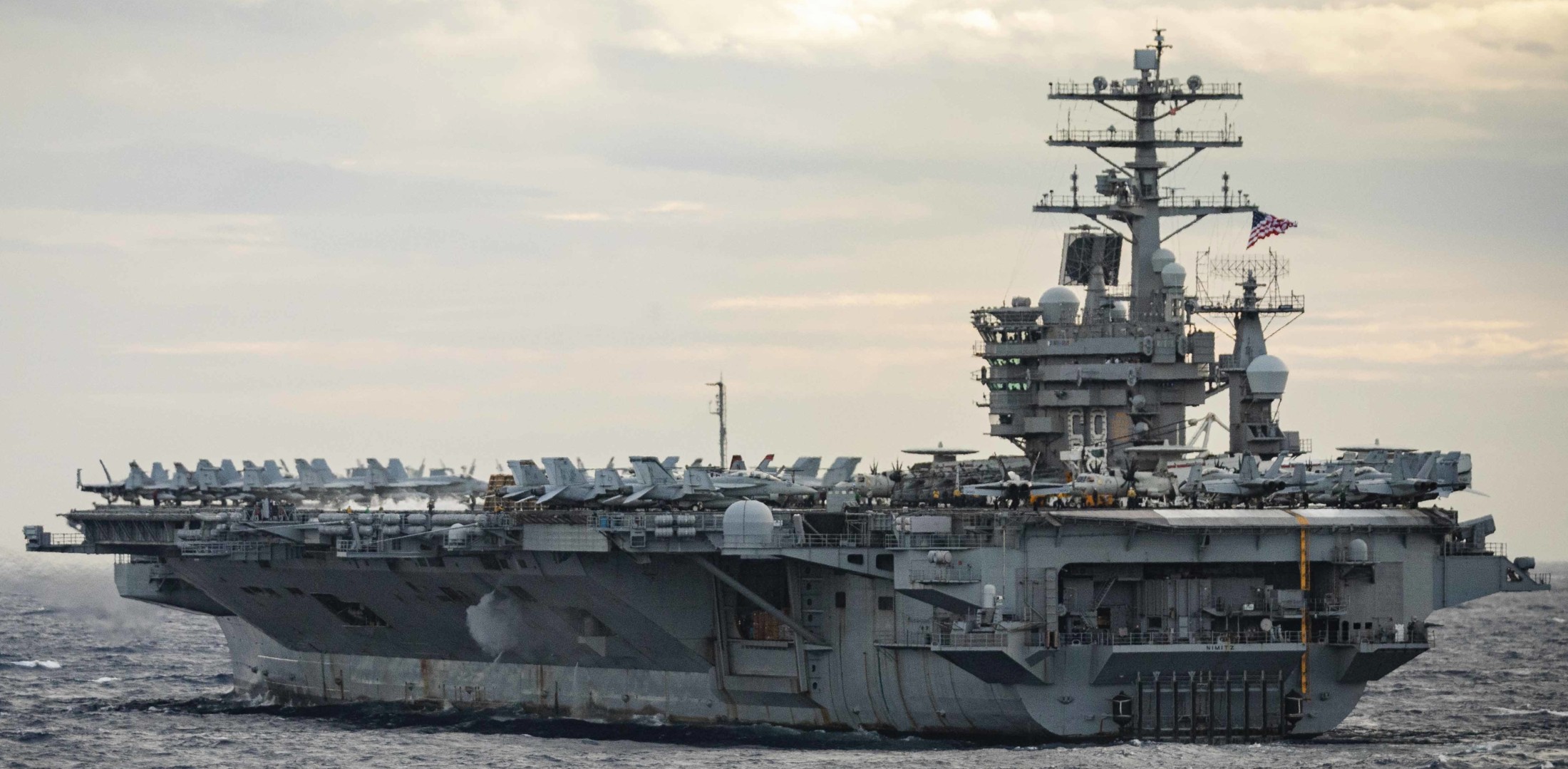 with CVW-17 embarked - South China Sea - February 2021  with CVW-17 embarked - Strait of Malacca - February 2021  with CVW-17 embarked - Strait of Malacca - February 2021 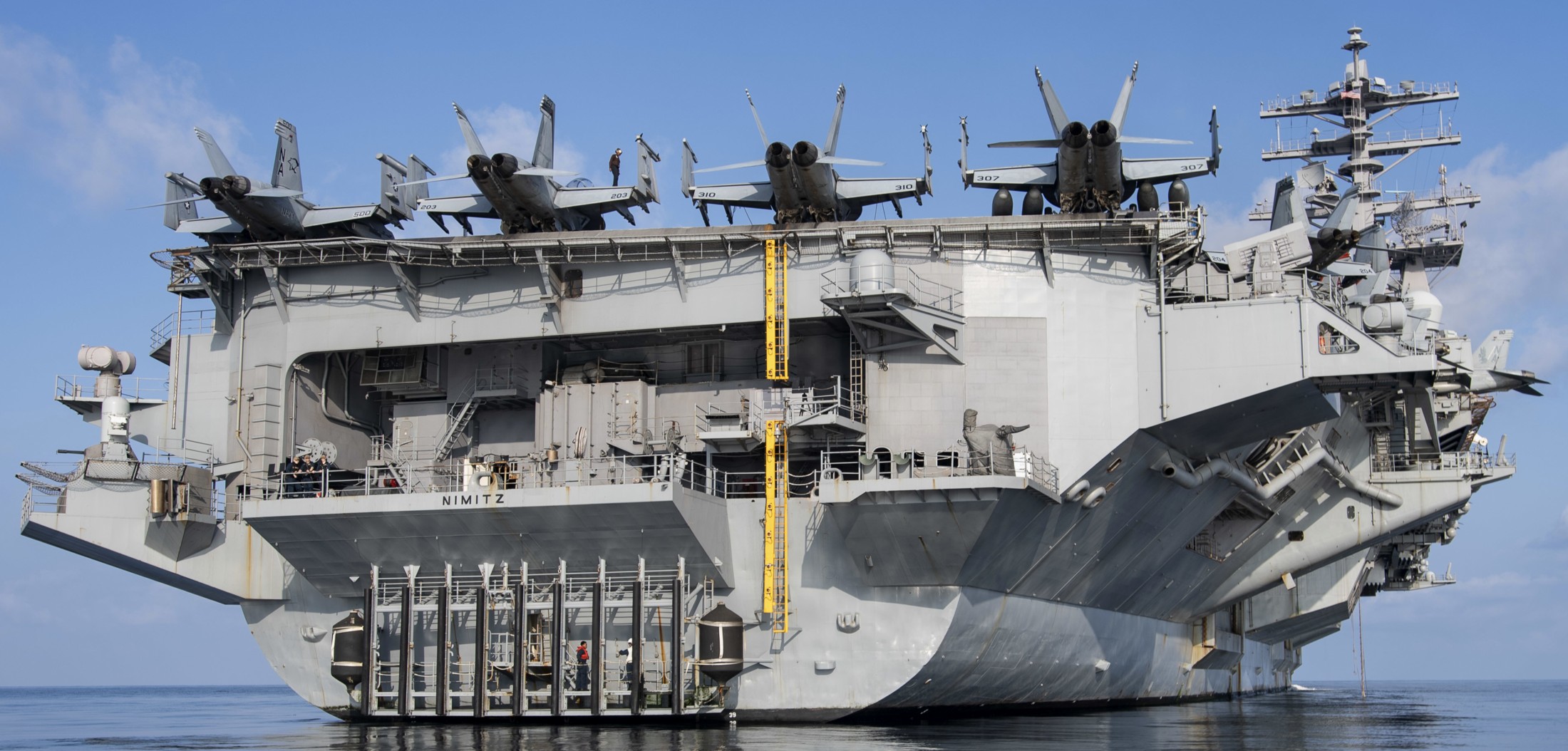 with CVW-17 embarked - Arabian Sea - December 2020 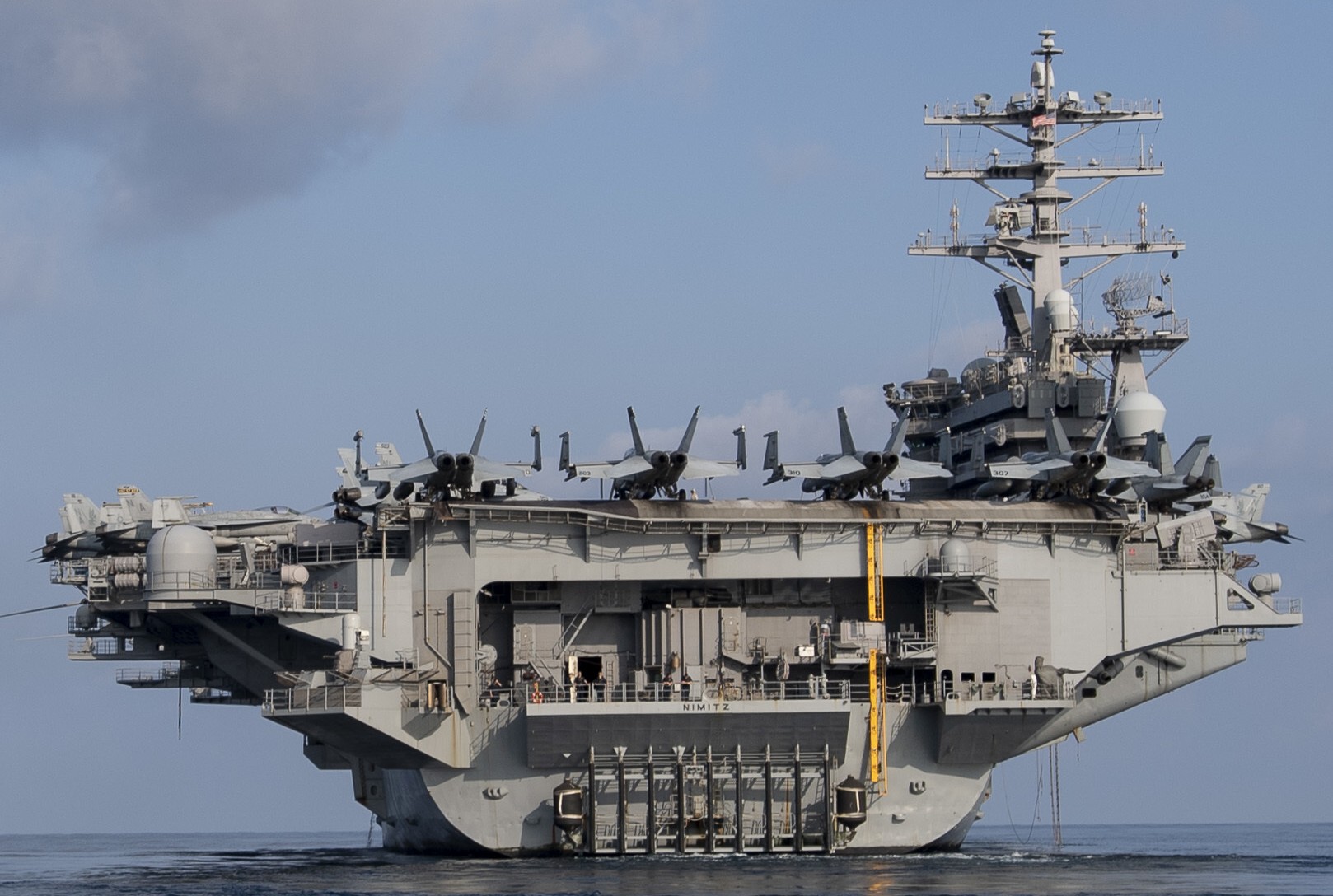 with CVW-17 embarked - Arabian Sea - December 2020 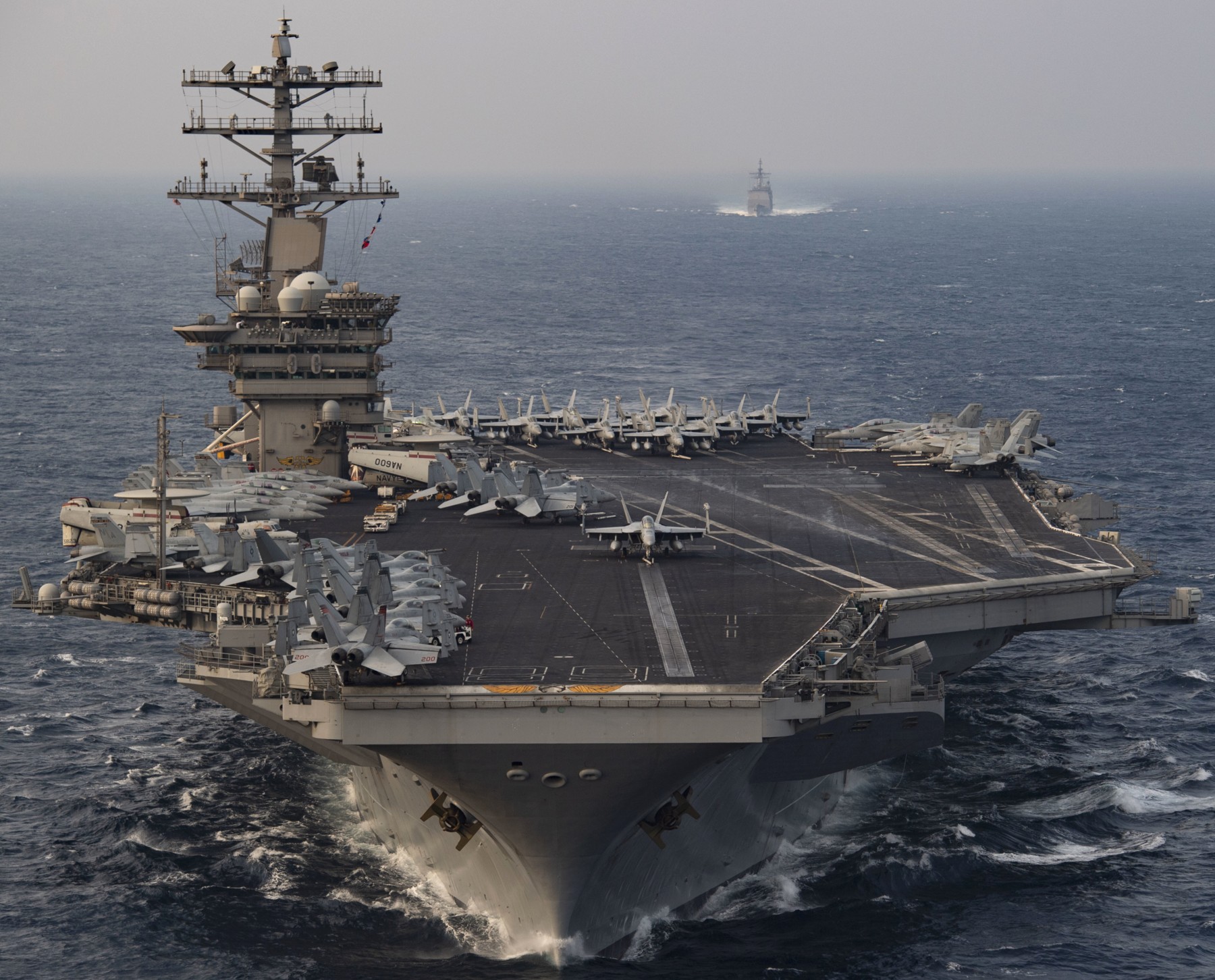 with CVW-17 embarked - exercise MALABAR, Arabian Sea - November 2020 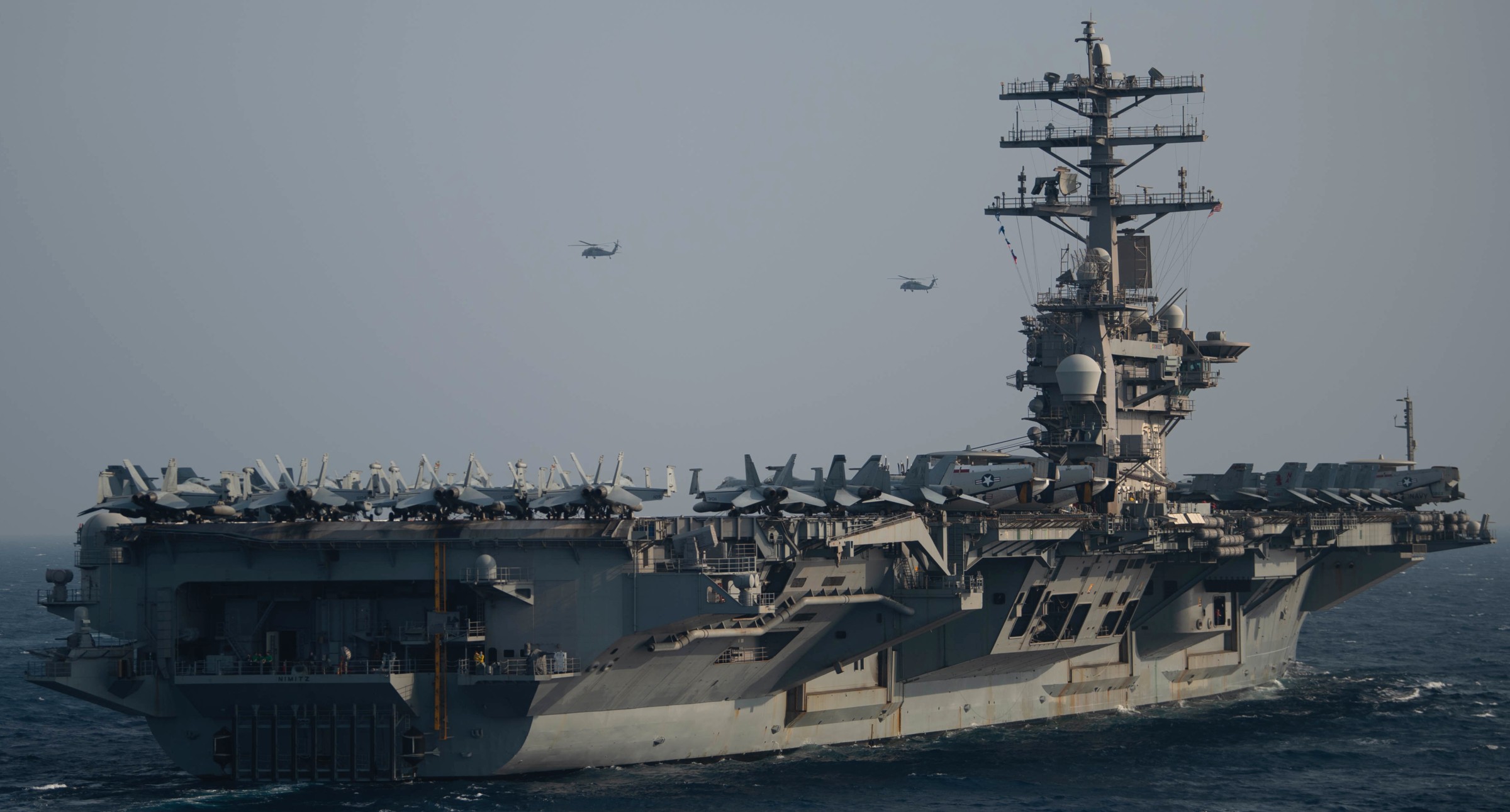 with CVW-17 embarked - exercise MALABAR, Arabian Sea - November 2020 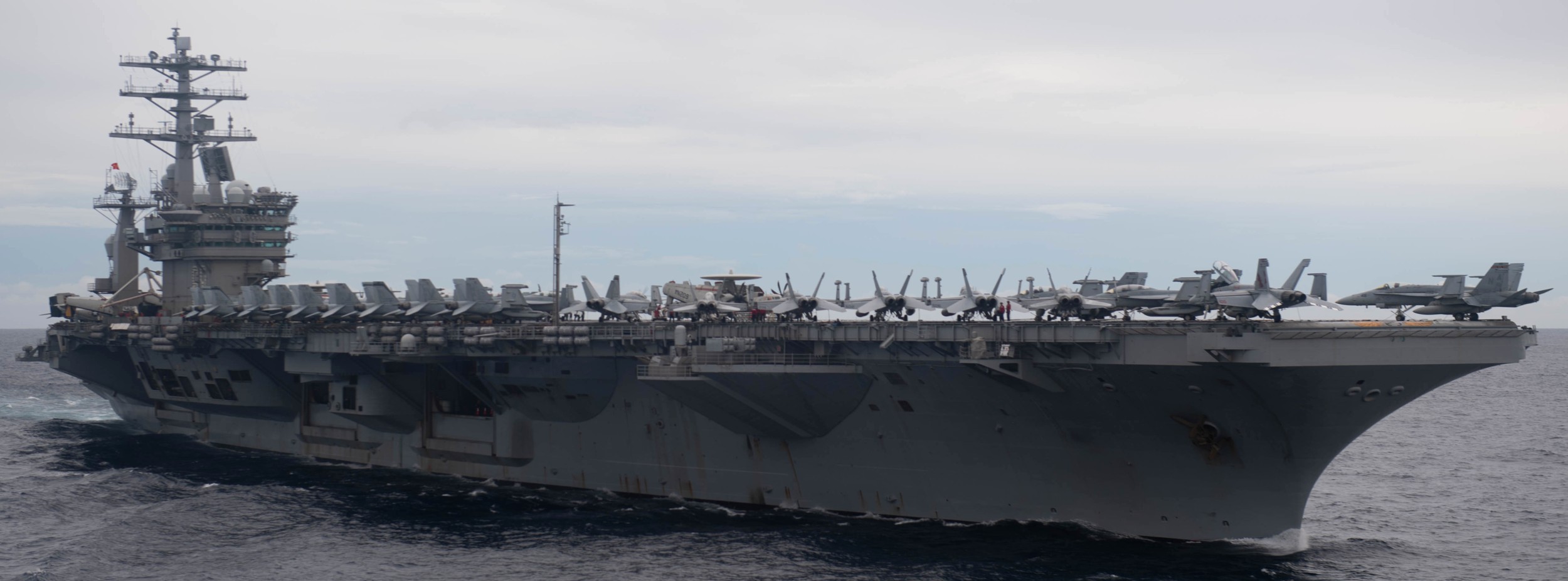 with CVW-17 embarked - exercise MALABAR, Arabian Sea - November 2020 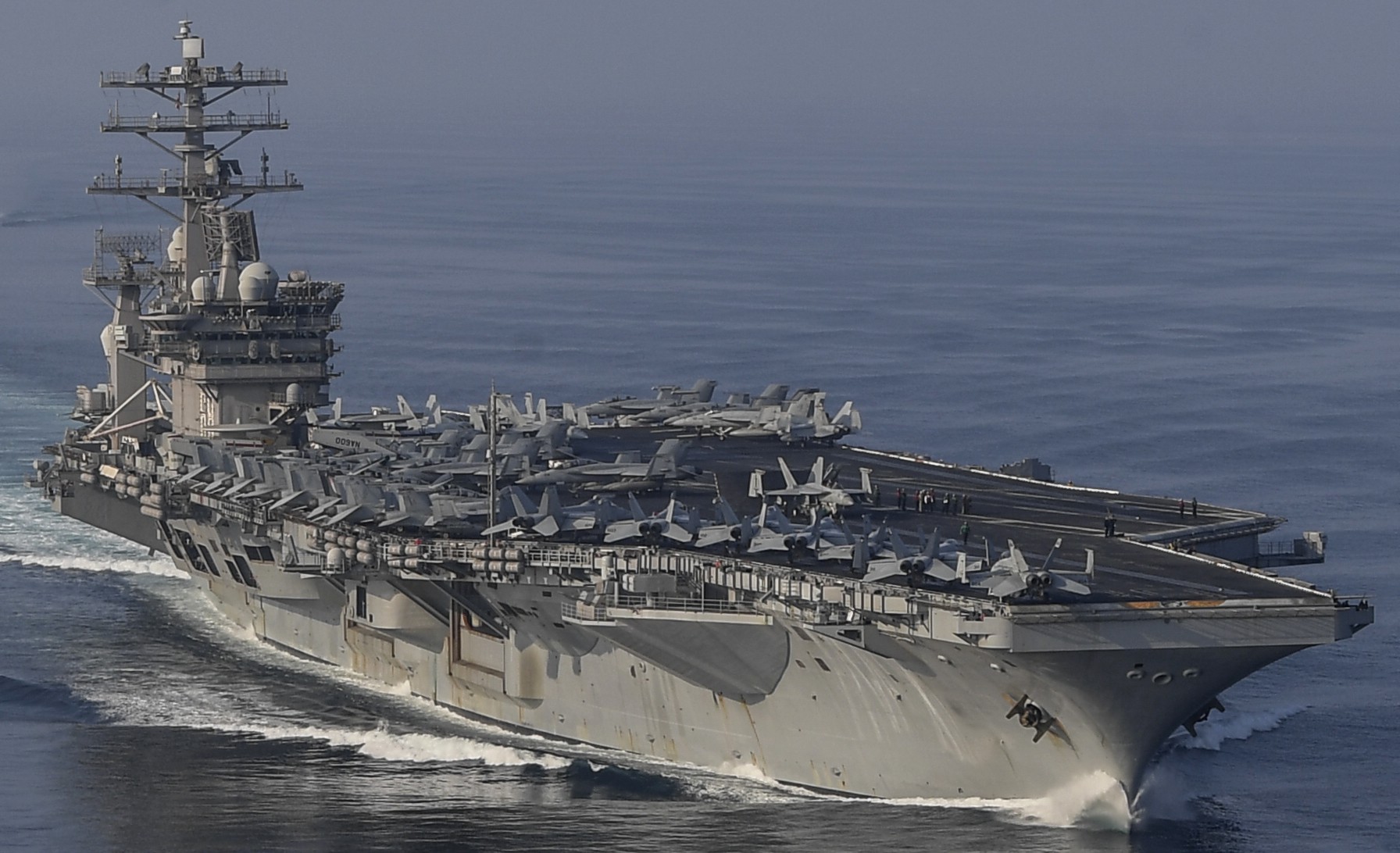 with CVW-17 embarked - Strait of Hormuz - November 2020 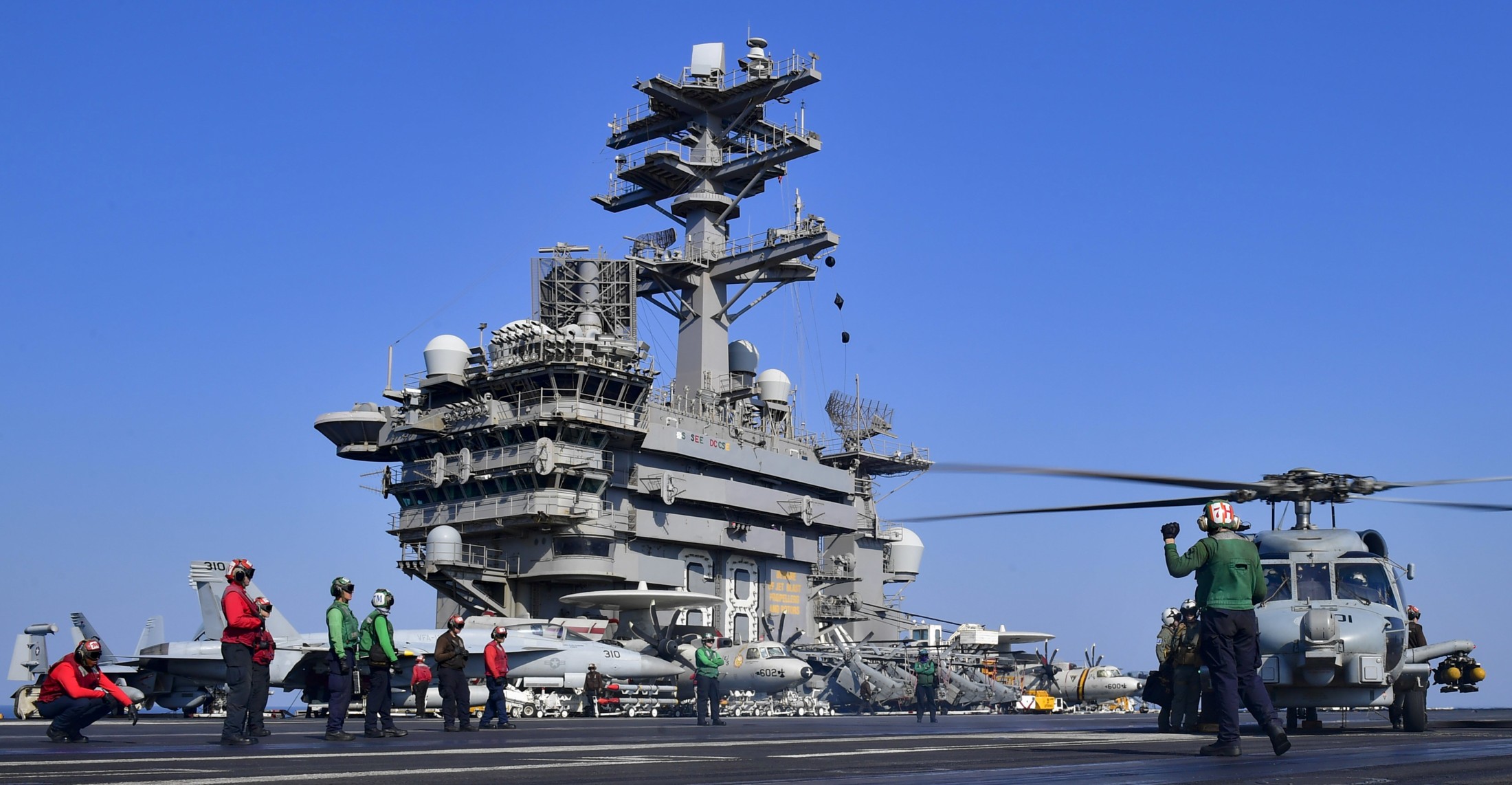 with CVW-17 embarked - Arabian Gulf - October 2020 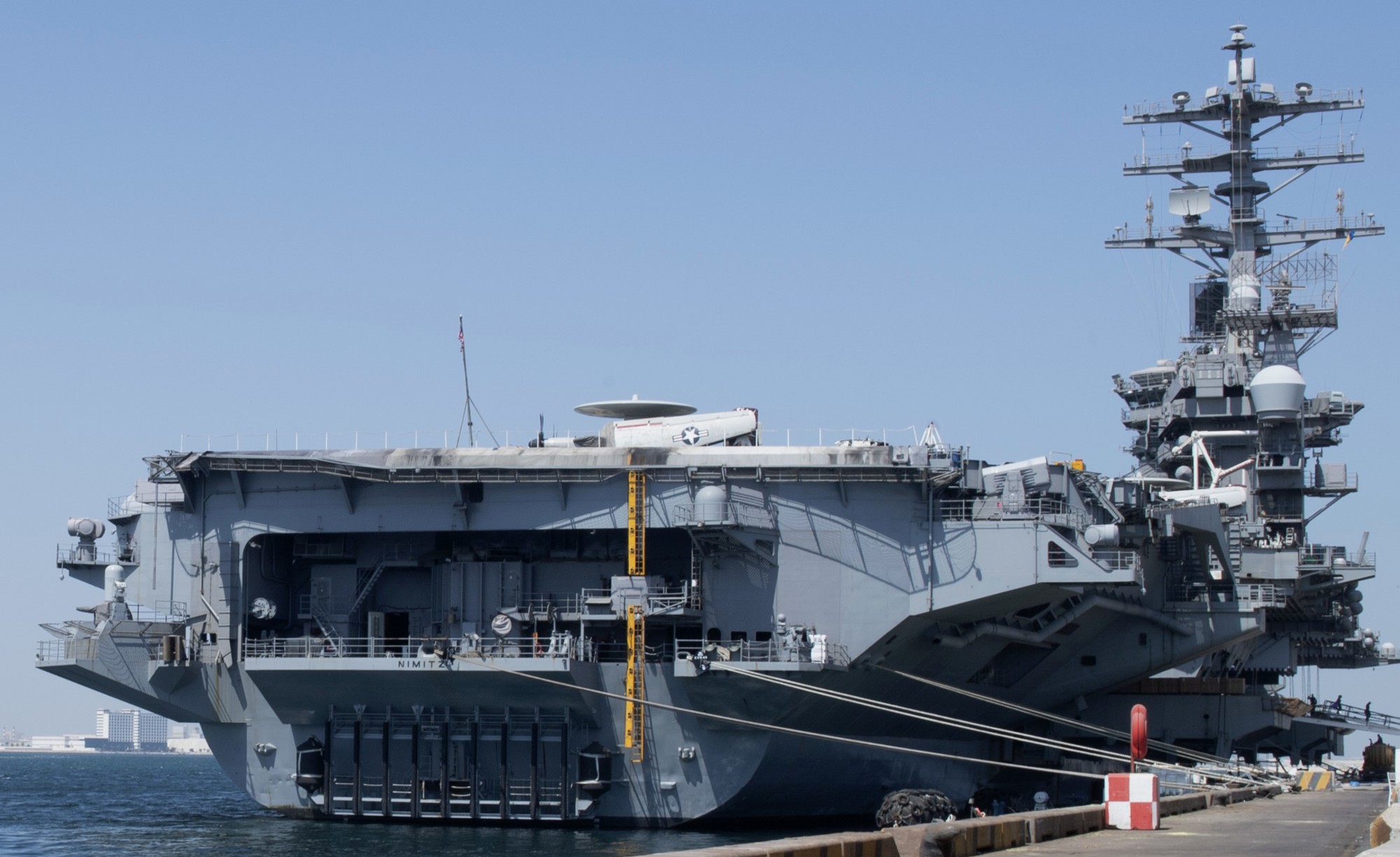 with CVW-17 embarked - Manama, Bahrain - October 2020 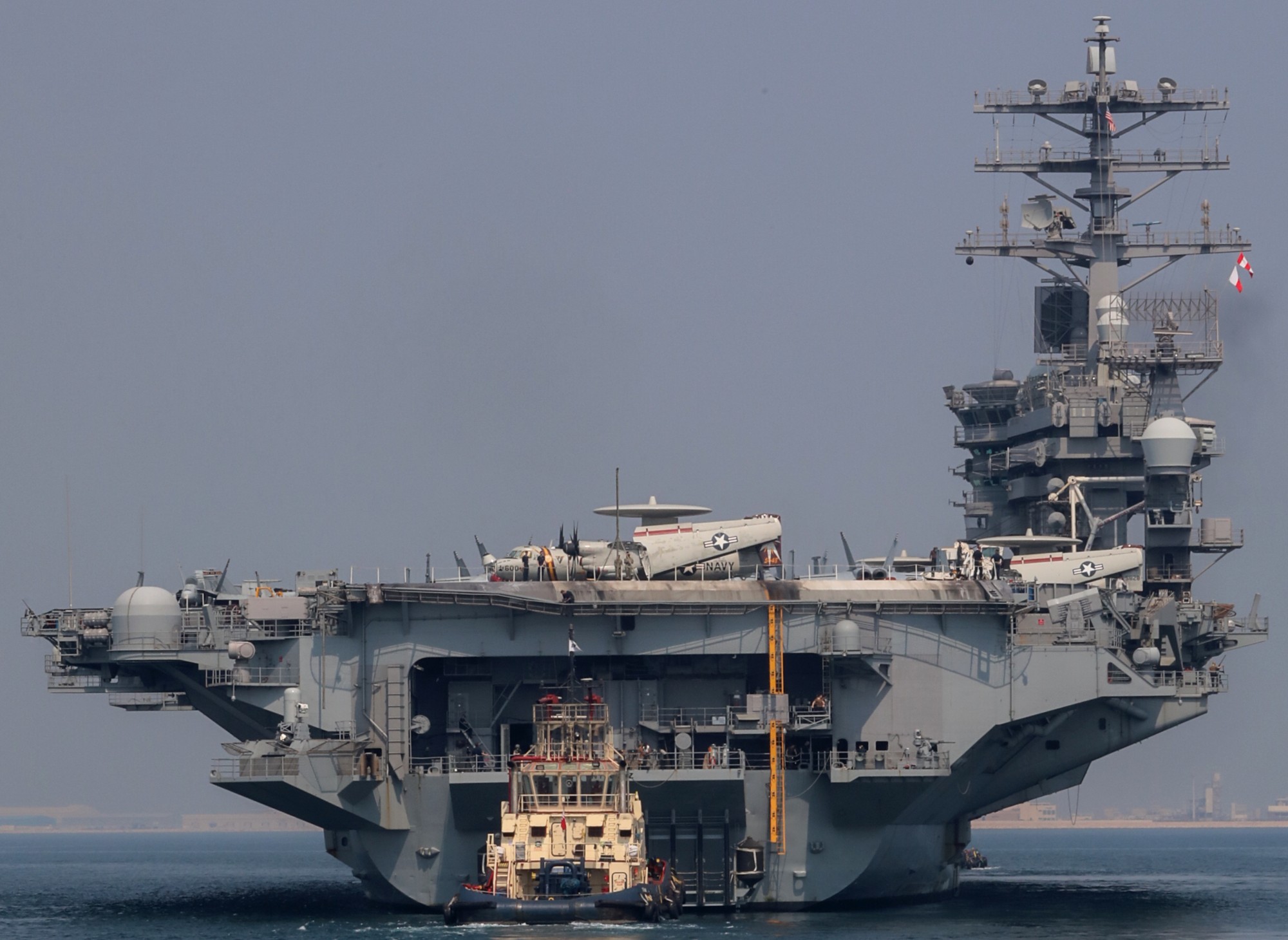 with CVW-17 embarked - Manama, Bahrain - October 2020 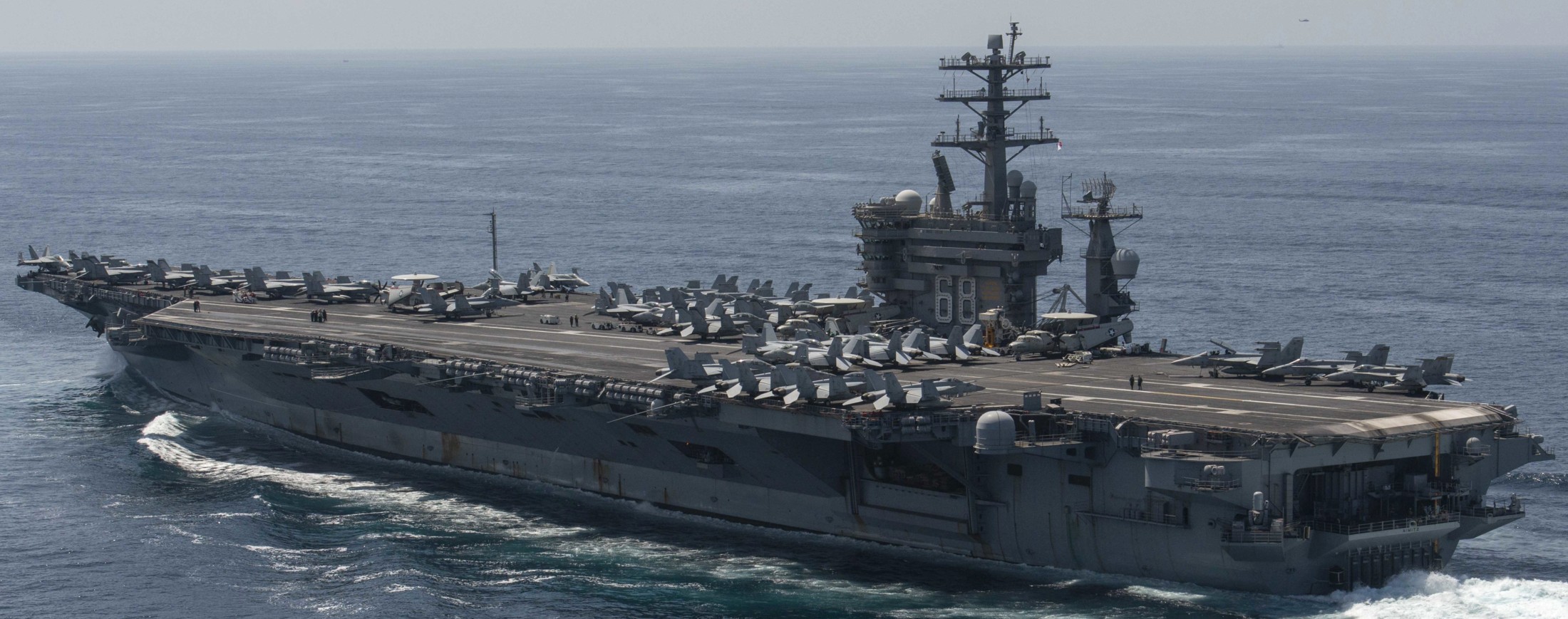 with CVW-17 embarked - Strait of Hormuz - September 2020  with CVW-17 embarked - Arabian Sea - August 2020  with CVW-17 embarked - Indian Ocean - July 2020 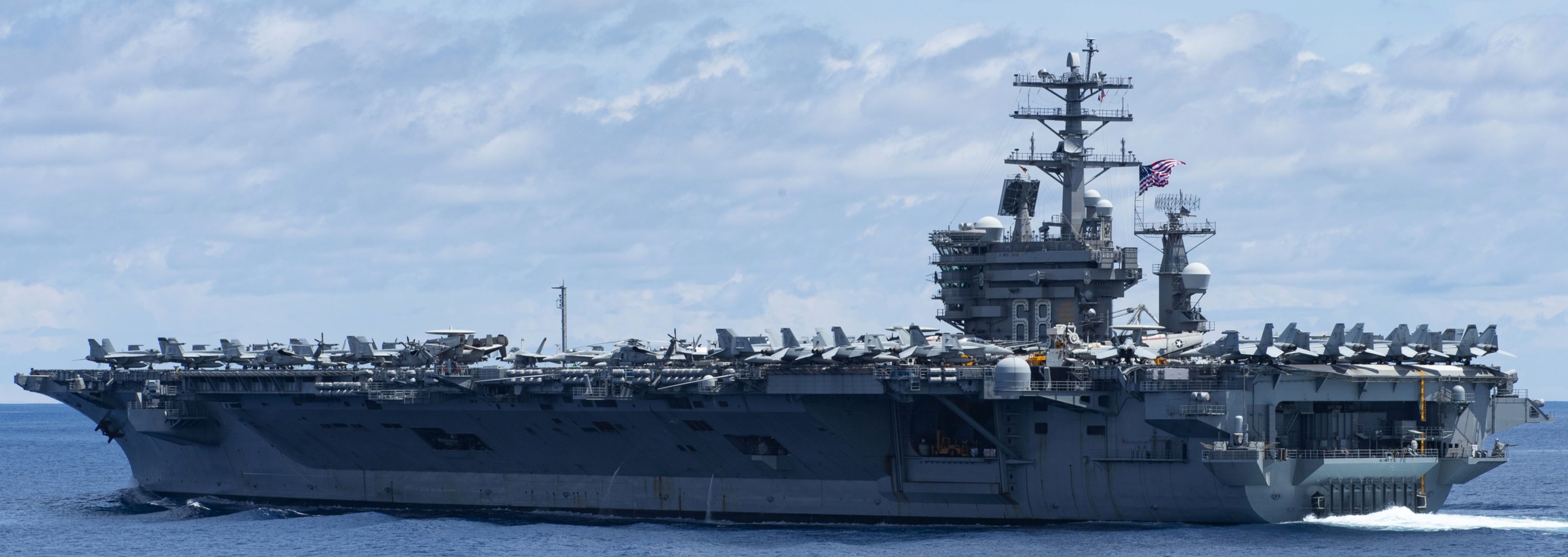 with CVW-17 embarked - Indian Ocean - July 2020  with CVW-17 embarked - Indian Ocean - July 2020 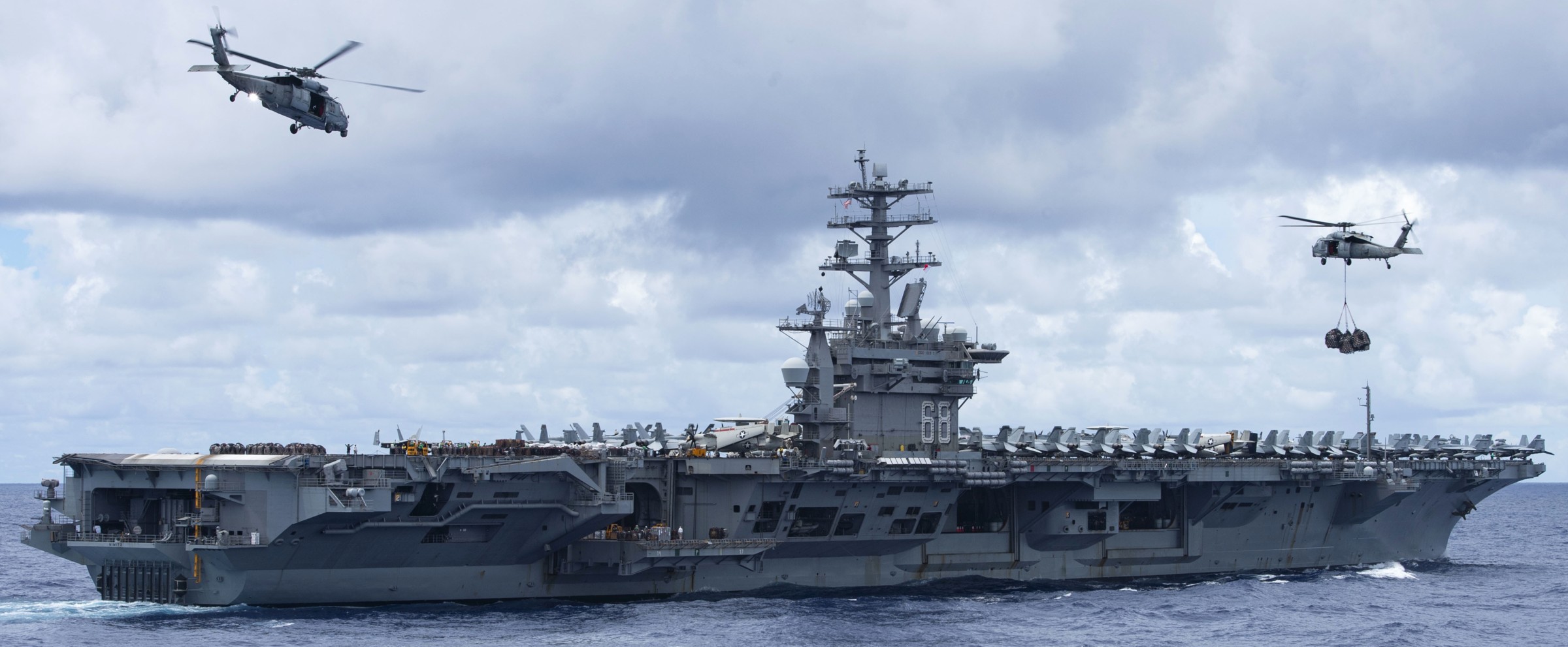 with CVW-17 embarked - Philippine Sea - July 2020 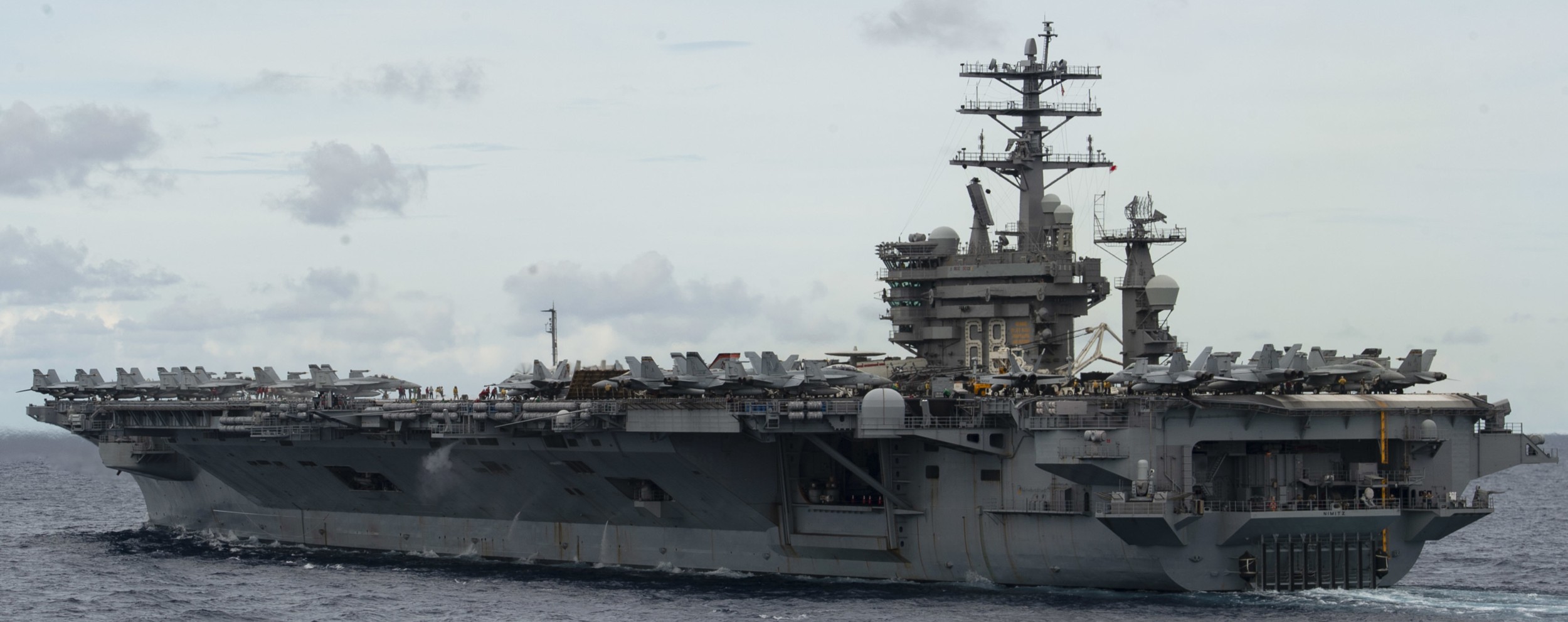 with CVW-17 embarked - South China Sea - July 2020  with CVW-17 embarked - South China Sea - July 2020  with CVW-17 embarked - South China Sea - July 2020 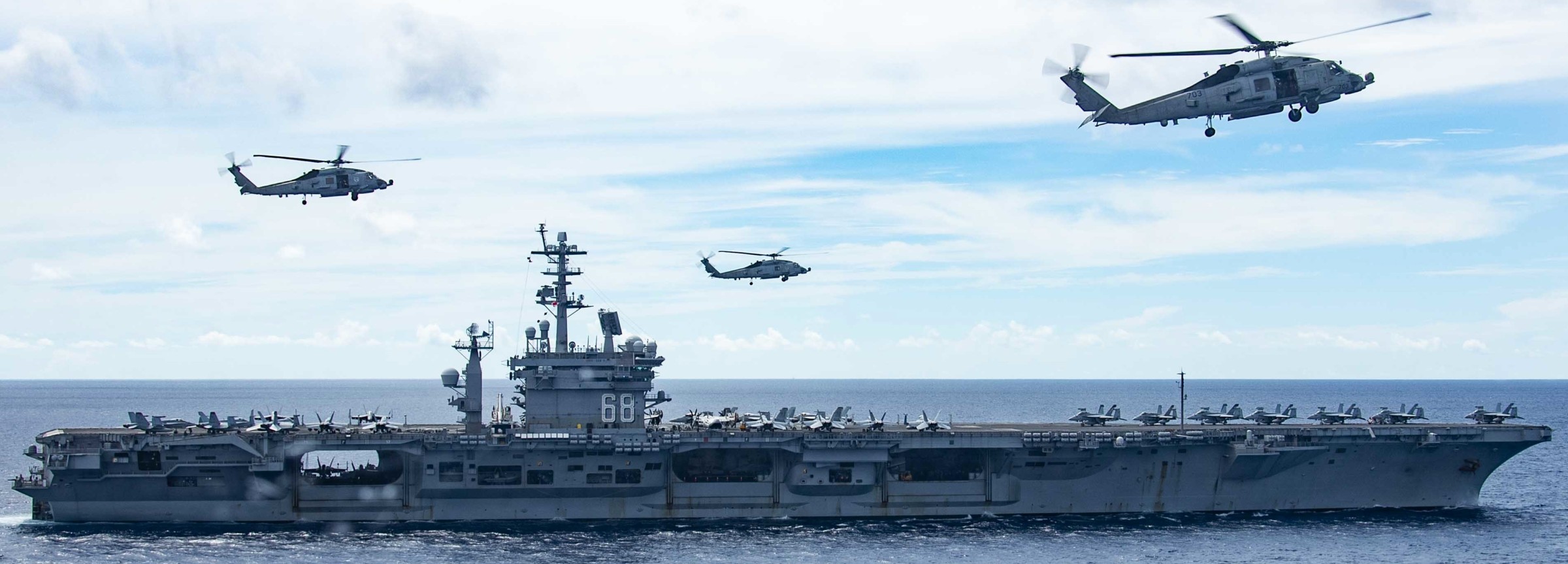 with CVW-17 embarked - South China Sea - July 2020  with CVW-17 embarked - Apra Harbor, Guam - June 2020  with CVW-17 embarked - Apra Harbor, Guam - June 2020  with CVW-17 embarked - departing NAS North Island, San Diego, California - June 8, 2020  with CVW-17 embarked - departing NAS North Island, San Diego, California - June 8, 2020 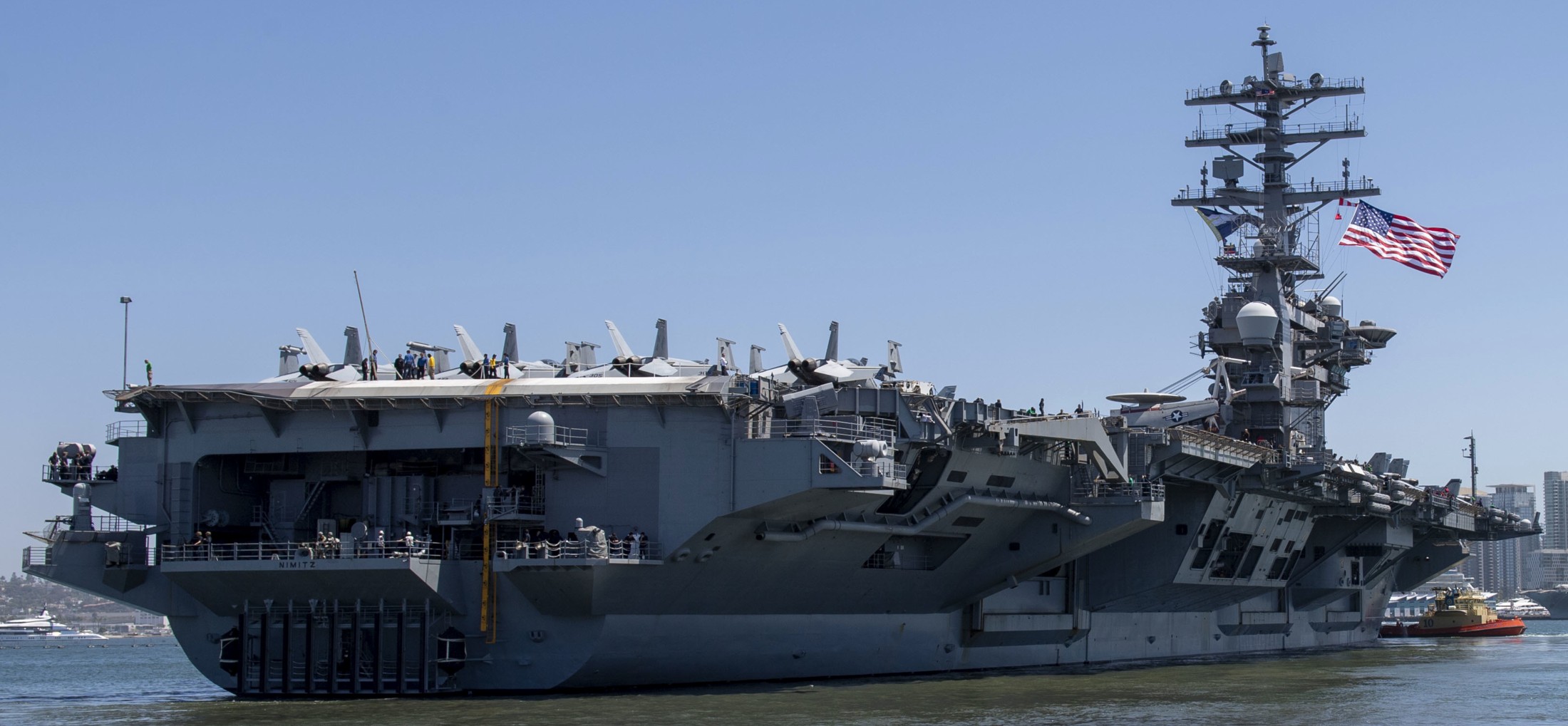 with CVW-17 embarked - departing NAS North Island, San Diego, California - June 8, 2020 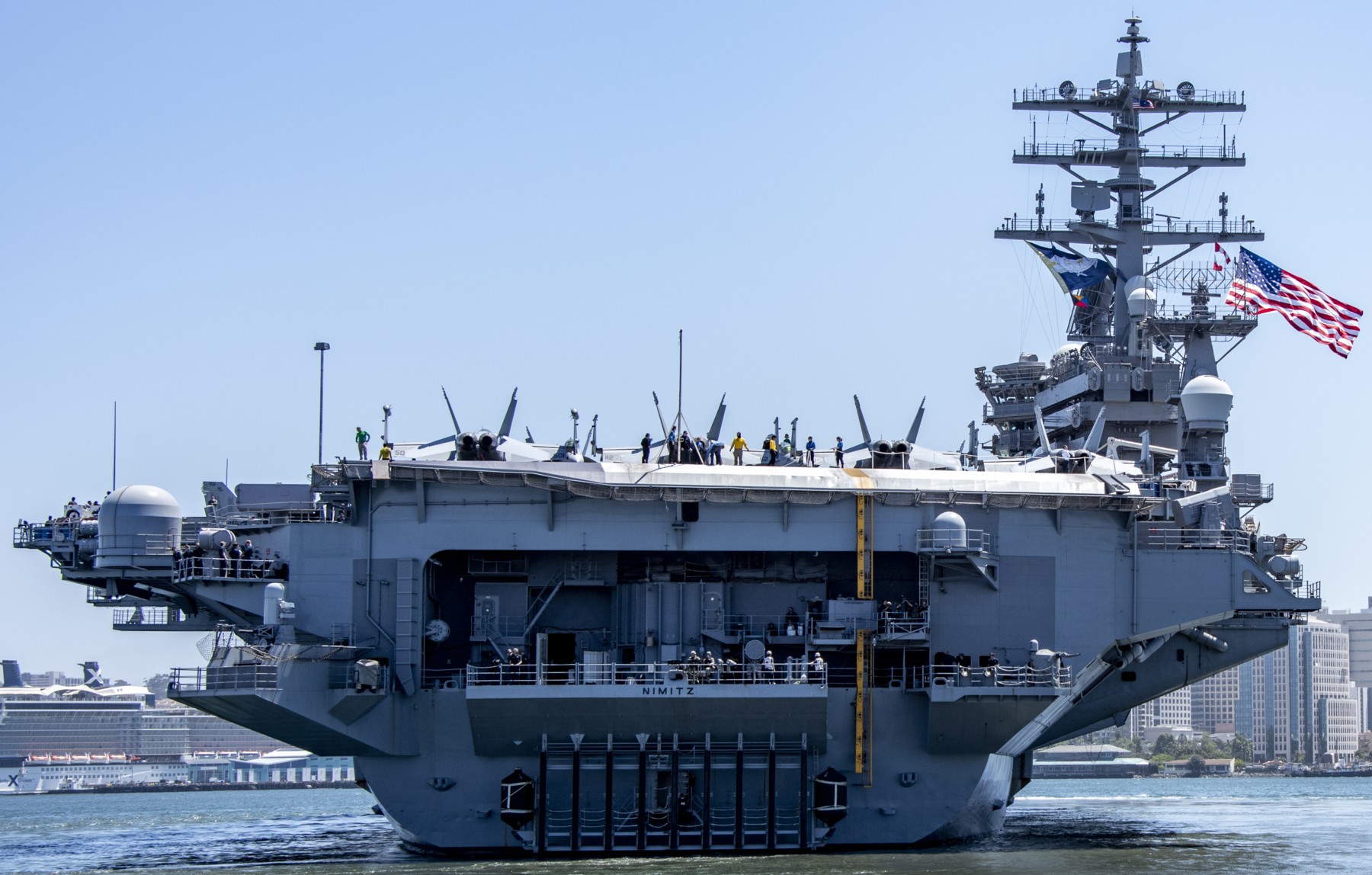 with CVW-17 embarked - departing NAS North Island, San Diego, California - June 8, 2020  with CVW-17 embarked - COMPTUEX, Pacific Ocean - June 2020  with CVW-17 embarked - COMPTUEX, Pacific Ocean - May 2020  Seattle, Washington - February 2020 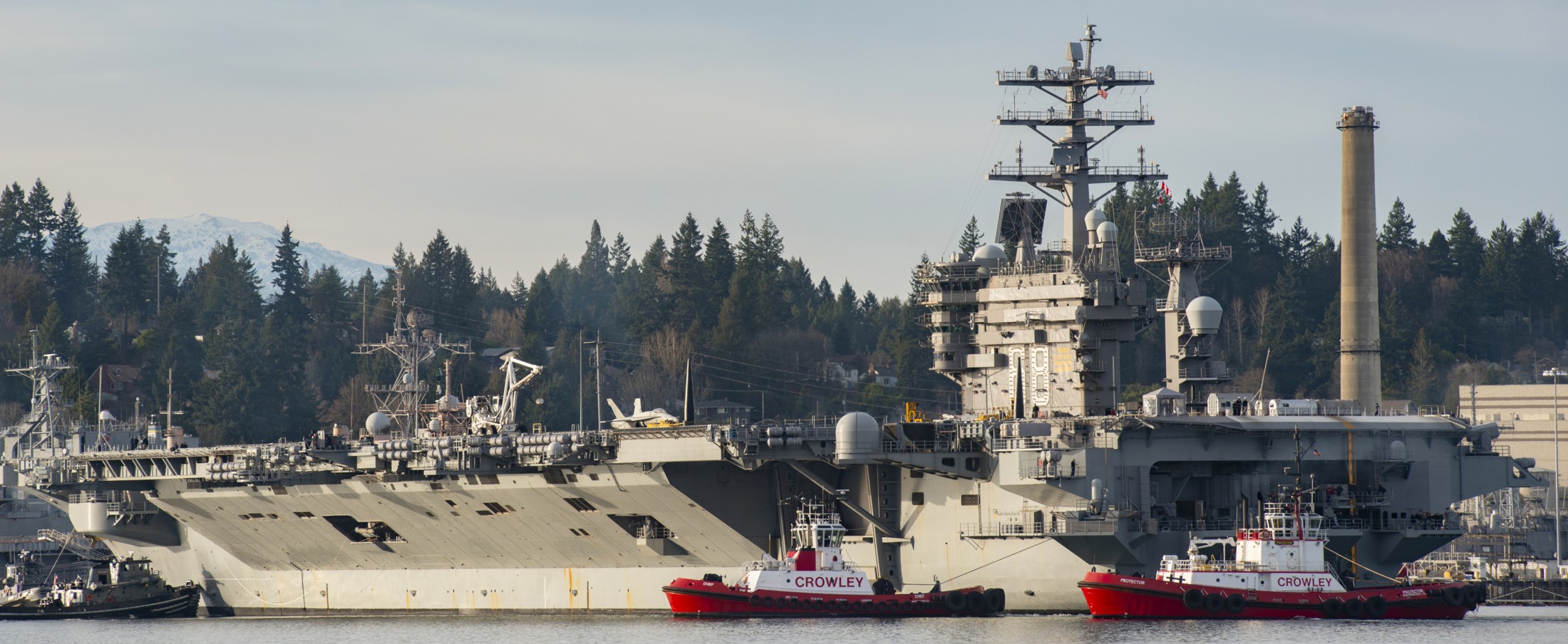 arriving at Naval Base Kitsap, Bremerton, Washington - February 2020 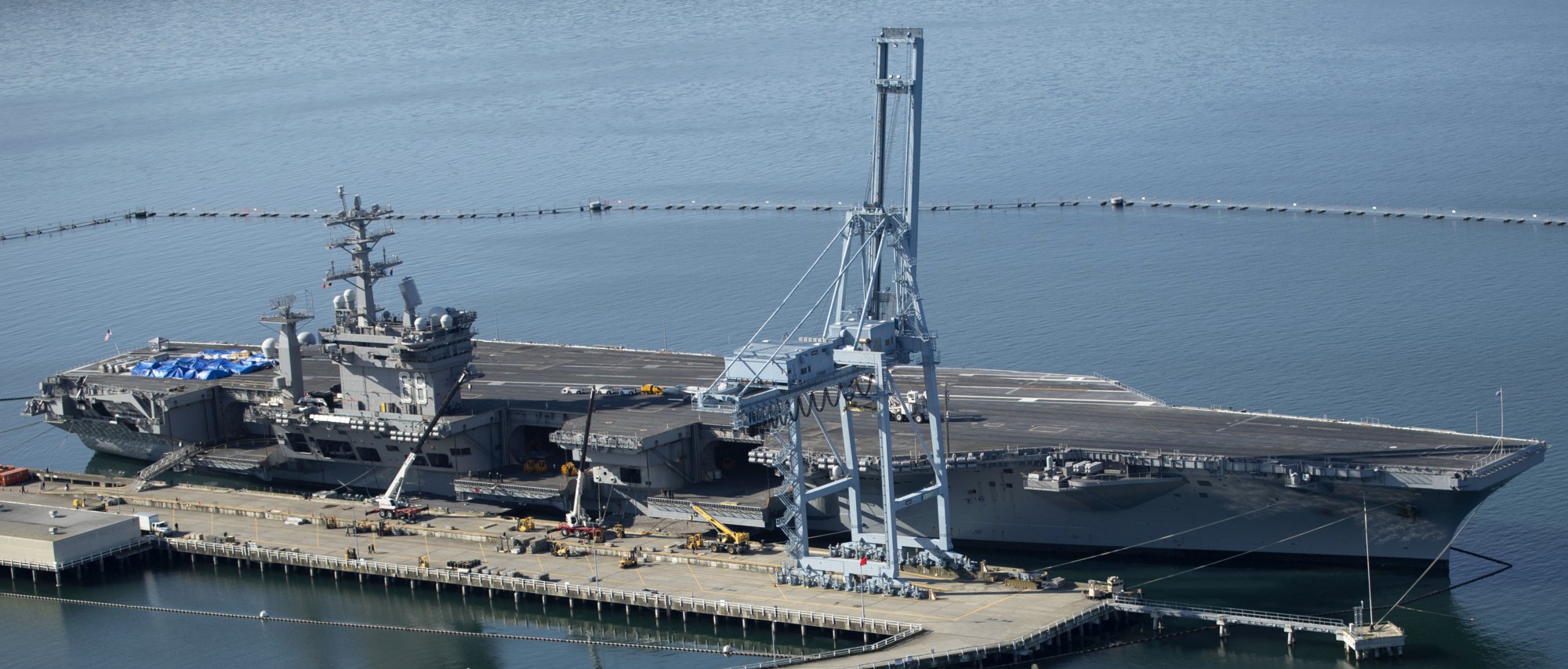 moored at Naval Magazine Indian Island, Washington - February 2020 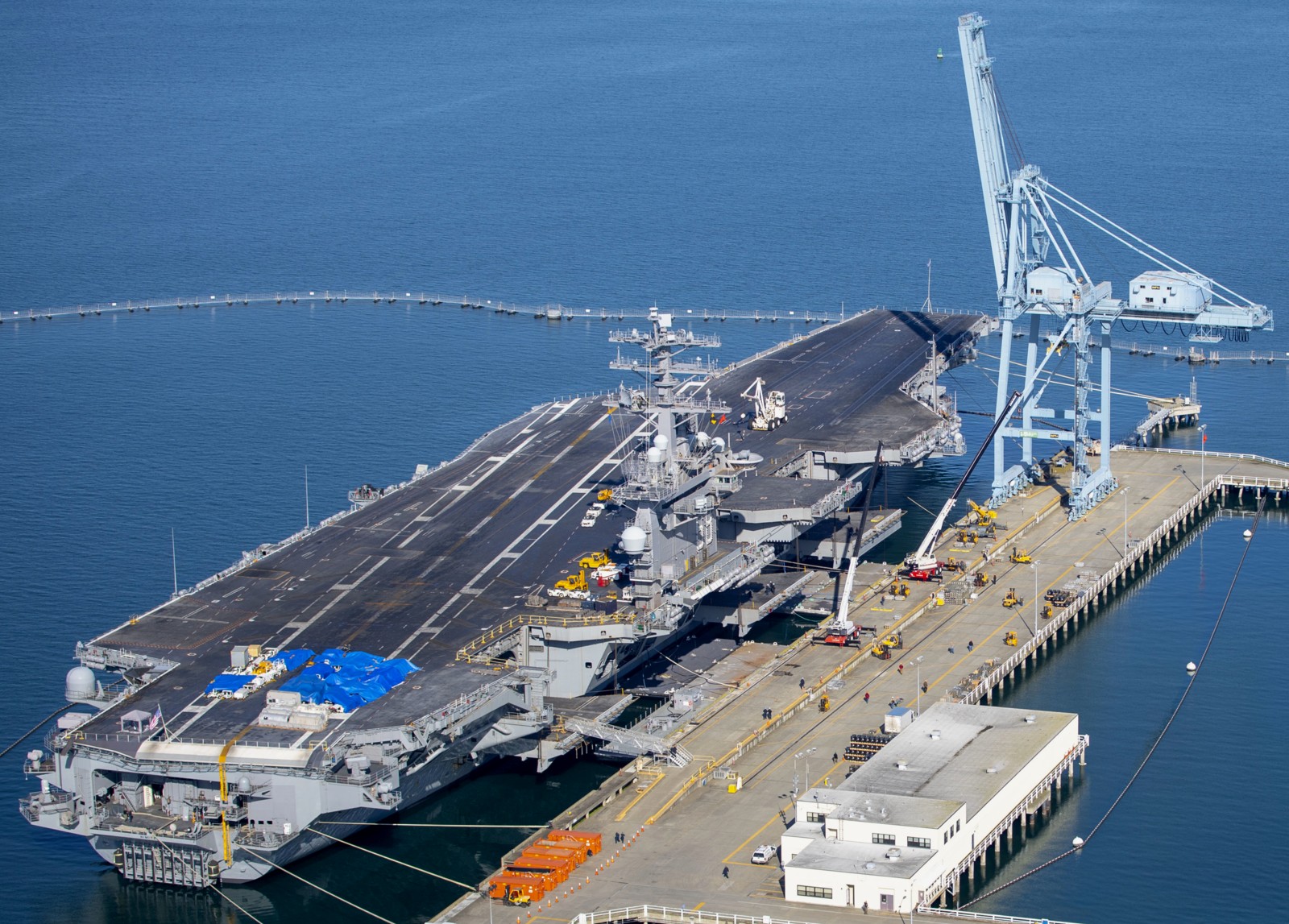 moored at Naval Magazine Indian Island, Washington - February 2020 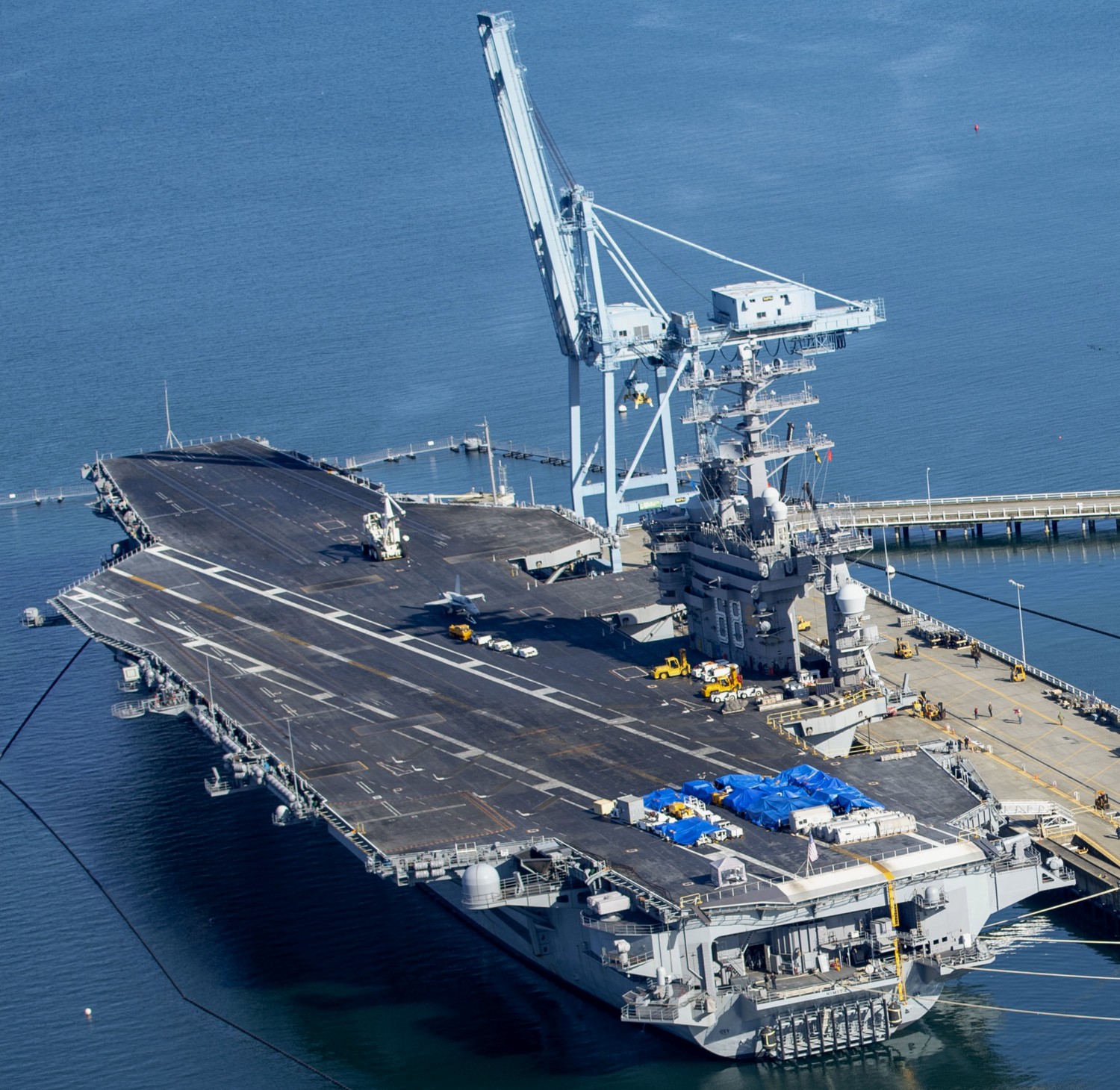 moored at Naval Magazine Indian Island, Washington - February 2020 Drydocking Planned Incremental Availability (DPIA) at Puget Sound Naval Shipyard & Intermediate Maintenance Facility (PSNS & IMF), Bremerton, Washington / March 2018 - May 2019 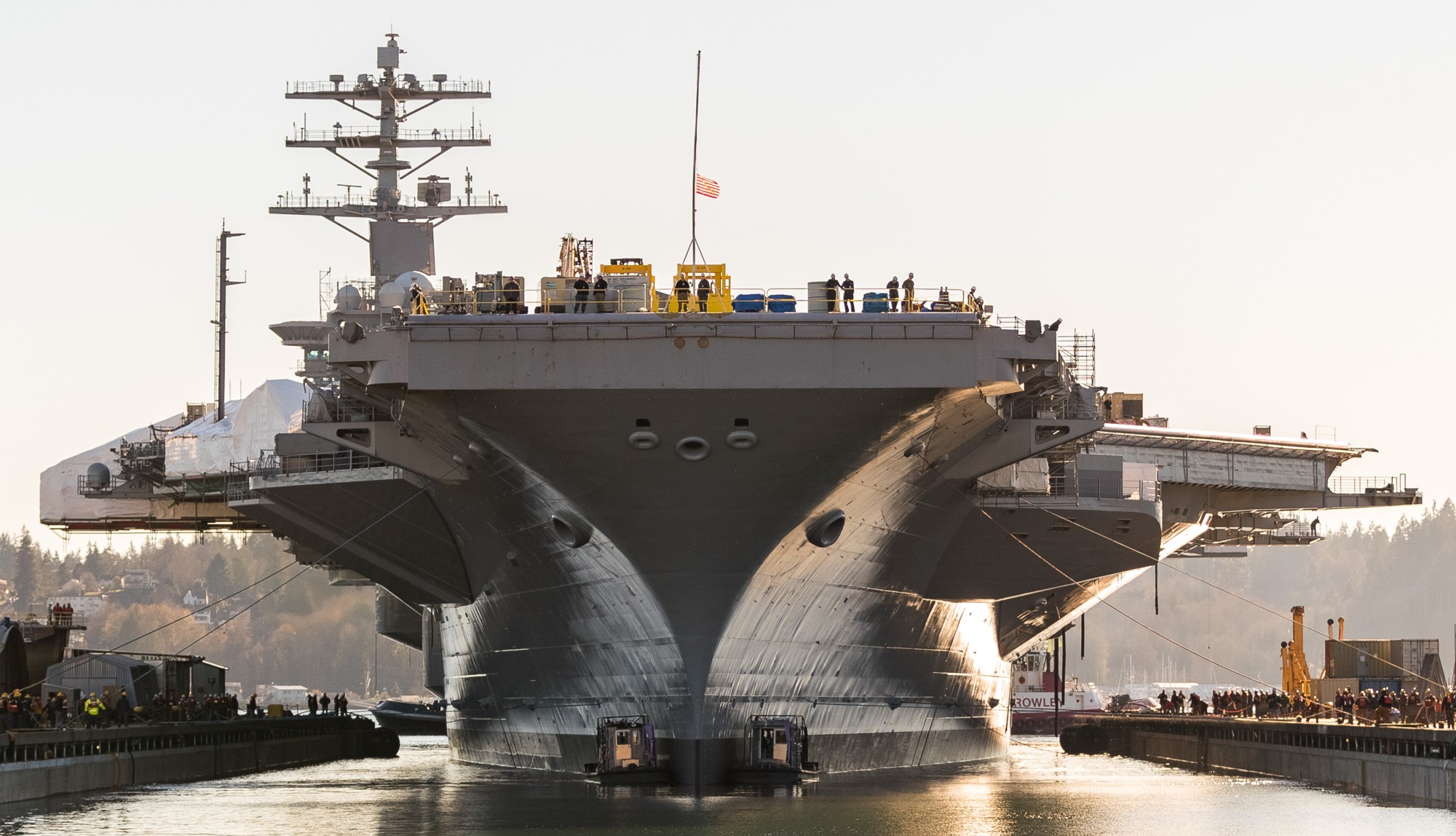 departing the dry dock at Puget Sound Naval Shipyard, Bremerton, Washington - December 2018 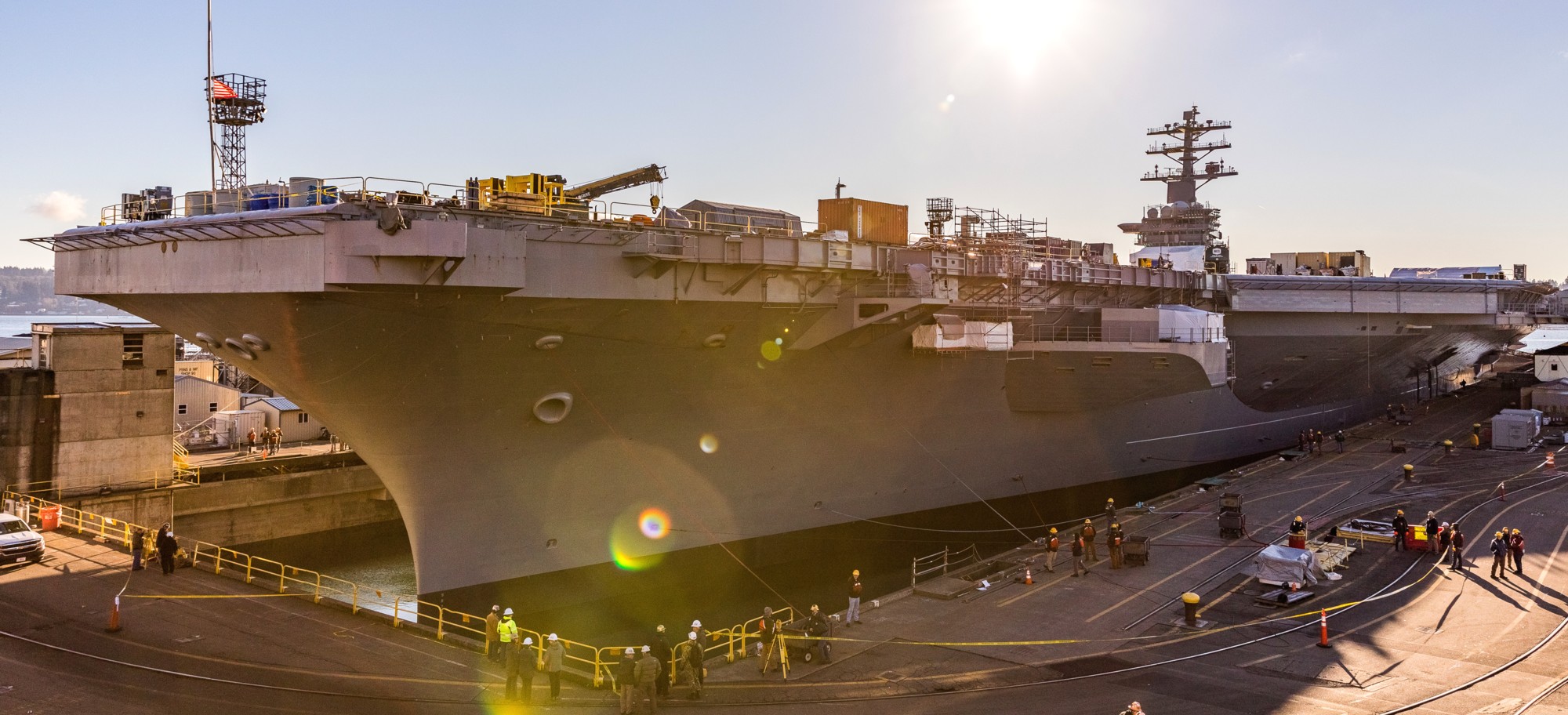 flooding the dry dock at Puget Sound Naval Shipyard, Bremerton, Washington - December 2018 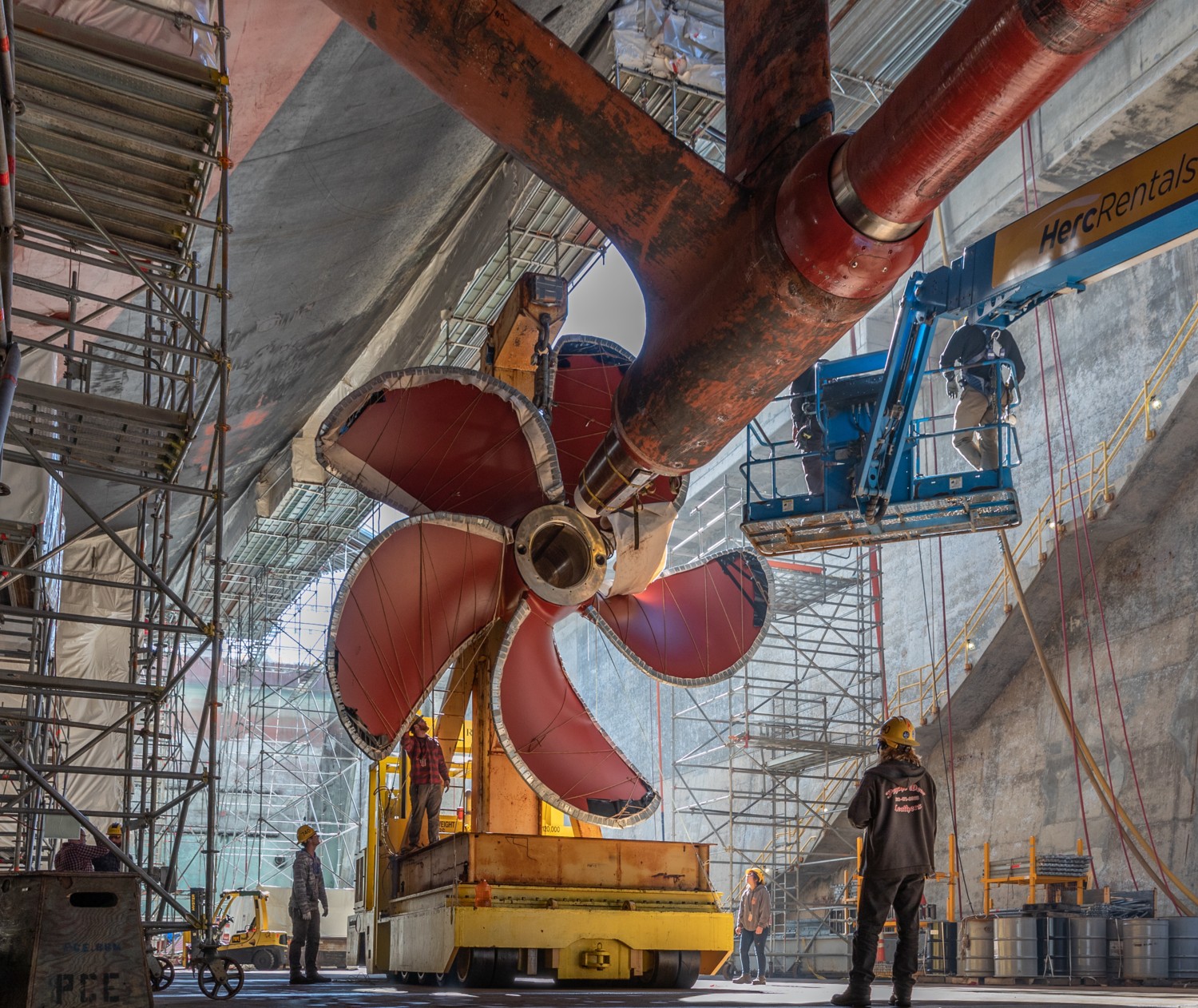 in dry dock at Puget Sound Naval Shipyard, Bremerton, Washington - October 2018 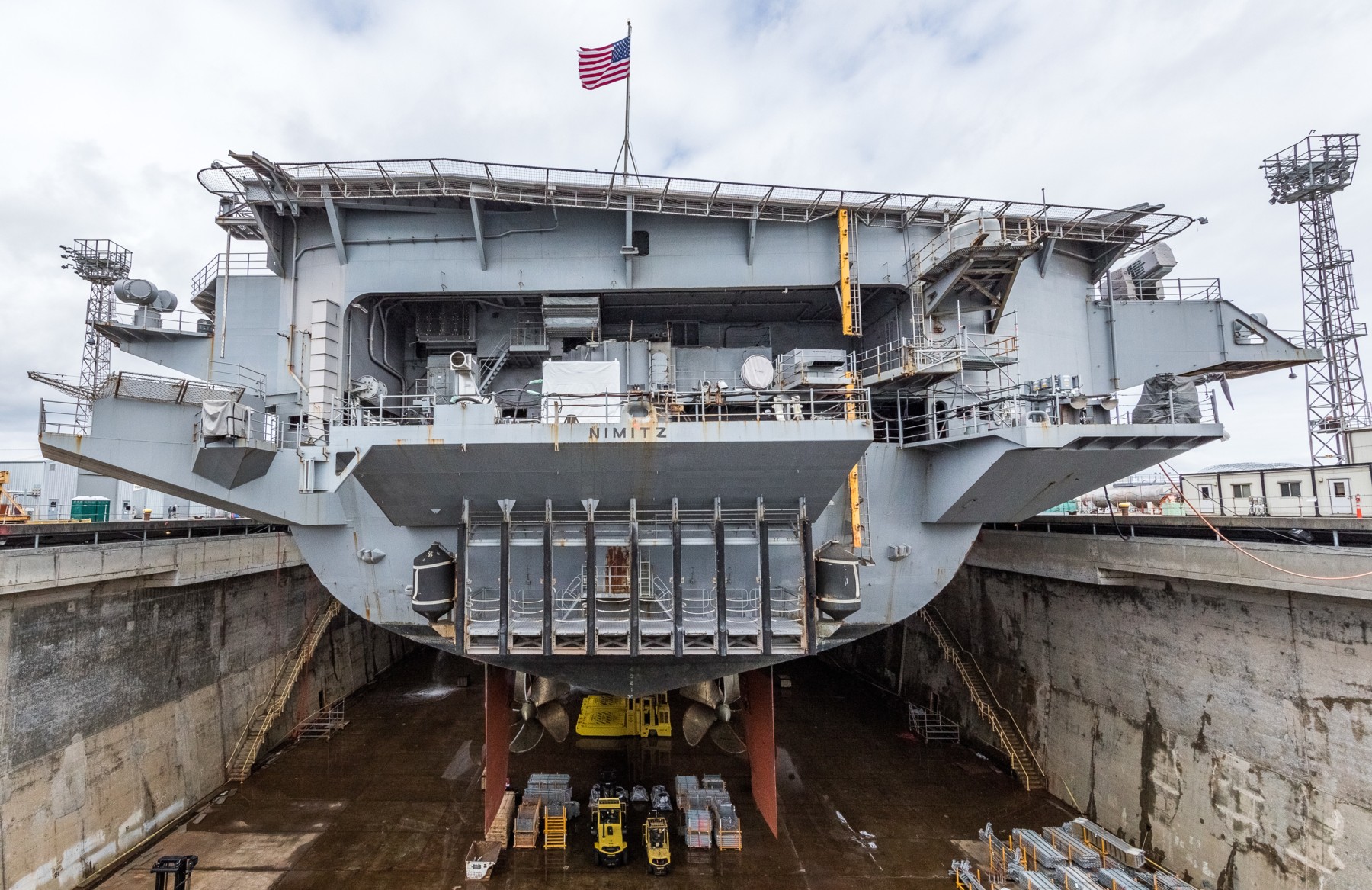 in dry dock at Puget Sound Naval Shipyard, Bremerton, Washington - March 2018 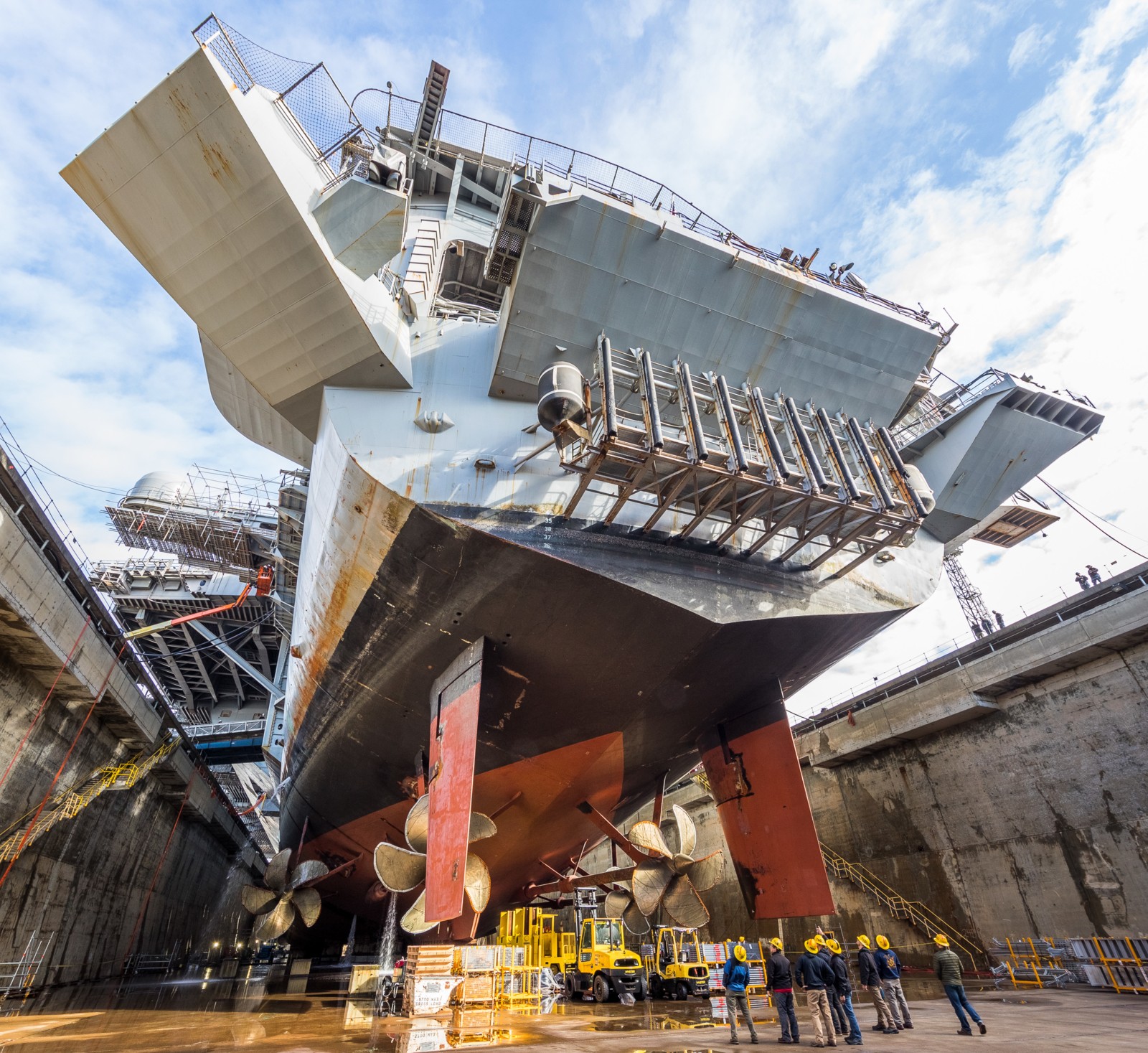 in dry dock at Puget Sound Naval Shipyard, Bremerton, Washington - March 2018 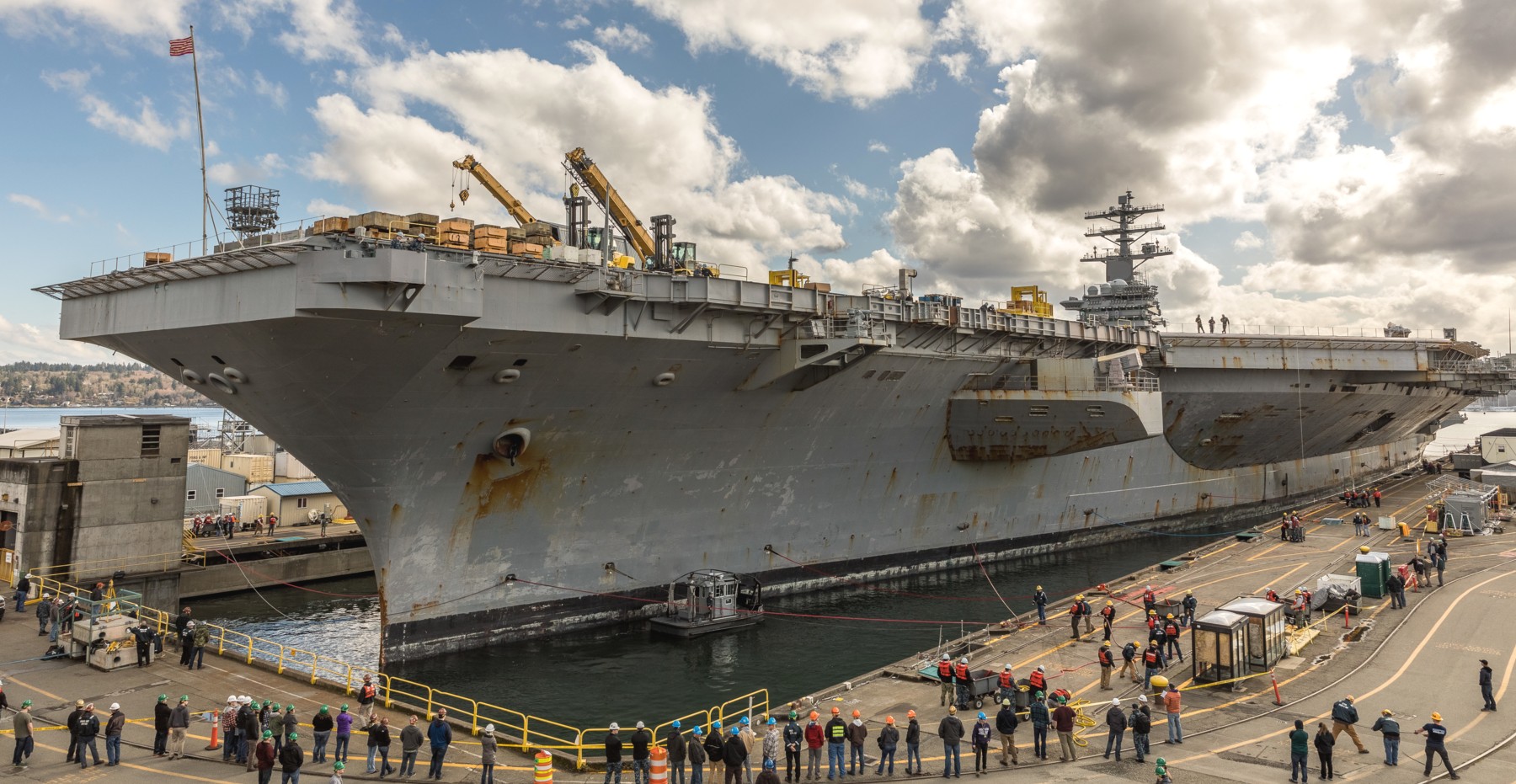 arriving at the dry dock at Puget Sound Naval Shipyard, Bremerton, Washington - March 1, 2018 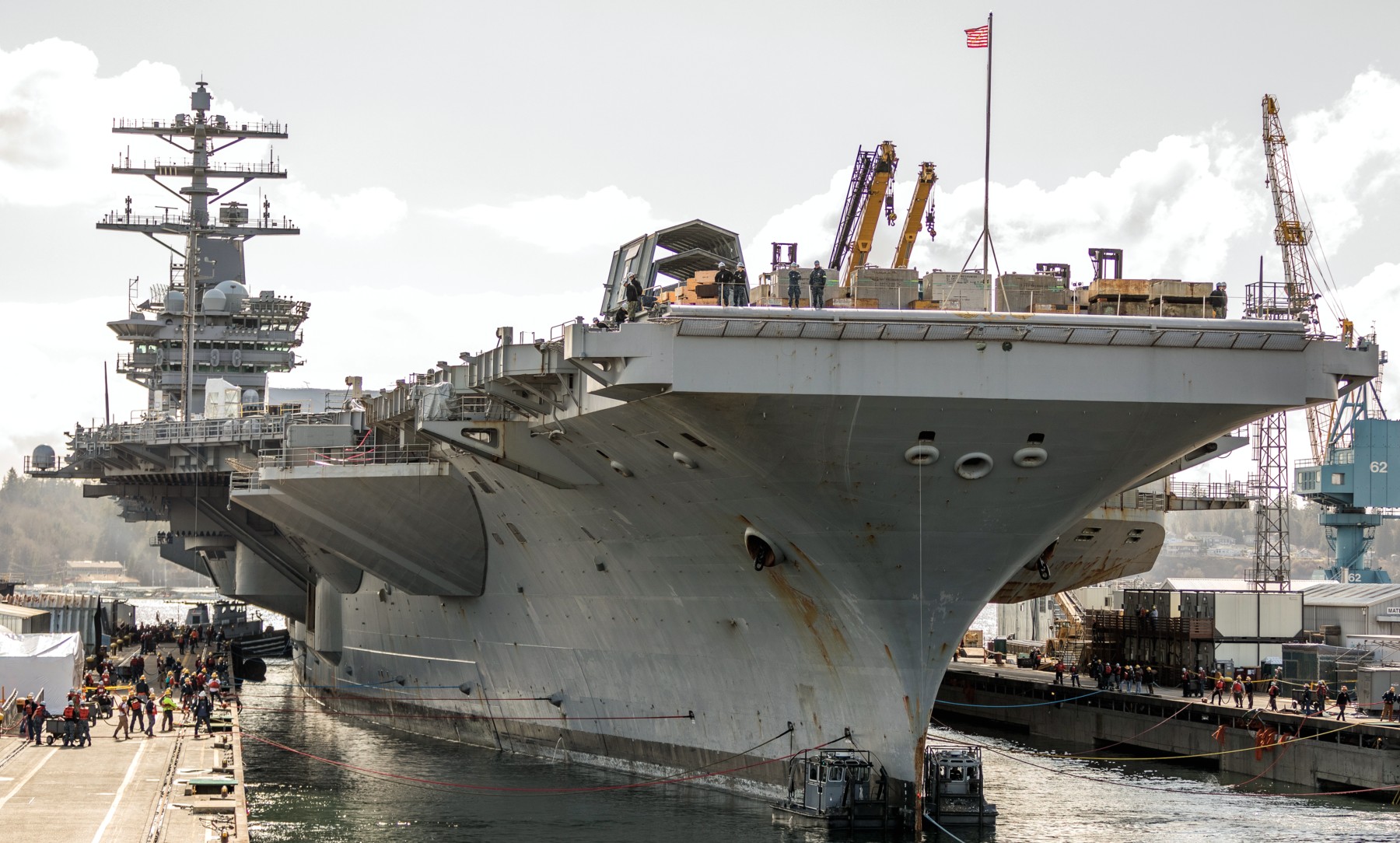 arriving at the dry dock at Puget Sound Naval Shipyard, Bremerton, Washington - March 1, 2018 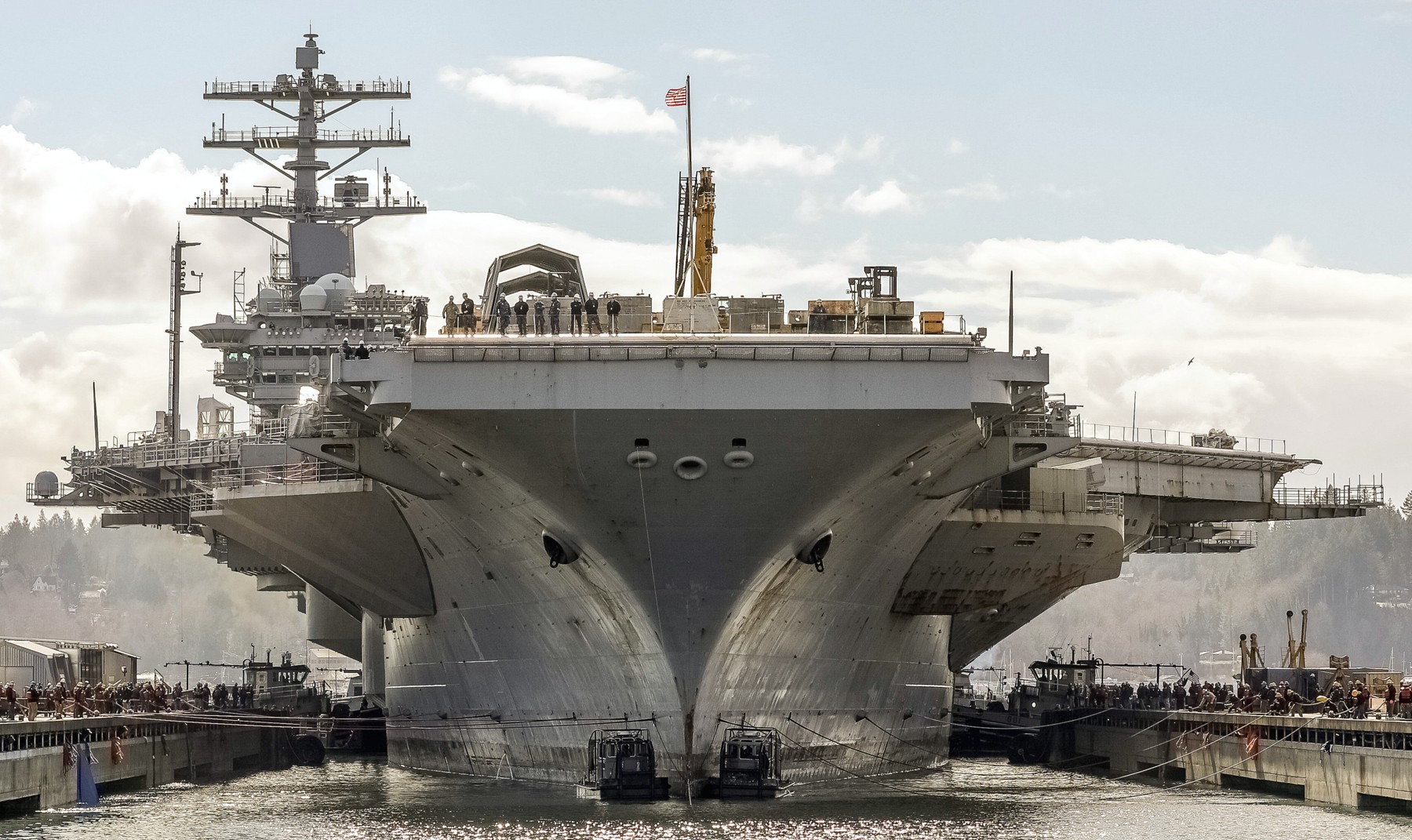 arriving at the dry dock at Puget Sound Naval Shipyard, Bremerton, Washington - March 1, 2018 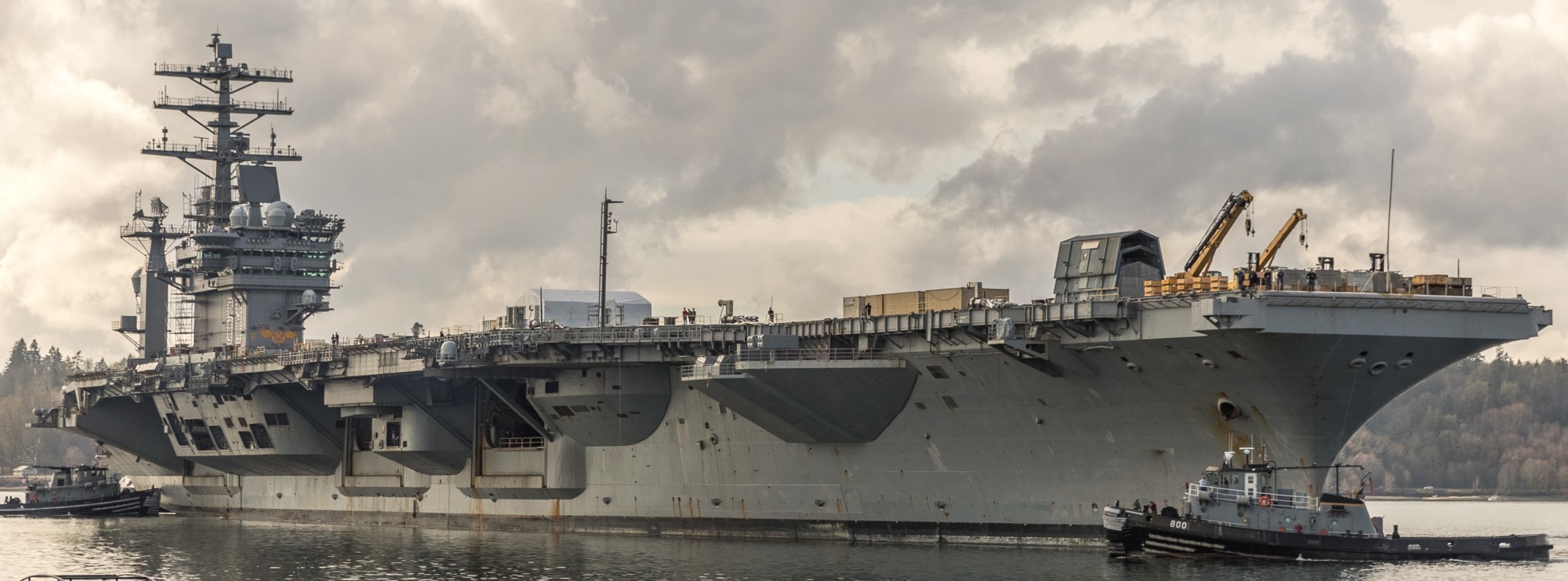 arriving at the dry dock at Puget Sound Naval Shipyard, Bremerton, Washington - March 1, 2018 > continue - CVN 68 image page 2 < |
||
Chester W. Nimitz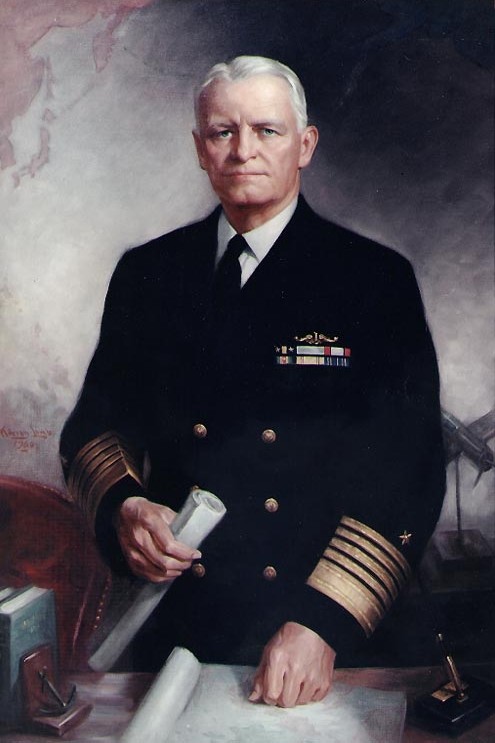 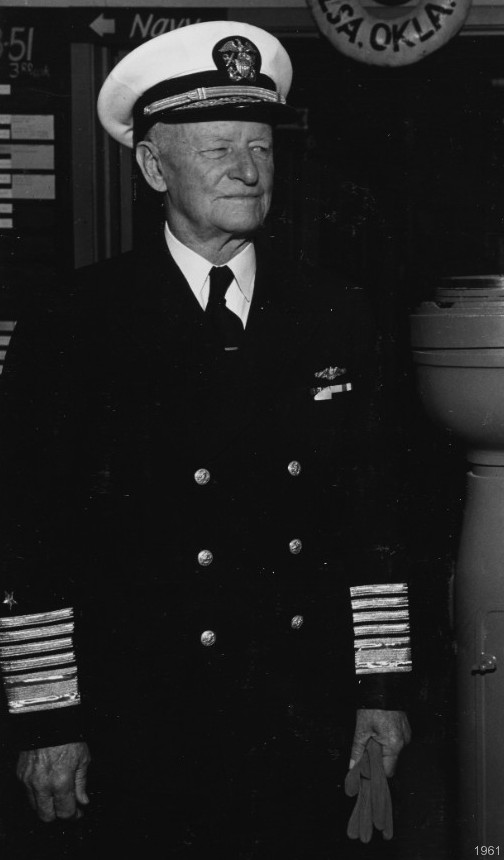
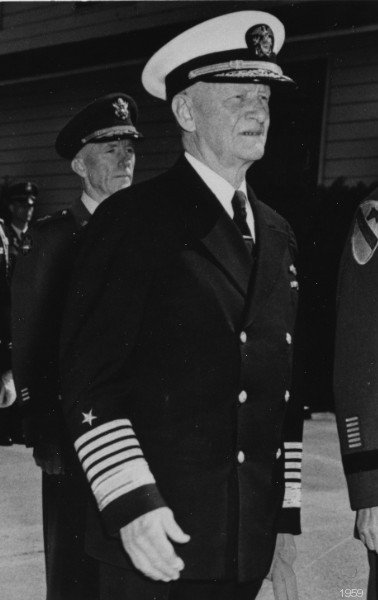 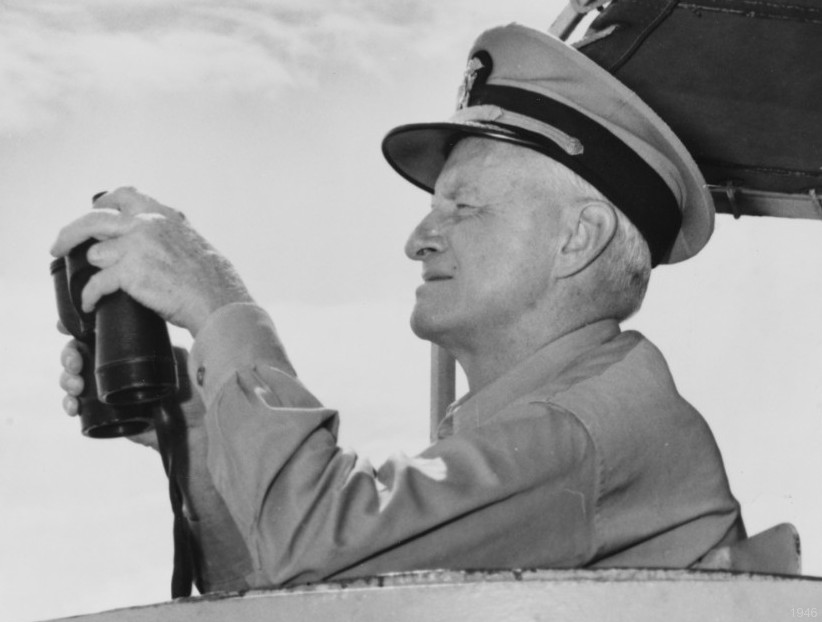 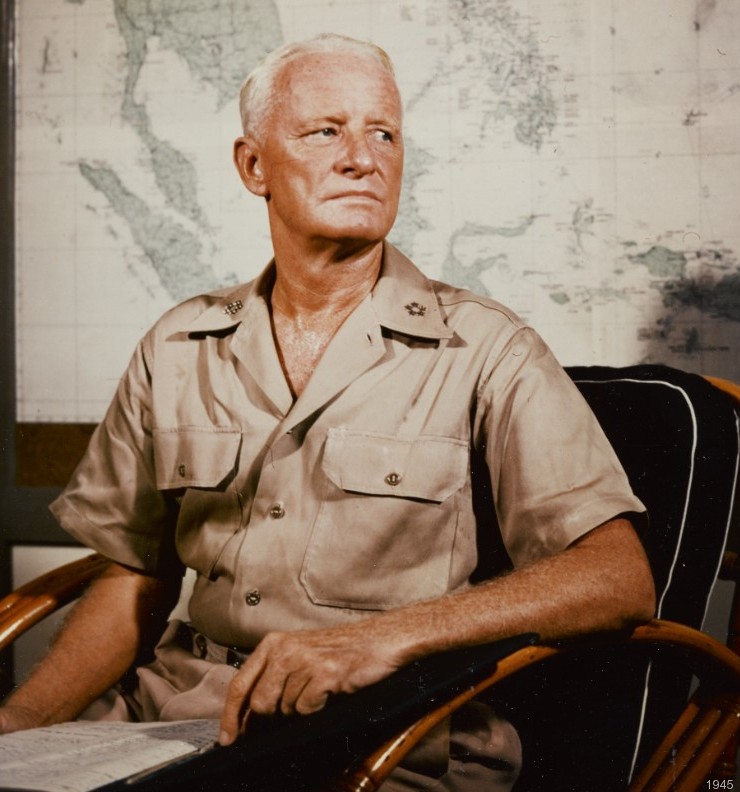 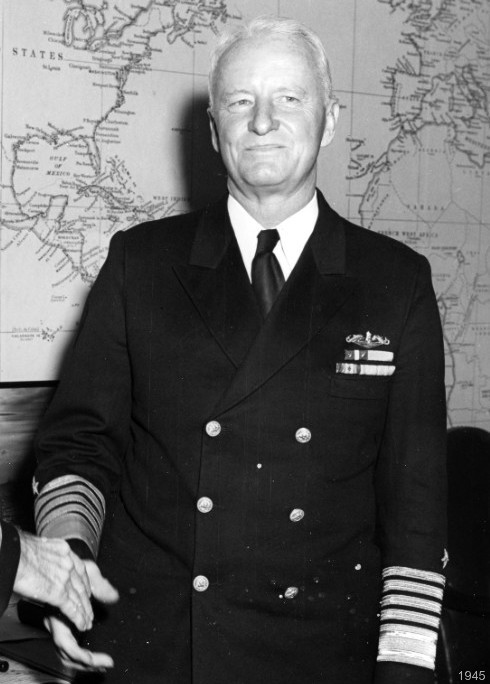
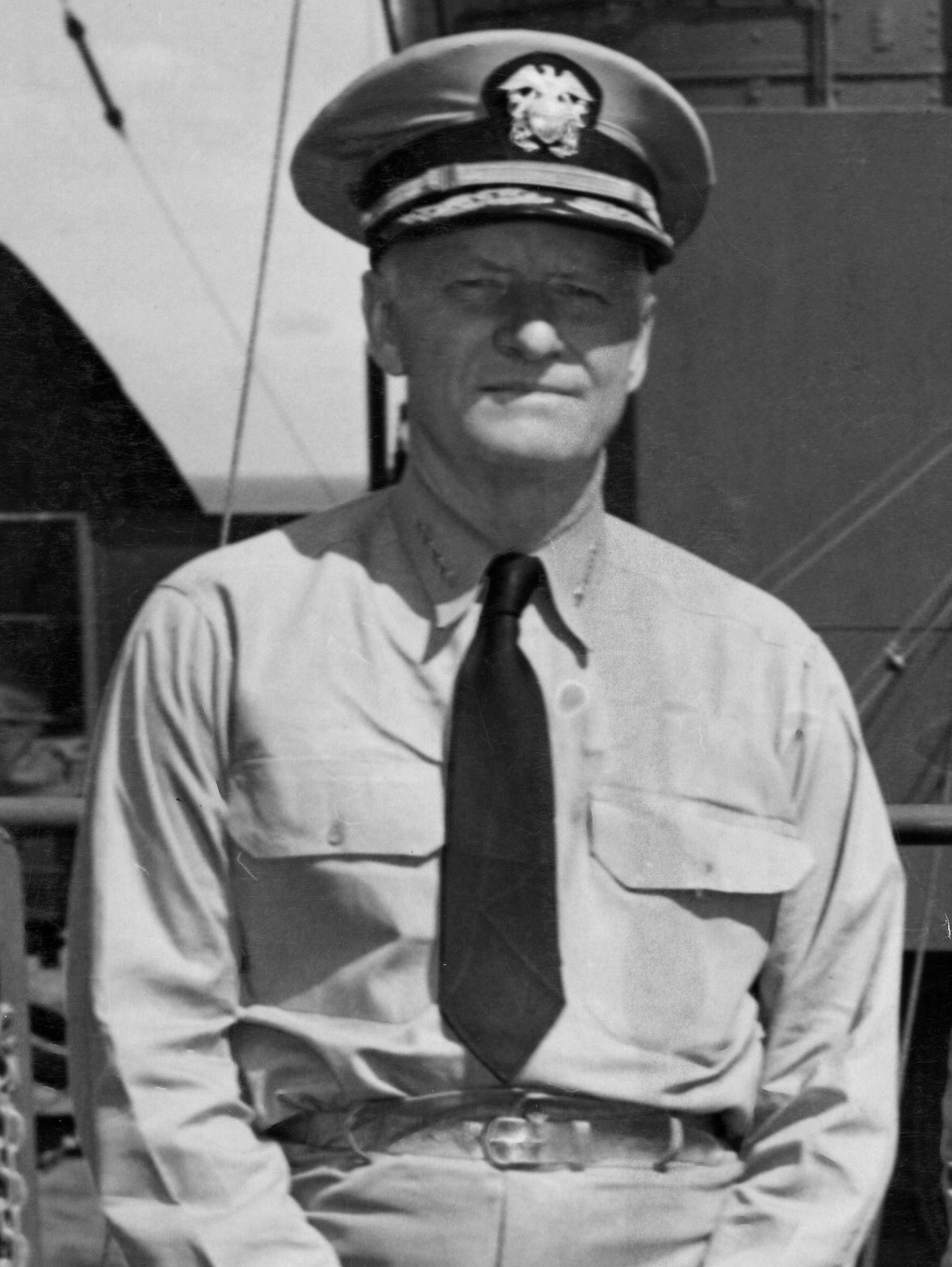 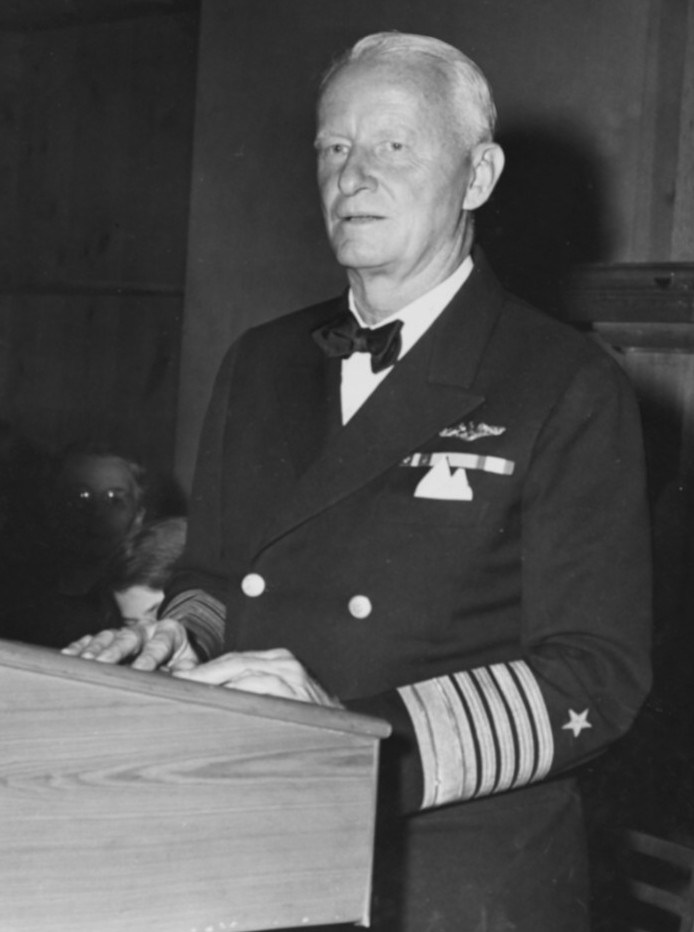 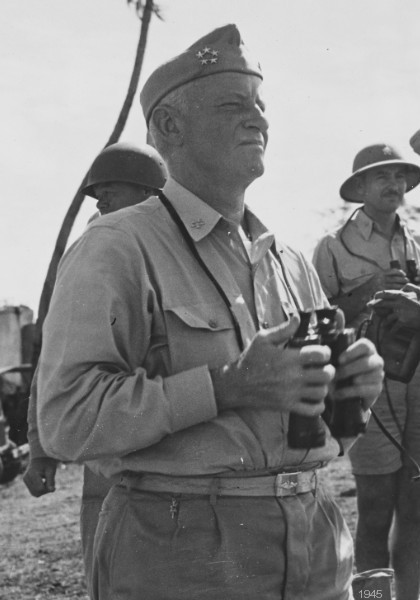
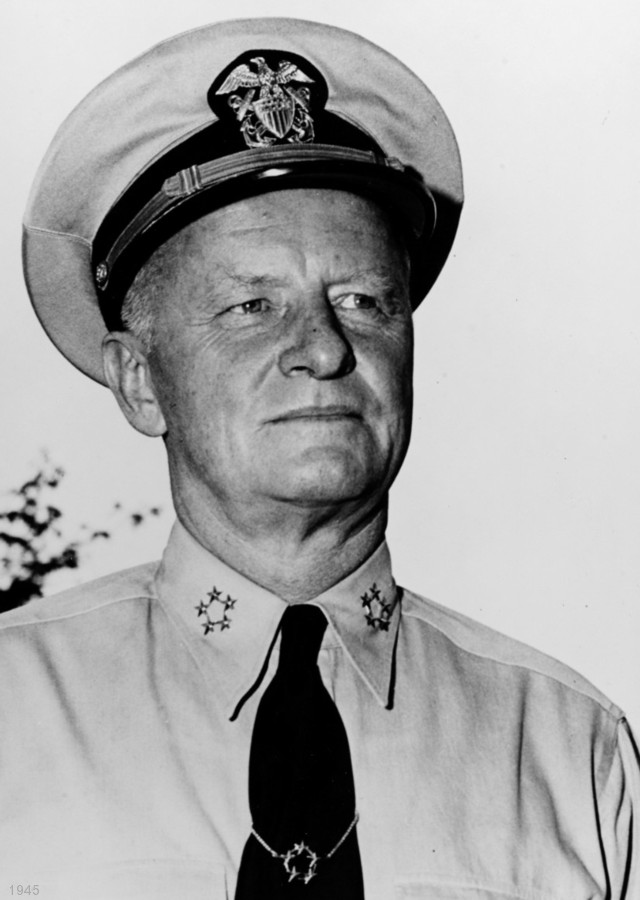 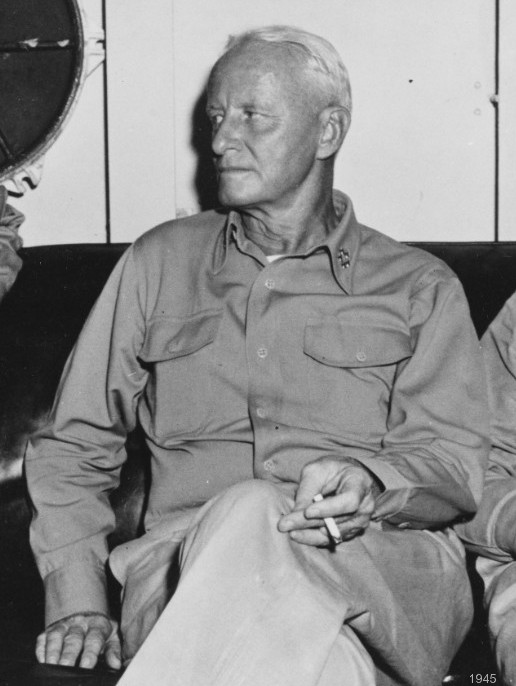
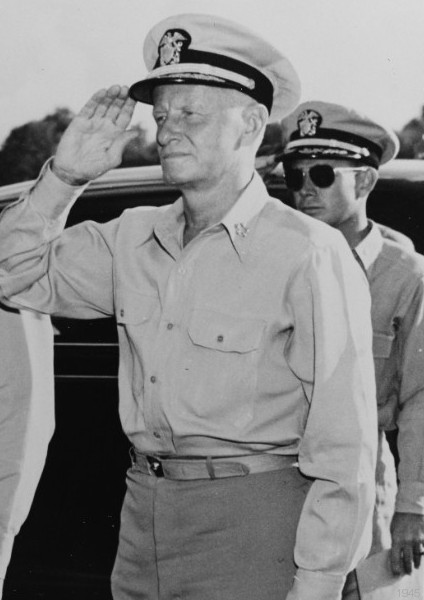 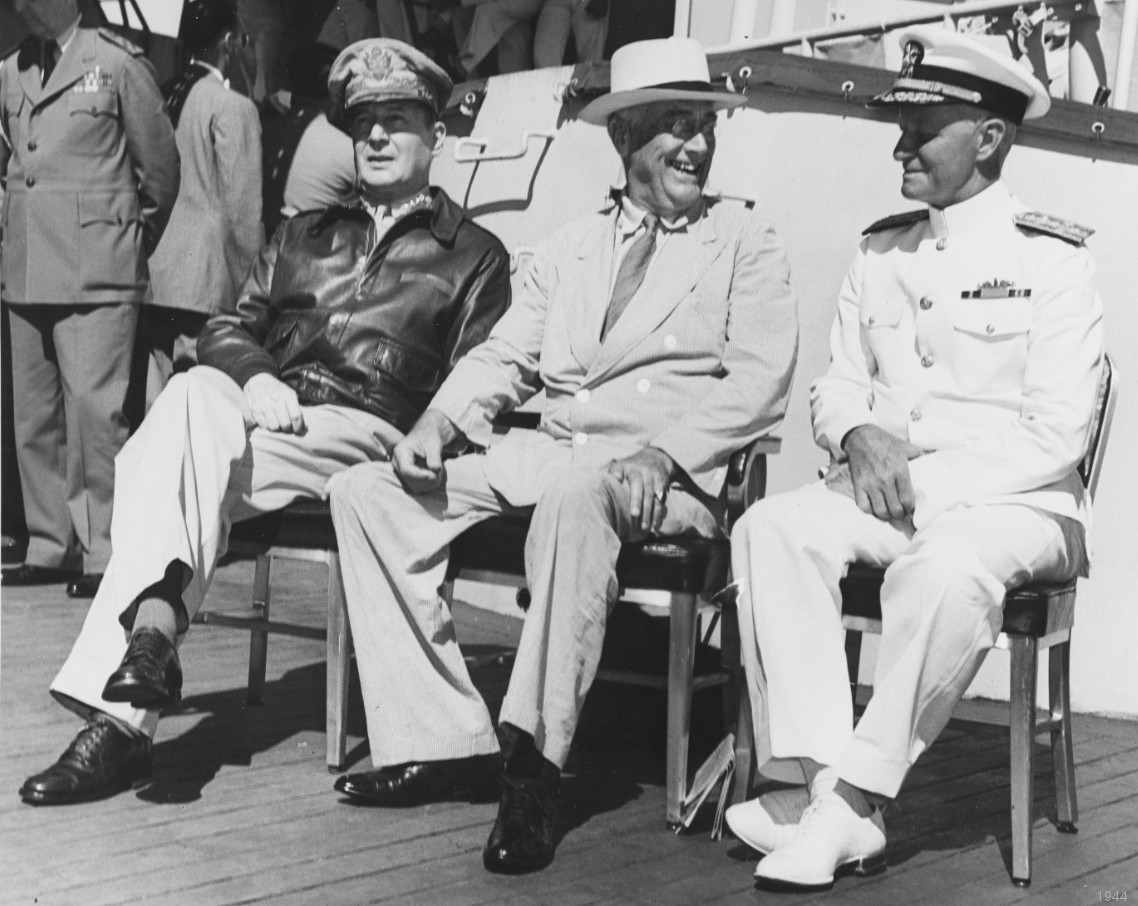 General Douglas MacArthur, President Fanklin D. Roosevelt and Admiral Chester W. Nimitz 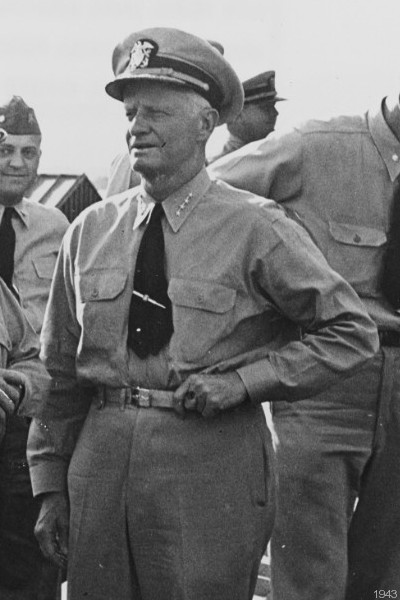
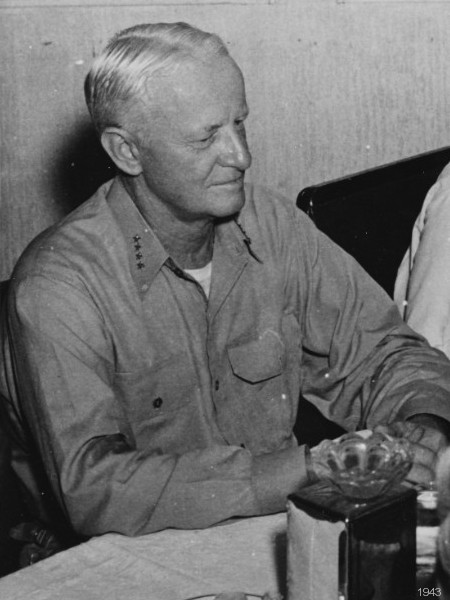 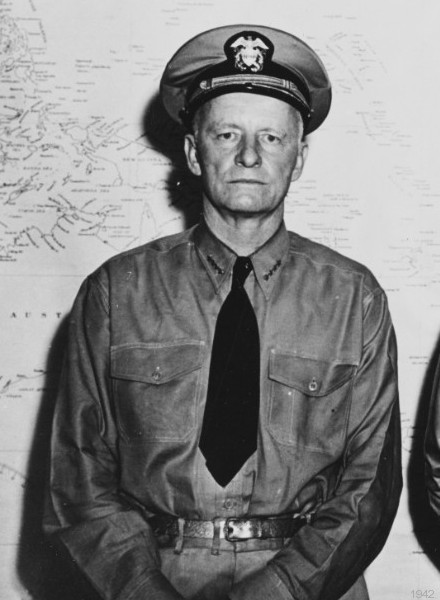
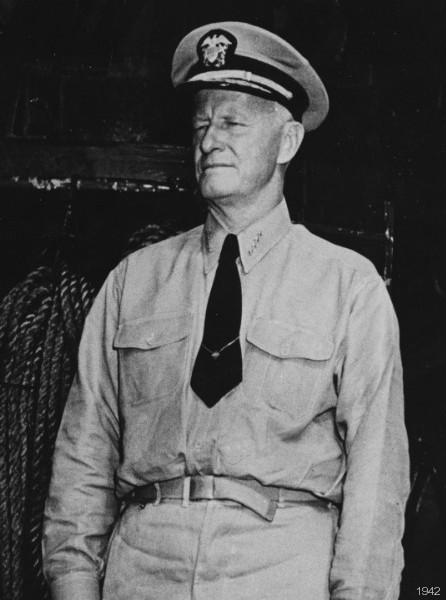 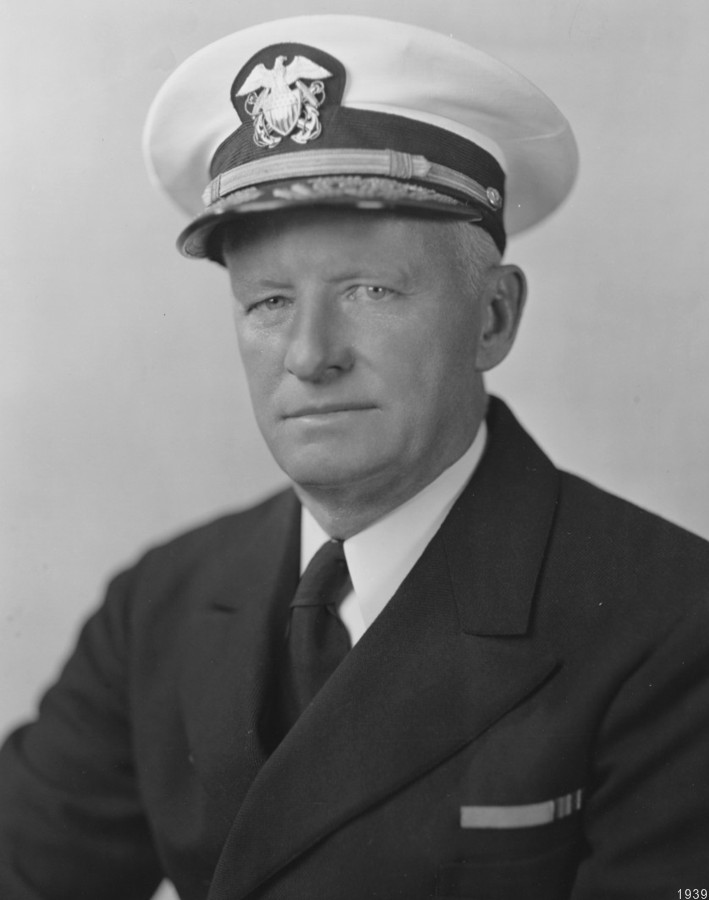
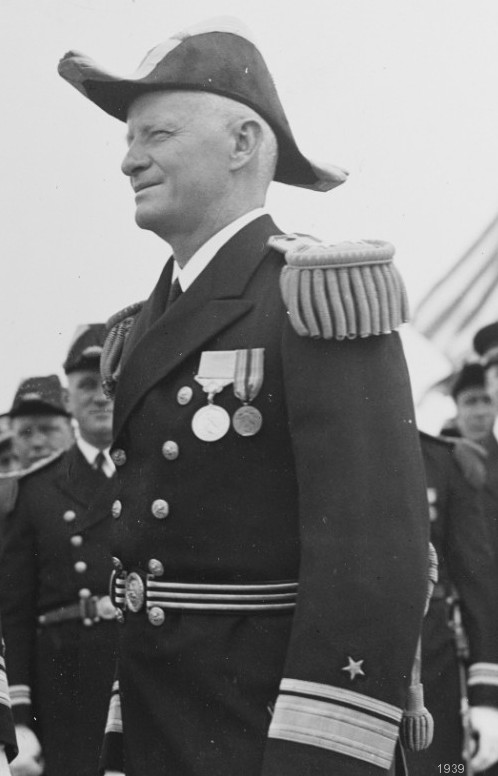 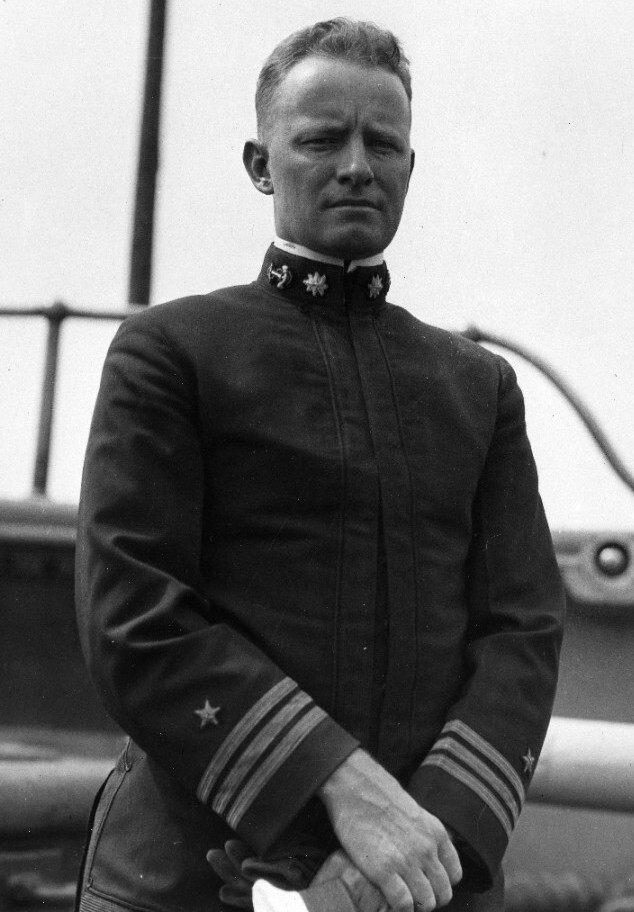 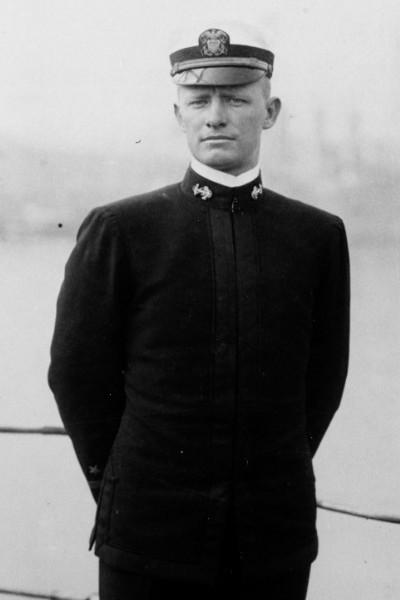
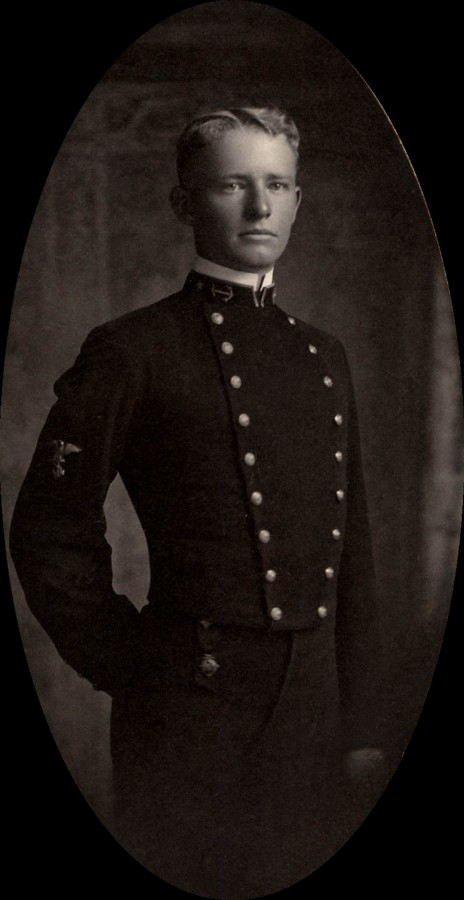 |
||
|
Chester W. Nimitz (February 24, 1885 - February 20, 1966): Chester William Nimitz, born in Fredericksburg, Texas, on 24 February 1885 to Chester Bernard and Anna (Henke) Nimitz, who was appointed to the Naval Academy on 7 September 1901 from the 12th District of Texas. Known variously to his USNA classmates as "Natchew," "Nonnie," or "Nim-i-tiz," he exhibited "that calm and steady going Dutch way that gets to the bottom of things," and graduated seventh in his class on 24 January 1905. After graduation, he joined Ohio (Battleship No. 12) on 23 February and remained in her as she proceeded to the Far East, where she became flagship of the U.S. Asiatic Fleet. On 15 September 1906, he transferred to Baltimore (Cruiser No. 3), and served in her until detached to command the gunboat Panay (12 January - 8 July 1907) ("my first command," he later recalled, "and what a fine ship I thought she was") and then Decatur (Torpedo Boat Destroyer No. 5) (8 July 1907-29 July 1908). While serving in command of the latter, having served the required two years of sea duty, he received his ensign's commission on 26 September 1907, to rank from 2 February of that year. On 7 July 1908, Decatur entered Batangas Harbor south of Manila Bay . Nimitz apparently estimated the ship’s position, rather than taking bearings, but failed to account for tidal variances, consequently, Decatur grounded on a sand bar at about the mid point in the first watch, and remained fast. U.S. Army Transport Wright failed in four tries to pull the warship free. Ultimately, the steamer Buena Lurte, alerted to Decatur's plight, pulled the torpedo boat destroyer free during the mid watch on 8 July. Nimitz duly reported the incident, and a general court martial, convened on board Denver (Cruiser No. 14) at Cavite, Philippines, arraigned and tried him on a under a charge of “culpable inefficiency in the performance of duty.” Due to his previously spotless record and the poor conditions of the available charts of the bay, however, the board reduced the charges, finding him “guilty in a less degree than charged...of neglect of duty,” on 1 August 1908. He received a letter of reprimand from the Commander-in-Chief, U.S. Naval Force in Philippine Waters. Detached from Denver on 12 August 1908, Nimitz served briefly in Ranger (12 August 1908-26 January 1909) for passage back to Boston, Massachusetts, via Suez, before being given duty "under instruction" with the 1st Submarine Flotilla. On 3 May 1909, he reported for duty in command of the flotilla, with additional duty commanding Plunger (Submarine Torpedo Boat No.1). Relieved on 31 December 1909 to proceed to the Boston Navy Yard, in connection with fitting out Snapper (Submarine Torpedo Boat No.16), he reported for duty on 26 January 1910, and placed her in commission on 2 February. Soon thereafter, he received simultaneous promotions, first to lieutenant (j.g.) and then lieutenant, on 12 March, to rank from 31 January. Nimitz then served a tour of temporary additional duty (under instruction in torpedoes) at the Naval Torpedo Station, Newport, R.I., after which time he was detached to assume command of Narwhal (Submarine Torpedo Boat No.17), doing so on 18 November 1910. A little less than a year later, he was given additional duty in command of the 3d Submarine Flotilla (10 October 1911) upon completion of battle practice. Detached on 23 November, Nimitz proceeded to Quincy, Massachusetts, to help fit out Skipjack (Submarine Torpedo Boat No.24), and placed her in commission on 14 February 1912; nine months later, Skipjack received the alphanumerical name E-1. On 20 March 1912, FN2 W.J. Walsh fell overboard while helping to haul a steam launch on board Tonopah (Monitor No. 8) at Hampton Roads, Va. A strong tide carried Walsh, a non-swimmer, away from the ship. Nimitz, on Tonopah's quarterdeck at the time, unhesitatingly jumped in the water and went to Walsh's aid. The strong tide, however, carried both men away from the ship, and the enlisted man struggled, interfering with the officer's attempt to save his life. MM2c L.G. Kaufman threw a life buoy in the water and then dove in, and helped the exhausted Nimitz keep Walsh afloat. Soon thereafter, a passing motor launch from North Carolina (Armored Cruiser No.12) picked up all three men. The Treasury Department later awarded Nimitz the Silver Lifesaving Medal. Detached from command of the 2nd Group, Atlantic Submarine Flotilla, on 17 May 1912 to command the whole Atlantic Submarine Flotilla, Nimitz was detached on 30 March 1913 upon the arrival of the 1st Group of the Atlantic Submarine Flotilla. He married Catherine V. Freeman of Wollaston, Mass., on 9 April 1913, a union that ultimately produced four children. A brief tour of duty at the Bureau of Steam Engineering, Washington, D.C. (28 April - 2 May 1913) then preceded his orders to the New London Ship and Engine Building Co., Groton, Conn., in connection with the heavy oil machinery installation on board Maumee (Fuel Ship No.14), then under construction, where he reported on 5 May. Engineering duty at the New York Navy Yard (5-24 May) followed, after which time he proceeded abroad to visit diesel engine plants at Nüremberg, Germany (the M.A.N. factory), and Ghent, Belgium. Returning to Washington and the Bureau of Engineering on 27 August, he returned thence to the New York Navy Yard on 1 October. Before he reported to the Machinery Division, Industrial Department, at that yard, he inspected the Naval Militia at New Rochelle and Ossining, New York, on 20 May 1914. Given additional duty on 8 February 1916 in connection with fitting out Maumee, he served briefly (15 July) as a member of a board of inspection and survey to inspect civilian motor boats (possibly in connection with future wartime mobilization assets) before he became Maumee's engineer officer, and then her executive officer, when she was commissioned on 23 October 1916, a tour of duty in which he "demonstrated the ability of that ship to deliver the goods with her new style engines." On 10 August 1917, Nimitz reported on board the protected cruiser Chicago "for duty in connection with submarines" and soon became an aide on the staff of RADM Samuel S. Robison, Commander, Submarine Force, Atlantic Fleet, on 6 February 1918, later being appointed Robison's chief of staff, duty Nimitz later remembered fondly since "with this assignment I made contact with one of the finest men in the Navy, whose ability and high character have always been an inspiration to me." He also received promotion to commander during that tour (19 February, to rank from 1 February) as well as a letter of commendation for his "meritorious service" as chief of staff; he also served on a Board of Standardization of Submarines (October 1917) and had "temporary additional duty in connection with submarines operating in European waters" (May 1918) which he later wrote involved "getting our submarines ready and then across the Atlantic to operate with the Allies." Upon his detachment from that duty on 14 September, he proceeded to Washington, where he served briefly on a Board of Submarine Design (October 1918). Detached on 5 May 1919, he reported the following day to came executive officer of South Carolina (Battleship No. 26), serving in that billet until 20 May 1920, after which time he proceed to the 5th Naval District "in connection with [the] assembly of material for shipment to [the] Submarine Base, Pearl Harbor," Territory of Hawaii. Detached from that duty on 7 June "to take passage on [an] Army transport sailing about July 5, 1920, for Honolulu," he arrived at Naval Station, Pearl Harbor, on 11 July, to oversee the building of a submarine base. Soon thereafter, he assumed command of protected cruiser Chicago on 17 July, with additional duties as Commander, Submarine Division (SubDiv) 14, Pearl Harbor. Detached from Chicago on 7 April 1922, he returned to the mainland on board transport Argonne (AP-4), and traveled to Newport, R.I., where he reported to begin instruction at the Naval War College (21 June 1922-26 May 1923). He returned to sea duty upon completion of that work at Newport, serving as Aide and Assistant Chief of Staff to the Commander, Battle Fleet, ADM Edward W. Eberle, and later to ADM Robison, who had risen to become Commander in Chief, U.S. Fleet (30 June 1923-6 July 1926). Ordered to the University of California, Nimitz established and taught at one of the first Naval Reserve Officer’s Training Corps (NROTC) units at that institution, a tour of duty (10 August 1926-8 June 1929) he later remembered as being "new ground and [where] there were no precedents on which to base one's actions." During that tour, he received promotion to captain on 2 June 1927. Going on to assume command of SubDiv 20 (redesignated SubDiv 12 on 1 April 1931) on 15 June 1929, Nimitz then assumed command of destroyer tender Rigel (AD-13) and the decommissioned destroyers laid up at the Destroyer Base, San Diego , Calif., on 17 June 1931. Detached from that duty on 30 September 1933, he assumed command of heavy cruiser Augusta (CA-31) on 16 October, cruising in her to the Far East , where in December she relieved heavy cruiser Houston (CA-30) as flagship for Admiral Frank B. Upham, Commander in Chief, U.S. Asiatic Fleet. Detached from Augusta on 12 April 1935, he returned to Washington and reported to the Bureau of Navigation (BuNav) on 28 May, becoming assistant to the chief of the bureau, Rear Admiral William D. Leahy (relieved soon thereafter by Rear Admiral Adolphus Andrews) on 1 June. Designated as Commander, Cruiser Division 2, Battle Force, with the rank of rear admiral (effective "upon his taking over the command") he reported for duty on 9 July 1938; a little over two months later, on 17 September, he broke his flag in battleship Arizona (BB-39) as Commander, Battleship Division 1, Battle Force. Detached from that tour of sea duty on 27 May 1939, he returned to Washington and on 15 June 1939, became Chief of the Bureau of Navigation, for a term of four years. He entered the upper half of the list of rear admirals on 1 November 1941. Before Nimitz could complete his tour as bureau chief, however, the Japanese iniated hostilities in the Pacific with simultaneous operations on a wide front, including a surprise attack on the U.S. Pacific Fleet at Pearl Harbor on 7 December 1941. Ten days later, on 17 December 1941, President Franklin D. Roosevelt ordered Nimitz to duty as Commander in Chief, Pacific Fleet (CinCPac) with the rank of admiral, effective 31 December when he hoisted his flag on board submarine Grayling (SS-209). Nimitz assumed command of the Pacific Fleet at a low point in its fortunes. Deploying his surviving aircraft carriers, however, providentially away from Pearl Harbor at the time of the Japanese' bold strike, with supporting cruisers and destroyers, Nimitz adopted the principle of the strategic defensive, striking at the enemy in a series of surprise raids (the Marshalls and Gilberts, Wake, Marcus, Lae and Salamaua) that culminated in the Halsey-Doolittle Raid on Japan on 18 April 1942, a little over a fortnight after he had been additionally designated Commander in Chief, Pacific Ocean Areas (CinCPOA)(3 April). Soon thereafter, Nimitz visited Midway to personally assess conditions there (2 May). For his direction of the Pacific Fleet in the critical spring of 1942 that culminated in the victories at Coral Sea (7-8 May) and Midway (4-6 June), at Guadalcanal (August 1942-February 1943) and in the Marshall Islands (February 1944) he later received the Distinguished Service Medal from President Roosevelt, presented in the name of Congress, that recognized his "brilliant leadership and outstanding skill as a strategist." He also received a Distinguished Service Medal by the Navy Department that specifically addressed the victories at Coral Sea and Midway in 1942, honoring his "unfailing judgment and sound decision, coupled with skill and vigor..." Nimitz nearly perished less than a month after Midway when the Sikorsky XPBS-1 (BuNo 9995) carrying the admiral hit a submerged log when landing at Naval Air Station, Alameda, Calif., on 30 June 1942. The impact threw the men around inside the big flying boat like dice in a box, inflicting injuries on all on board, and they soon began struggling to escape as the aircraft filled with water. Nimitz, who suffered scratches and abrasions in the mishap, immediately showed concern for those who had been hurt in the crash (one of the flight crew, Lieutenant Thomas M. Roscoe, died in the mishap) and remained topside on the wreckage to direct rescue operations, refusing to move until searchers finished their grim task of investigating the wrecked flying boat for survivors. An Act of Congress, approved on 14 December 1944, established the grade of Fleet Admiral of the United States Navy, the highest grade in the Fleet, for certain officers of the active list, and the next day the President nominated Nimitz - with the advice and consent of the Senate - to that rank. The admiral accepted the appointment, taking the oath of office five days later. On 5 October 1945, designated “Nimitz Day” in Washington , D.C. , President Harry S. Truman presented Nimitz with a Gold Star in lieu of his third Distinguished Service Medal, covering the period June 1944 - August 1945, recognizing his demonstrating "the highest qualities of a naval officer" and his rendering "services of the greatest distinction to his country." The operations recognized in that citation ranged from the attack on the Marianas, the invasion of Saipan and the Battle of the Philippine Sea to the isolation of the central and eastern Carolines and the securing of Peleliu, Angaur, and Ulithi; from the Battle of Leyte Gulf to the amphibious invasions of Iwo Jima and Okinawa, and the final placement of "representative forces of the United States Navy in the harbor of Tokyo for the final capitulation of the Japanese Empire..." Nimitz signed for the U.S. Navy as the Japanese formally signed the terms of their surrender ending WW II on board battleship Missouri (BB-63) in Tokyo Bay on 2 September 1945. On 26 November 1945, the Senate confirmed Nimitz’s nomination as Chief of Naval Operations (CNO). He hauled down his flag at Pearl Harbor , and relieved Fleet Admiral Ernest J. King as CNO on 15 December 1945. As CNO, Nimitz oversaw the "difficult task of reducing the most powerful Navy in history to a fraction of its war-time peak," and administered the programs for the establishing and maintaining "of Active and Reserve fleets with the potential strength to support our national policy..." He supported the development of nuclear propulsion as well as nuclear weapon, assisted Secretary of the Navy James Forrestal in his efforts to formulate the Navy's position concerning the unification of the armed forces, and worked on determining the Navy's mission in view of the growing threat posed by the Soviet Union. Detached from duty as CNO on 15 December 1947, having been awarded a Gold Star in lieu of his fourth Distinguished Service Medal, he proceeded to San Francisco, reporting as Special Assistant, Secretary of the Navy, Western Sea Frontier, on 1 January 1948, to serve in an advisory capacity "assisting in other matters pertaining to the Navy when called upon." The Secretary of State announced the nomination by the United Nations Secretary General of Nimitz as Plebiscite Administrator, Kashmir , during the fighting erupting from the independence of the former British Viceroyalty of India. When it appeared that the plebiscite mission would be postponed, Nimitz asked to be relieved of that assignment, alternatively accepting duties as roving “good-will” ambassador of the UN. On 23 January 1951, President Harry S. Truman selected Nimitz to head the President’s Internal Security Commission, consisting of nine “prominent” citizens under his chairmanship. Magnanimous in peace and war, he helped raise funds for the restoration of Japanese battleship Mikasa, naval symbol of the very people he had been instrumental in defeating. Nimitz, the recipient of decorations from 13 foreign governments and honorary degrees from 19 American colleges and universities, died from a stroke complicated by pneumonia, at Treasure Island, Calif., on Sunday 20 February 1966. Typical of his modest, self-effacing character, Nimitz had requested simple ceremonies incident to his burial at the Golden Gate National Cemetery on 24 February 1966, as “a final resting place close to” those who “died in the Pacific.” source: US Naval History & Heritage Command |
||
|
Chronology and Significant
Events: 15 May 1968: The Navy awarded Newport News Shipbuilding and Dry Dock Co., a $106.3 million award toward the design and construction of Nimitz. 22 Jun 1968: Nimitz’s keel was laid, at Newport News Shipbuilding and Dry Dock Co. Senator Henry M. Jackson (D., Wash.) authenticated that company’s Hull No. 594. The company finished and outfitted her at Pier 2. 13 May 1972: Hull No. 594 launched from Shipway 11, Newport News Shipbuilding and Dry Dock Co. Based upon a design originally submitted to build the Midway class of aircraft carriers during WWII, the company raised the 1,100 foot long submerged shipway from tidal flats and extended it to accommodate Nimitz class aircraft carriers. 12 Jul 1972: CAPT Bryan W. Compton, Jr., the ship’s first CO, took command of the Nimitz Precommissioning Unit. 1-4 Mar 1975: Nimitz went to sea for builder’s sea trials. “The NIMITZ and her sister ships,” remarked ADM Hyman G. Rickover, Director, Naval Reactors Branch, Naval Sea Systems Command, at the conclusion of her first trial on the 3rd, “will give our first line naval strike force an unequaled capability.” 11 Apr 1975: The Navy accepted Nimitz from Newport News Shipbuilding and Dry Dock Co. 12 Apr 1975: Nimitz shifted her builder’s yard to Pier 12, Naval Station (NS) Norfolk , Va. Shortly afterward Nimitzmade a “short cruise” and conducted her first air operations off the Virginia capes, embarking CVW-8 (CAPT Everett W. Foote): Attack Squadrons (VAs)-35, 82, and 86 (Grumman A-6E Intruders, Ling-Temco-Vought A-7E Corsair IIs, and Grumman KA-6D tankers); Marine Fighter Attack Squadron (VMFA)-333 (McDonnell Douglas F-4J Phantom IIs); Reconnaissance Attack Squadron (RVAH)-9 (North American RA-5C Vigilantes); Tactical Electronics Warfare Squadron (VAQ)-130 (Grumman EA-6B Prowlers); Carrier Airborne Early Warning Squadron (VAW)-116 (Grumman E-2BHawkeyes); and Helicopter Antisubmarine Squadron (HS)-15 (Sikorsky SH-3H Sea Kings). The ship also had a Grumman C-1A Trader assigned directly to her for carrier on-board delivery. Upon conclusion, RADM John D. Bulkeley, heading the Board of Inspection and Survey, looked over the ship, off the Virginia capes. 3 May 1975: “Only America can make a machine like this,” noted President Gerald R. Ford at Nimitz’s commissioning. “There is nothing like her in the world.” RADM Richard E. Rumble, Commander, Fifth Naval District, put Nimitz into commission at Pier 12, NS Norfolk, Va. Secretary of Defense James R. Schlesinger, Secretary of the Navy J. William Middendorf, Chief of Naval Operations ADM James L. Holloway, III, and ADM Rickover were among the more than 20,000 guests. 5-15 May 1975: Nimitz sailed underway for the first time as a commissioned man of war, and as a ship of the Atlantic Fleet. 31 May 1975: ADM Isaac C. Kidd, Jr., relieved ADM Ralph W. Cousins as Commander, Atlantic Fleet, in a ceremony on board. 1 Jul 1975: The Navy replaced the aircraft carrier designation CVA with CV for all such ships still so designated, including Nimitz, a redesignation made to improve the accuracy of ship nomenclature, reflecting their roles in modern warfare. By removing the letter A (attack), the new designation CV indicated a multi-role ship capable of performing air, surface and ASW roles, depending upon the types of aircraft embarked and missions assigned. 16 Jul-14 Aug 1975: Nimitz underwent her initial operational readiness evaluation (ORE) in the NS Guantánamo Bay Operating Area, Cuba. 15 Aug-24 Sep 1975: Nimitz operated in the North Atlantic with Nuclear Task Force (TF) 75, comprising guided missile cruiser South Carolina (CGN-37) and submarine Seahorse (SSN-669). 1 Oct 1975: Nimitz shifted to Norfolk Naval Shipyard, Portsmouth , Va. , for a post shakedown availability. During her maiden year, the carrier steamed over 31,000 miles, including nearly 18,000 miles on her Cuban and North Atlantic cruise, logging 5,731 launches and 5,352 recoveries. 28 Jan-10 Feb 1976: Nimitz conducted refresher training off Guantánamo Bay. 11-20 May 1976: Nimitz participated in Solid Shield, a pre-deployment exercise off the Carolinas. 7 Jul 1976-7 Feb 1977: Nimitz deployed to the Mediterranean for the first time, accompanied by guided missile cruisers California (CGN-36), South Carolina and Josephus Daniels (CG-27), guided missile destroyers Barney (DDG-6) and Mitscher (DDG-35), ammunition ship Butte (AE-27) and replenishment oiler Milwaukee (AOR-2). These operations marked the first time in ten years that nuclear-powered ships steamed in the Mediterranean. Nimitz sailed over 40,000 miles and launched more than 9,000 sorties during her deployment, and her aircrew flew more than 16,000 hours. 17 Jul 1976: Nimitz relieved aircraft carrier Saratoga (CV-60) off Morocco. RADM Eugene J. Carroll, Commander, Carrier TF 60, and his staff transferred to Nimitz while she was underway. 27 Jul 1976: Nimitz stood by in readiness to assist in the possible evacuation of over 1,100 Americans from Lebanon, a country wracked by civil war. 19 Aug 1976: King Juan Carlos I and Queen Sofia of Spain visited the ship. 3-1 Oct 1976: Nimitz participated in Display Determination, an exercise with over 45 Allied vessels, designed to test North Atlantic Treaty Organization (NATO) power projection across the Mediterranean. 31 Oct 1976: Secretary of the Navy Middendorf presented the coveted RADM Clarence W. McClusky Award to VA-82 on board Nimitz. Named in honor of the naval aviator of the Battle of Midway fame, the award symbolized meritorious achievement by an attack squadron and recognized the dynamic traits and inspirational leadership exemplified by McClusky during his naval career. 18-19 Nov 1976: A detachment from Nimitz’s embarked CVW-8, comprising one E-2B (VAW-116), two A-6Es (VA-35) and one EA-6B (VAQ-130), participated in Joint Maritime Course 764. The 40 man contingent joined British, Canadian, German and Norwegian forces in the multi-national exercise conducted off northern and eastern Scotland. 20 Nov 1976: LCDR Peter T. Rodrick (VAQ-130) made the ship’s 20,000th arrested landing, in a Prowler on arresting gear No. 2. 25-27 Jan 1977: Aircraft carrier John F. Kennedy (CV-67) relieved Nimitz at NS Rota, Spain, and the latter set course for the U.S. 10 Mar-10 Jul 1977: The ship conducted an Extended SRA (ESRA) at Norfolk Naval Shipyard. 11-15 Jul 1977: Nimitz conducted post-ESDRA sea trials off the Virginia capes. 11 Dec 1977: Nimitz relieved Saratoga at Rota during the former’s second deployment to the Mediterranean . The crew assimilated Grumman F-14A Tomcats, Lockheed S-3A Vikings and SH-3Hs for the first time, which an observer called an “impressive accomplishment in view of the consistently poor weather encountered in the winter months.” 15-20 Mar 1978: Nimitz visited Venice , Italy , where Cardinal Albino Luciani (subsequently Pope John Paul I) called upon the ship. 6 Apr 1978: Israeli Prime Minister Menachem Begin and Minister of Defense Ezer Weizman visited Nimitz while she lay off Haifa , Israel. 2-9 May 1978: Nimitz participated in Open Gate, a NATO exercise off the Portuguese coast. Allied aircraft flying from Portugal and Gibraltar repeatedly simulated attacking Nimitz. NATO Secretary General Joseph Luns also visited the ship during this time (3–4 May). 16-29 May 1978: Over 70 ships and submarines tangled in Dawn Patrol, one of the largest NATO exercises that Nimitz had participated in to date, stretching across the central and eastern Mediterranean. Nimitz’s aircrew tested their mettle against their counterparts flying aircraft from aircraft carriers Forrestal (CV-59) and the French Navy’s FS Foch (R-99), as well as against USAF and NATO commands. CVW-8 flew over 1,800 sorties and 4,300 hours during Dawn Patrol’s brisk pace. 7-10 Jul 1978: Nimitz turned over to John F. Kennedy at Rota, before coming about from the Mediterranean. 2 Oct 1978: Nimitz hosted the ceremony as ADM Harry D. Train, II, relieved ADM Kidd as Supreme Allied Commander Atlantic, Commander-in-Chief Atlantic, and Commander, Atlantic Fleet. 3 Oct 1978-5 Jan 1979: The ship completed a selected restricted availability (SRA) at Norfolk Naval Shipyard. Although Nimitz concluded the SRA on 13 December “a lack of pier space” at NS Norfolk forced her to remain yard-bound. 20 Feb-2 Mar 1979: Nimitz conducted refresher training with Fleet Training Group, Guantánamo Bay. As the crew completed those evolutions it shifted from a “conventional” five-day work week to 10-hour days, in response to the energy crisis. May-Jul 1979: Upon returning to Norfolk from carrier qualifications, the ship performed repairs to a propulsion plant structural defect. 23 May-15 Aug 1979: Scenes from the motion picture The Final Countdown were filmed on board Nimitz and aircraft carrier Kitty Hawk (CV-63), the latter temporarily donning the hull number 68 to maintain continuity for the production. "“Vicariously, I began to feel the spirit of camaraderie that existed on this vessel,”" actor Kirk Douglas, the film’s principal star (who was later deeply moved by the heroism displayed during the tragic accident of 26-27 May 1981) declared. “They all depended on one another to stay alive.” 5 Jun 1979: Jacques-Yves Cousteau, French maritime explorer, ecologist and researcher, and his wife Simone, visited the ship at Norfolk. 15 Sep 1979: Nimitz turned over to aircraft carrier America (CV-66), while en route to the Mediterranean. Both ships steamed slowly westward, several hundred miles west of the Iberian Peninsula, accomplishing a unique “Blue Water” procedure. 27 Oct 1979: AZ2 Kathy Hughes, Naval Air Facility (NAF) Mildenhall, U.K., re-enlisted in VA-35’s Ready Room, the first female sailor to re-enlist on board Nimitz. Hughes flew to Naples, Italy, for the ceremony while the ship visited that port. 31 Oct-12 Nov 1979: Nimitz played a key role in CrisEx-79, a joint naval amphibious exercise with the Spaniards that envisioned a scenario to repel invaders from gaining a foothold along the Spanish Mediterranean coast; the evolution involved more than two dozen ships and submarines and 35,000 troops. Nimitz operated closely with Spanish destroyer SPS Mendez Nuńez (D-63), which she integrated into her screen. Nov 1979: LCDR John M. Luecke and LT(JG) Frederick Eliot (VA-35) completed the 50,000th landing on board Nimitz, in an A-6E. 3 Nov 1979: Fast Eagle 111, an F-14A (BuNo 160383), CDR David J. Formo, squadron CO, and LCDR Nicholas J. DeLello (VF-41), failed to recover from a high speed, low level (80º–90º) practice combat air patrol interception vs. USAF General Dynamics (Grumman) F-111 Aardvarks off the eastern Spanish coast, and flew into the water “nose low,” killing both men. Dec 1979: Nimitz and Forrestal participated in MultiPlEx, an exercise incorporating two carrier task forces in combined operations in the Mediterranean. During the evolution the two carriers operated as adversaries and sent mock air strikes against each other, as well as hunted submarines Shark (SSN-591) and Italian NMM Gianfranco Gazzana Priaroggia (S-502). Nimitz’s screen comprised guided missile cruiser Texas (CGN-39), guided missile destroyer Semmes (DDG-18) and frigate Bowen (FF-1079). CAPT John R. Batzler praised the crews of the three ships as performing “in an outstanding manner.” 6 Dec 1979: Aircraft No. 505, an A-6A (BuNo 157011), LT(JG) Mark S. Gontkovic and LT(JG) Anthony J.R. Bilotti (VA-35), crashed off Avgo Nisi, a small deserted Greek island north of Crete utilized as a bombing range. The third aircraft in a bombing run, 505 rolled in for its strike but suffered what appeared to be a “catastrophic wing failure,” possibly due to being struck accidentally by weapons released by the number two Intruder, impacting the water during its dive and killing both men. 16 Dec 1979: Aircraft No. 612, an EA-6B (BuNo 158037) from VAQ-134), experienced “fuel starvation” during an emergency divert to Palermo , Sicily . LT(JG) Robert W. Dark, the pilot, was killed during ejection. 21 Dec 1979: Nimitz anchored off Naples . CAPT Batzler noted that “the worst weather we have ever seen” greeted the ship, with heavy seas and winds gusting to 75 knots that threatened to prohibit the ship from entering port and crewmembers from going home for holiday leave. As the storm passed, her crew flew successive trips to the airport to enable men to catch their Christmas Charter Flight. During this period, however, Iran 's pro-Western government collapsed, forcing the Shah into exile in the United States. Tensions among opposing groups produced a state of near-anarchy within the troubled land. One of the more radical groups, “Students Following the Imam’s Line,” blamed America for the discord, and sought to mobilize support for their policies by seizing the United States Embassy in Teheran on 4 November 1979. Receiving tacit approval from the Ayatollah R. Khomeini, the extremists continued to hold 52 hostages. America was outraged by the act, the government responding by ordering naval forces to the region. No sooner did crewmembers on leave begin going home then the Navy ordered Nimitz to relieve Kitty Hawk in the Indian Ocean. The ship used much of her “standdown period” for taking on supplies and preparing for operations in that region. 3 Jan 1980: VADM George E.R. Kinnear, II, Commander, Naval Air Forces Atlantic, held a high level planning conference concerning the ship’s deployment to the Indian Ocean, on board Nimitz off Naples. 4 Jan 1980: Nimitz sailed in response to the Iranian crisis, leading a nuclear-powered battle group including California and Texas from the Mediterranean to the Indian Ocean . The three ships stood out of separate Italian ports and rendezvoused, sailing at a speed of advance of 25 knots around Africa via the Cape of Good Hope and into the Indian Ocean to “Gonzo Station” (derisively named by sailors serving there, supposedly deriving the term from Gulf of Oman Naval Zoo Operation). 12 Jan 1980: Nimitz crossed the equator, her “shellbacks” initiating 4,423 “pollywogs” into King Neptune’s Realm. 23 Jan 1980: Nimitz arrived on Gonzo Station. A goodly company of ships assembled under TG 70.1 for several hours of formation steaming and station keeping, comprising: aircraft carriers Nimitz, Midway (CV-41) and Kitty Hawk; guided missile cruisers Bainbridge (CGN-25), California, Jouett (CG-29) and Texas; guided missile destroyers Berkeley (DDG-15) and Parsons (DDG-33); frigates Knox (FF-1052) and Stein (FF-1065); replenishment oilers Roanoke (AOR-7) and Wabash (AOR-5); and oilers Mispillion (AO-105) and Passumpsic (AO-107). Soviet aircraft, ships and submarines regularly shadowed Nimitz while she operated at Gonzo Station; the bombers consistently forced Tomcat aircrew from VF-41 and VF-84 to intercept and escort them away from the carrier. Soviet modified Kashin class guided missile destroyer Sderzhanny (DDG-286) closely shadowed Nimitz during much of this period. The ship’s standard schedule called for flying five-six flights of aircraft launches–, known as cycles, –a day for six days, followed by a two day stand down for aircraft maintenance, a grueling experience for her crew. Most of Nimitz’s stand down days nonetheless included launching alert aircraft or conducting helo operations. In addition, the crew performed 10 “no notice drills, ”–exercises designed to counter missile threats to the battle group–while in the area. The carrier operated principally under Battle Group 2, commanded by RADM James R. Sanderson. 12 Apr 1980: Nimitz passed her 100th day at sea. ADM Thomas B. Hayward, Chief of Naval Operations, authorized the crew to celebrate with a “two-beer ration,” the first time that alcoholic beverages were officially permitted on board a U.S. Navy man of war since the abolition of the wine mess during WWI. 24-25 Apr 1980: Operations Eagle Claw/Evening Light launched from Nimitz’'s flight deck to rescue the hostages held by the Iranians. As hundreds of men of the ship’s company cheered and gave them “thumbs’ up” signs, eight Sikorsky RH-53D Sea Stallions took off for Desert One, a pre-selected refueling site in the Iranian desert, a distance of almost 600 nautical miles, to load a 120 man Army assault team and proceed to two additional sites. Six Lockheed C-130 Hercules with the ground rescue forces flew on a different track and time schedule from al Masirah Island, Oman, to Desert One. Helicopter No. 6 experienced a mechanical malfunction approximately two hours into the operation and was forced to come about. A haboob, a huge dust cloud, slammed into the formation barely an hour later. The helo crews resolutely broke out of it and continued, but encountered a second larger haboob almost immediately. Helicopter No. 5 suffered a “critical” failure and returned to Nimitz. Helicopter No. 2 suffered multiple mechanical failures while en route, though the crew chose to continue to Desert One to effect repairs, which subsequently proved impossible without facilities and parts. Planning called for a minimum of six operational helos to rescue the hostages, and with only five capable of continuing, commanders aborted the mission. While repositioning a helo at Desert One to permit another to top off its fuel tanks for the return, however, one of the helos collided with a refueling Hercules. Flames immediately engulfed both aircraft, killing eight men and injuring five others. Only the swift evacuation of the burning plane prevented further casualties, but ammunition on both aircraft began cooking off, throwing molten fragments into the area. The tragic mishap damaged one or more of the Sea Stallions beyond repair, so the helo crews transferred into the Hercules and returned. In the confusion of the darkness combined with possible discovery by the Iranians, an assessment was difficult without more time, something the would-be rescuers did not possess. Air Force MAJs Richard L. Bakke, Harold L. Lewis and Lyn D. McIntosh, CAPT Charles T. McMillan, II, and TSGT Joel C. Mayo (8th Special Operations Squadron); and Marine SSGT Dewey L. Johnson, SGT John D. Harvey and CPL George N. Holmes, Jr., died. “The operation was feasible and probably represented the plan with the best chance of success at the time the mission was launched,” those who examined the mission’s failure believed, “Planning was adequate except for the number of backup helicopters and the provisions for weather contingencies.” Mar-Apr 1980: Gonzos I and II pitted elements of the battle group in two-day multiple threat scenarios against each other. 8 May 1980: Aircraft carrier Dwight D. Eisenhower (CVN-69) and guided missile cruisers South Carolina and Virginia (CGN-38) relieved Nimitz and her group, after the crew endured 108 days on station. During this 270 day extended deployment the men operated for 144 of them continuously at sea, including 115 of Iranian contingency operations. Coming about, Nimitz began her 11,500 mile voyage back to Norfolk, stopping en route off Ascension Island to embark inspectors. “…"I told you that I had confidence in your high state of preparedness for any task which might be demanded of you,"” ADM Hayward told the crew during their time in the Gulf. “"You proved without question in the ensuing months that my confidence and that of your countrymen across America and your shipmates throughout the Navy was especially well placed…." Your countrymen are very proud of you, and they have every right to be.” 26 May 1980: President James E. “Jimmy” Carter, his wife Rosalynn, Secretary of Defense Harold Brown, Secretary of the Navy Edward Hidalgo, ADM Train and VADM Kinnear greeted the crew upon their return to Norfolk. 29 Aug-17 Oct 1980: Deploying briefly to the North Atlantic, Nimitz participated in Teamwork 80, a multi-threat exercise with British, Canadian, Dutch, German and Norwegian forces. Heavy weather and high seas hindered Teamwork 80. Soviet Tupolev Tu-22M Backfires and Tu-95D Bears penetrated several times into the exercise area but none overflew the ship and Tomcat aircrew from VF-41 and VF-84 intercepted the Russians and escorted them out of the area. 27 Oct 1980-26 Jan 1981: Nimitz sailed up the Elizabeth River to Norfolk Naval Shipyard for an SRA. 2 May 1981: His Royal Highness Prince Charles, Prince of Wales, visited the ship at Norfolk. 26-28 May 1981: During work ups off the eastern Florida coast Aircraft No. CY 610, an EA-6B (BuNo 159910), 1st LT Steve E. White, USMC, CAPT Elwood M. Armstrong, Jr., USMC, and 1st LT Lawrence D. Cragun, USMC (Marine Tactical Electronics Warfare Squadron (VMAQ)-2 Det Y), crashed on the flight deck, starboard side. A moderate breeze touched the night, and the ship steered 160º at five knots, reaching 30º29’3”N, 080º22’0”W, during the second dog watch on Tuesday the 26th. A particularly dark night with thin clouds above, no visible horizon, heavy haze at lower altitude and thunderstorms moving toward Nimitz produced problems for aircrew in the landing cycle. Suddenly, the landing signal officer shouted, “"Power! Power!"” as 610 dropped too low while landing at 2351. The Prowler hit the ship and its impact sheared off the top of the aircraft. The EA-6B slammed into three Corsair IIs spotted forward and then hurtled into a nearby Tomcat, pushing it into two adjacent F-14As. The EA-6B exploded near aircraft loaded with live ordnance, killing the crew and sending a “fireball” rolling across the flight deck and cooking off 20 mm ammunition, which spewed fragments into the men on deck. Sailors bravely plied hoses onto the inferno as CAPT Batzler ordered left 30º rudder and brought the ship about 90º to come out of the wind, forcing smoke away from the hose teams. A secondary explosion erupted at 0021 near catapult No. 2, probably caused by an AIM-7 Sparrow air-to-air missile. The fire blazed into the mid watch and at one point caused the ship to lose steerageway, though her crew regained control of Nimitz, battling the flames until 0219. The fire fouled the flight deck and forced about a dozen aircraft aloft to emergency divert ashore to Charleston, S.C., before they ran out of fuel. Destroyer Moosbrugger (DD-980) manned her pilot rescue detail, and her helo joined two from Nimitz to search throughout the night for survivors, although they only recovered some aircraft wreckage. Moosbrugger also refueled one of the carrier’s helos during the ordeal, and all three helo aircrew “performed superbly,” including at least one that landed on Nimitz’'s fantail at the edge of the wind envelope during the height of the fire, a dangerous maneuver which observers said could not be done under the circumstances, –until Sailors persevered to aid their shipmates. Nimitz passed through several rainstorms through the nightmare, however, the merits of avoiding increased wind over the deck offset difficulties imposed by the rain and the captain chose to keep way to reduce wind interference. Initial reports, which proved to be erroneous, indicated that some men were blown over the side. In addition to the three Marines on board 610, ABH3 Robert W. Iser, FN Dennis R. Driscoll, AA Thomas E. Barnhart, AA Frank J. Swider, Jr., AR Peter R. Iannetti and AR Jackie L. Gothard from the ship’s company, together with AO3 Lewis J. McLaurin (VF-41), AN Alberto Colon (VF-84), AN Arthuro Hinojosa, Jr. (VF-84), and AN Patrick D. Louis and AEAN Ronald L. Wildermuth (VF-41) died. The tragedy injured a further 48 Sailors and Marines. The ship’s medical department treated casualties, evacuating 21 of the more critically hurt to the Navy Regional Medical Center at Jacksonville , Fla. , which issued a “total recall” of all staff to respond to the emergency. Four of the most severely burned men went on to the burn unit at Brooke Army Medical Center at San Antonio, Texas. The fire destroyed three Tomcats and 610, and damaged two Tomcats, nine Corsair IIs, one Intruder, three Vikings and one Sea King. The Naval Air Rework Facility at Jacksonville assisted with repairing eight A-7Es damaged by the fire, one of which was so badly damaged that it needed to be taken to the facility. The Navy determined that a combination of “environmental, mechanical and human factors” caused 610’s loss, and recommended a zealous anti-drug program that became known as “"zero tolerance."” Nimitz returned to Pier 12 at Norfolk during the afternoon watch on the 28th to repair damaged catapults, getting underway for additional training two days later. 18-19 Aug 1981: Nimitz and Forrestal conducted an open ocean missile exercise in the Gulf of Sidra . On the 19th newspapers across the nation proudly carried the headlines: "“U.S. 2 – Libya 0,"” as two F-14A crews, CDR Hank Kleeman and LT Dave Venlet and LTs Larry Muczynski and Jim Anderson (VF-41), shot down a pair of Libyan Sukhoi Su-22 Fitters. The Libyans threatened Nimitz during a tense encounter in the Gulf of Sidra, and the Tomcat crews splashed them with AIM-9L Sidewinder air-to-air missiles. 6-29 Oct 1981: Egyptian Islamic Jihad terrorists assassinated Egyptian President Mohamed Anwar Al-Sadat on the 6th, forcing Nimitz to cut short an intended four day visit to Venice, Italy. Nimitz proceeded to the eastern Mediterranean, where she remained for 17 days to respond to the ongoing crisis, before returning to Naples. 17 Nov 1981: Scout 706, an S-3A, flew into the water just aft of Nimitz, about 70 miles northwest of Sicily . CDR Phillip L. Reed, the squadron CO, LT Douglas C. Deem, LT(JG) Carey A. Arthur and AW3 Charles Wade (Air Anti-Submarine Squadron (VS)-24), died in the crash. 16-17 Jan 1982: Nimitz sailed at “high speed” to Tangier, Morocco, where she turned over to Dwight D. Eisenhower and accomplished a cross deck of staffs from RADM James E. Service, Commander, Battle Force, Sixth Fleet, to Commander, Cruiser Destroyer Group 12. Both carrier battle groups then participated with the John F. Kennedy group in multi-threat exercise National Week XXXI, with Nimitz taking the role of the Orange forces and attacking the other carriers. 3-6 February 1982: Nimitz and her escorts, guided missile cruisers Mississippi (CGN-40) and Texas endured a severe storm with 27 foot seas/swells while crossing the Atlantic westbound. The carrier weathered the tempest without significant damage. 5 Apr-24 Jun 1982: Nimitz completed SRA-82 at Norfolk Naval Shipyard. 18 Oct 1982: His Majesty, King Olav V of Norway, visited Nimitz at NS Norfolk. 4 Nov 1982: Brazilian Chief of Naval Operations ADM Jose G.T.A. de Aratanka visited the ship. 10 Nov 1982: Deploying to the Mediterranean Nimitz first sailed southward, where she stood off Honduran, Columbian and Venezuelan waters before coming about to eastward. 30 Nov 1982: Nimitz transited the Strait of Gibraltar and entered the Mediterranean. 6 Dec 1982: Nimitz conducted a cross deck with aircraft carrier Independence (CV-62) off Lebanon. 1982-83: Nimitz aircrew flew over 50% of the approximately 24,000 flight hours recorded during her deployment to the Mediterranean in support of the Multi-National Force operating in Lebanon. 3 Dec 1982: In company with guided missile cruisers Arkansas (CGN-41) and Mississippi, Nimitz received a “Mayday” distress call from Greek cargo vessel Andalusia (call sign SZKH and registered out of Piraeus) during the mid watch with Andalusia only 31 nautical miles away. Flagship Nimitz ordered Mississippi to proceed to the stricken vessel and render assistance. A Lockheed P-3C Orion (Crew 11, VP-49) vectored rescuers to the scene. Reaching Andalusia within an hour at 0113, the cruiser spotted the survivors floating in three boats they had tied together as their ship foundered, her decks almost awash. Despite delays distinguishing the ship and her condition due to the darkness (Mississippi ’s crew initially identified her as San Lucia), the men of the cruiser gallantly carried on in two motor whaleboats and rescued all 19 crewmembers. Sailors from Mississippi inspected the wounded vessel, but found her beyond help, doomed by the excessive flooding. Consequently, Andalusia sank 1,200 yards off the cruiser’s port bow at 0824, 36º01’N, 012º19’2”E. Two Sea Kings, AJ615, an SH-3H, LT Michael G. Mulcahy, LT(JG) Randall K. Ewald, AW2 Robert S. Chronister and AWAN Henry J. Miller, and AJ617, an SH-3G (BuNo 149000), LCDR David B. Small, Jr., LCDR Larry W. Zimmer, AW2 Richard M. Lane and AWAN Allen L. Estel (HS-9), launched from Nimitz to assist and transferred survivors from Mississippi to the carrier. 26 Jan 1983: Nimitz’'s starboard motor whaleboat crew participated in the rescue of a downed aircraft and crew in the Mediterranean. 18-26 Mar 1983: Ongoing fighting in Chad and Sudan between separatists and Libyan invaders combined with Libyan threats against the Egyptians exacerbated a crisis in Equatorial and North Africa. Nimitz, in the central Mediterranean, cooperated with aircraft carrier Enterprise (CVN-65), which sped to the region from off Lebanon to the waters north of Libya to be available for possible operations should the situation worsen. Libyan strongman COL Muammar al-Qadhafi vowed to turn the Gulf of Sidra into a “red gulf of blood” if the ships should enter the area claimed by his nation. Undaunted, Nimitz’'s aircraft flew within the Tripoli Flight Information Region, the ship herself closing to within 85 miles of the Libyan coast. 20 Mar 1983: Lebanon's President Amin Gemayal visited Nimitz. Apr 1983: Nimitz participated in exercise National Week, operating as the centerpiece of Blue forces against Orange flagship aircraft carrier Carl Vinson (CVN-70). An observer noted that Nimitz proved able to “elude and totally decimate” her adversaries. 10 May 1983: Nimitz outchopped from the Mediterranean , turning over to Dwight D. Eisenhower. 17 Jun 1983-22 Jul 1984: Nimitz completed COH 83, a complex overhaul at Newport News Shipbuilding and Dry Dock Company, the first such refit for a Nimitz-class ship. The ship remained drydocked at Shipway 11 from 17 June–3 December, after which she was towed to the company’s Pier 2, remaining there until 23 July 1984. The crew lived on board General William O. Darby (IX-510) from 22 July 1983–20 June 1984. The Navy attempted to provide for the crew and their dependents during the difficult overhaul, and christened a 220 foot barge Nimitz Park, positioned alongside General William O. Darby from 3 October 1983. Nimitz Park boasted eight laser sailboats, a picnic area and a fishing facility. 1-30 Apr 1984: America provided a team to assist Nimitz’s crew with their overhaul. 23-26 July 1984: Nimitz conducted post-overhaul contractor’s sea trials. 11-17 Sep 1984: Thanks to timely warnings from her meteorological team Nimitz emergency sortied to avoid Hurricane Diana. The ship evaded the storm and began Navy sea trials in the bargain. 27-28 Sep 1984: Nimitz conducted shakedown training in the Cuban Operating Area. 30 Sep 1984: The ship accomplished her first McDonnell Douglas F/A-18A Mode I Automatic Carrier Landing System certification. 1 Nov 1984: CAPT Eugene D. Conner, the ship’s CO, and CDR Daniel L. Rainey, Jr., Commander Air Group (CAG) CVW-8, completed Nimitz’s 100,000th trap, in an S-3A. 29-30 Nov 1984: U.S. chartered oceanographic research ship Seaward Explorer, en route from Haiti to Miami , Fla. , broke down off Cuba . Coast Guard cutter Reliance (WMEC-615), the nearest ship, came about toward the disabled vessel, however, before she could reach Seaward Explorer the latter drifted within the Cuban 12-mile territorial limit. The Cubans notified the State Department that although they would not permit Reliance within their waters, one of their patrol boats would tow the derelict into international waters. In the interim, “certain naval assets,” among them Nimitz and Arkansas, both visiting Charlotte Amalie, St. Thomas, V.I., received orders to increase readiness as “prudent precautions.” They emergency sortied at approximately 1430 on the 30th, stranding many crewmembers ashore in the ship’s hasty departure, and Arkansas picked up stragglers from Nimitz. As the Cuban vessel towed Seaward Explorer a fire erupted on board the research ship, releasing the towing hawser, which became fouled in the patrol boat’s screws. Reliance rushed in and quickly extinguished the flames, taking Seaward Explorer in tow to Miami . Released from their sortie at about 1800, Nimitz and Arkansas returned to St. Thomas for their stranded crews. 3-4 Dec 1984: Lee Laccoca, Chairman of the Chrysler Corporation, visited Nimitz. 10-11 Mar 1985: Secretary of the Navy John F. Lehman and Deputy Secretary of Defense William H. Taft, IV, visited Nimitz. 15-27 Mar 1985: Nimitz completed Readiness Exercise 1-85 followed by an operational readiness evaluation, in the Caribbean. 28 Mar-12 Apr 1985: Due to heightened tensions resulting from fighting against Marxist rebels in Central America, Nimitz steamed off the eastern coast of that isthmus for “U.S. Naval Presence Operations.” 21-23 Apr 1985: Nimitz anchored in Augusta Bay, Sicily, to turn over to Dwight D. Eisenhower. 6-17 May 1985: Nimitz participated in Operation Distant Hammer, a multi-national exercise with USAF, French, Italian and Turkish forces in the Mediterranean. 30 May-13 Jun 1985: A four man film crew from Grumman Corp. produced a movie documenting carrier battle group operations on board. 14 Jun 1985: Two Lebanese Shia Muslim gunmen hijacked TWA Flight No. 847, a Boeing 727 carrying 153 people including Americans, en route from Athens, Greece, to Rome, Italy. The hijackers forced the crew to fly back and forth between Beirut, Lebanon, and Algiers, Algeria, terrorizing the hostages with threats. The thugs brutally beat and murdered passenger SW2 Robert D. Stethem, Navy Underwater Construction Team No. 1, a diver from Waldorf, Md., callously dumping his body onto the tarmac at Beirut International Airport. Stethem was posthumously awarded the Purple Heart and Bronze Star for courageously defying the terrorists during his ordeal, and the Navy commissioned guided missile destroyer Stethem (DDG-63) in his honor, on 21 October 1995. Nimitz cancelled a visit to Livorno, Italy, and steamed at flank speed to the eastern Mediterranean, where she operated off the Lebanese coast. Her presence “played a key role” in the release of the hostages on 30 June-1 July. The crew held a flight deck picnic with two cans of beer per man as they passed their 68th day at sea, after which the carrier came about on the 1st of August and made for Egyptian waters. 4-9 Aug 1985: Nimitz participated in Operation Bright Star 85, a huge exercise with USAF, Army, Marine, Egyptian, Jordanian, Omani and Somali forces. 29 Aug 1985: Secretary of the Navy Lehman announced the transfer of Nimitz’s home port to the “Puget Sound Region,” Everett , Wash. Also selected to accompany her to Everett were up to 15 ships, including two cruisers, four destroyers and four frigates. 10-21 Sep 1985: Nimitz turned over to Saratoga at Augusta Bay preparatory to returning home but the ongoing crisis in the Middle East in the wake of terrorists kidnapping several Americans in Beirut, forced her to divert and race to “Beno Station,” as her crew humorously dubbed the ship’s operating area in the eastern Mediterranean , for contingency operations. 15 Sep 1985: While working on the flight deck, ABHAN Adam K. Marks, Crash and Salvage Division V-1, fell overboard off the port side when his tractor rolled off the deck into the catwalk, at 0016, 33º56’3”N, 033º39’7”E. Helo No. 612, an SH-3H (HS-9), rescued Marks, who suffered minor injuries but otherwise recovered quickly after his harrowing experience, within the hour. 1 Nov 1985-3 Mar 1986: Nimitz transited the Elizabeth River to Norfolk Naval Shipyard for SRA-86. 4-7 Mar 1986: Nimitz conducted sea trials. 16 May 1986: CVW-8 returned to Nimitz for the first time in seven months. 15 Aug-16 Oct 1986: Nimitz participated in NATO exercises Northern Engagement 86 and Northern Wedding 86 in the North Atlantic, both designed to test NATO’s ability and resolve to defend northern Europe against an East Bloc attack. Ships in company included battleship Iowa (BB-61), amphibious command ship Mount Whitney (LCC-20), South Carolina, guided missile destroyers Kidd (DDG-993) and Richard E. Byrd (DDG-23), destroyer Thorn (DD-988), guided missile frigate Doyle (FFG-39), frigates W.S. Sims (FF-1059), Moinester (FF-1097) and Truett (FF-1095), replenishment oiler Kalamazoo (AOR-6) and ammunition ship Nitro (AE-23). 27 Aug 1986: Nimitz crossed the Arctic Circle at 2138, 66º33’N, 24º14’3”W. 30 Aug-4 Sep 1986: Nimitz completed the first of two extremely demanding safety challenges for her navigational team during this deployment by sailing in the constricted waters of Vestfjord, Norway, where she conducted anti-submarine, anti-air and anti-surface operations, as well as covered several amphibious landings. VADM Charles R. Larson relieved VADM Henry C. Mustin, Commander, Second Fleet, on board on the 2nd. Secretary of the Navy Lehman was the principal speaker. 4 Sep 1986: An A-7E Corsair II crashed in the Norwegian Sea . Despite an “intensive” search the crew could not recover the pilot. 27 Sep 1986: Nimitz conducted her second abnormally dangerous navigational detail of the deployment as she transited the English Channel (with its high volume of shipping) en route from Wilhelmshaven, West Germany, to Brest, France. 19-25 Jan 1987: Nimitz participated in dual exercise National Week ‘87A with John F. Kennedy in the Mediterranean. Ranger 12, a Douglas EA-3B Skywarrior (BuNo 144850) from Fleet Air Reconnaissance Squadron (VQ)-2, crashed while landing on board Nimitz in the Ionian Sea, at 2328 on the 25th. The “Whale’s” front wheel caught the barricade net and the aircraft skidded across the flight deck, going over the edge and breaking apart as it struck the water. LCDR Ronald R. Callander, LT Stephen H. Batchelder, LT Alan A. Levine, LT James D. Richards and AT2 Richard A. Herzing (all VQ-2), and CTI3 Patrick R. Price and CTI3 Craig H. Rudolf (both from Naval Security Group Activity Athens, Greece) all died in the mishap. 24 Feb 1987: An A-7E (VA-82) crashed while launching, but the pilot ejected safely and the crew recovered him. 3-15 May 1987: Nimitz participated in NATO exercise Dragon Hammer, which “enhanced the combat effectiveness, readiness, coordination and interoperability of allied sea, amphibious and air forces.” 20-21 May 1987: Following an extended deployment, Nimitz came about from the Mediterranean. Anchoring at Augusta Bay she turned over to Kitty Hawk, which subsequently entered Philadelphia Naval Shipyard, Penn., for a three year overhaul, replacing the latter in the Pacific Fleet. Passing westward through the Strait of Gibraltar, Nimitz sailed round Cape Horn, making her way up the Pacific coast of South America. 29 May 1987: Nimitz crossed the equator, en route from Augusta Bay to Rio De Janeiro, Brazil, at 1109, 32º10’W. 11-15 Jun 1987: Helo crews (HS-9) tested their mettle against their Brazilian counterparts in TopEx 1-87, delivering over 20 “valid” attacks against a pair of Oberon-class submarines. 18 Jun 1987: The warship rounded the Cape of Good Horn. 1-2 Jul 1987: Nimitz arrived in Puget Sound, Wash., anchoring overnight outside of Rich Passage before mooring the next day at Pier B, Puget Sound Naval Shipyard (PSNS) Bremerton to complete her home port shift. 21 Aug 1987-8 Feb 1988: The ship conducted SRA-87. 12-14 Feb 1988: Nimitz returned to North Island. 3 Mar 1988: The Duke and Duchess of York [Prince Andrew, Earl of Inverness and Baron Killyleagh, and Sarah M. M-W., née Ferguson, The Princess Andrew, Countess of Inverness and Baroness Killyleagh] visited Nimitz at North Island. 4 Mar 1988: GEN Aviau Ben-Nun, Commander, Israeli Air Force, and Canadian RADM Robert E. George, Commander, Maritime Pacific, visited the ship (two different visits). 6-7 Mar 1988: Nimitz participated in exercise CNO Project 0779 Support on Nanoose Range, British Columbia, Canada, the first U.S. carrier to use the range in 22 years. 8 Mar-17 Apr 1988: Nimitz completed upkeep at PSNS. 28 Apr 1988: CDR John B. Nathman relieved CDR John S. Payne as the ship’s executive officer. (Nathman would go on to command the ship, her battle group, Naval Air Forces, Pacific Fleet, Naval Air Forces and Deputy Chief of Naval Operations for Warfare Requirements and Programs, before becoming the 33rd Vice Chief of Naval Operations and then Commander, Fleet Forces Command). 28 May-10 Jun 1988: Nimitz returned to Puget Sound Naval Shipyard (PSNS) for additional upkeep. 2 Aug-1 Sep 1988: The ship accomplished “deployment preparation” at PSNS. 5-13 Sep 1988: Soviet aircraft (apparently) failed to detect Nimitz as she conducted a high speed “deceptive” transit at a speed of advance of 22 knots across the Pacific to the Tsugaru Strait (in Japanese waters). 13 Sep-2 Oct 1988: Nimitz sailed off the Korean Peninsula to provide security for the XXIV Olympiad [Olympic Games] at Seoul, South Korea. 26-28 Oct 1988: Nimitz conducted PASSEX evolutions with Malaysian and Thai forces in the Strait of Malacca and the Andaman Sea, respectively, before relieving Carl Vinson and Battle Group Charlie. Aircrew conducted dissimilar air combat training, low level passes and patrol boat events with their Malaysian and Thai counterparts. 29 Oct 1988: Nimitz entered the northern Arabian Gulf via the Strait of Hormuz, beginning her participation under the leadership of RADM Anthony A. Less, Commander, Joint Task Force Middle East, in Operation Earnest Will. Ongoing Iranian and Iraqi attacks on shipping in the Persian Gulf during the “Tanker War” between those two countries became so commonplace that the Kuwaitis requested U.S. assistance. American forces escorted 11 renamed and reflagged [registered] Kuwaiti tankers during Earnest Will, which was designed to maintain freedom of navigation within the Gulf. 8-9 Nov 1988: VADM John H. Fetterman, Jr., Commander, Naval Air Forces, Pacific Fleet, visited the ship. 30 Nov 1988: A 20 mm gun mounted on an A-7E fired during a “troubleshooting” maintenance check and hit a KA-6D tanker, setting it afire, while the ship steamed in the northern Arabian Sea , at about 0250. AMH2 Douglas S. Dimberg from Redfield, South Dakota, died, and AA Chadwick R. Henderson (VA-147), Rockford, Ill., received injuries. The fire damaged eight aircraft: five Corsair IIs, an Intruder, and a Viking, and the crew jettisoned the KA-6D off the flight deck as “unsalvageable.” The men battled the “ship-threatening conflagration” for 20 tense minutes, though they controlled the flames in the first eight. 4 Dec 1988: Secretary of Defense Frank C. Carlucci visited Nimitz. 1-15 Dec 1988: Nimitz, guided missile destroyer Waddell (DDG-24) and frigate Barbey (FF-1088) conducted a PASSEX with the Omanis. The exercise included air to air refueling, ship tactical maneuvering, anti-air warfare, “splash” target bombing, gunnery, and a War at Sea scenario, near Wudam Naval Base, Oman. 19-21 Dec 1988: The ship participated in Beacon Flash and Al Barq Al Lama’a 39, a pair of exercises with the Omanis, which included dissimilar air combat training against Omani Hawker Siddeley Hunters and Sepecat Jaguars, and low level passes, electronic warfare and opposed strikes in the vicinity of Thumrait Airfield , Oman. 26-30 Dec 1988: Nimitz sailed eastbound through the Strait of Malacca. 31 Dec 1988-6 Jan 1989: Nimitz anchored at Singapore , affording her crew their first port of call after 71 punishing days at sea. 6-16 Jan 1989: Nimitz sailed westerly courses through the Strait of Malacca into the Indian Ocean for exercise Weapons Week in the vicinity of Diego Garcia at the British Indian Ocean Territory [Chagos Archipelago]. She crossed the equator on the 9th. 17 Jan 1989: Nimitz turned over with aircraft carrier Constellation (CV-64) and Battle Group 70.4, and came about for home. 21-23 Jan 1989: Nimitz conducted a PASSEX with Thai forces in the Gulf of Siam. 29-30 Jan 1989: VADM Henry H. Mauz, Jr., Commander, Seventh Fleet, hosted 12 leaders of the Chinese People’s Liberation Army [Navy] on board for a visit. 21-26 Feb 1989: The ship operated with French forces during a PASSEX. VADM Fetterman again visited Nimitz. 2 Mar 1989: Nimitz moored at Pier B PSNS, assuming duties as the Ready Carrier for the Third Fleet from 19 March-16 May. 13 May-14 Jun 1989: The carrier completed upkeep at Puget Sound. 15 Jun-1 Jul 1989: Nimitz participated in joint exercise NorPac 89-1 with the USAF in the vicinity of the Aleutian Islands and Alaska. 29 Jul-4 Aug 1989: Nimitz performed additional upkeep at PSNS, commencing preparations for DSRA-90 (a docking SRA) on 4 August. 19 Aug 1989-3 Mar 1990: Nimitz completed DSRA-90 in Drydock No. 6 at PSNS. During the overhaul some of her crew berthed in former transport (T-AP-121) General Hugh J. Gaffey (IX-507). The yardworkers began flooding the drydock on 1 March, and the rising water lifted the ship off her blocks at about 0900 on the 3rd. Three tugs and a tractor tug took her under tow “deadstick” (without her own power) to Pier 3. 11-19 May 1990: Nimitz got underway for the first time since beginning DSRA-90, for sea trials. During the following year, the ship completed a training readiness evaluation, weapons onload, carrier qualifications for CVW-9, CVWR-30, and fleet replacement squadrons and battle group workups. Nimitz operated at various times from Bremerton (17 May, 31 August–29 October and 17 December–3 January 1991), NAS Alameda, Calif. (2–4 June and 1–2 November) and North Island (10–12 November). 2 Jul 1990: While mooring to the Ammunition Pier at Naval Magazine (Port Hadlock Weapons Detachment) Indian Island, Wash., No. 2 main engine surged aft, causing “tight line” conditions on lines 4, 7, 8 and 10. The crew responded to the dangerous situation and saved the ship from damage. BM3 McCallister, however, suffered a broken arm during the mishap and had to be evacuated to the Naval Hospital at Bremerton. 10-12 Nov 1990: Nimitz received orders to prepare for possible “early” deployment to Operation Desert Storm, the liberation of Kuwait from Iraqi oppression (the Iraqis had invaded and occupied the country beginning on 2 August 1990). The crew loaded stores and provisions during a backbreaking 48-hour evolution. 15 Nov 1990: Spanish LCDR Cristóbal Colón, the 20th descendent of renowned explorer Christopher Columbus, visited the ship. 25 Feb 1991: Nimitz departed from Bremerton for a scheduled three weeks of training, putting in to North Island on the 28th. 5 Mar 1991: Due to Gulf War I, however, she received orders to deploy early and came about for the Western Pacific. The E-2C + made its maiden deployment on board Nimitz during this cruise. Foul weather pounded the ship during the first few days, causing “pitching deck conditions” that rendered flight operations extremely hazardous. 6 Mar 1991: “Aggression is defeated. The war is over,” reported President George W. Bush to a joint session of the Congress. The news caused relief for many men on board, though speculation ran through Nimitz regarding her potential operations. The crew nonetheless prepared “diligently” for possible contingencies while en route to the Western Pacific. 17 Mar 1991: Nimitz entered the Seventh Fleet’s area of responsibility. 4-8 Apr 1991: Nimitz anchored at Singapore, following which she entered the Indian Ocean for operations through the 15th. 16 Apr 1991: Nimitz entered Central Command’s area of responsibility. 18-19 Apr 1991: Nimitz sailed through the Strait of Hormuz, entered the Arabian Gulf and overnight relieved aircraft carrier Ranger (CV-61) during Operations Desert Storm/Sabre. 20 Apr 1991: Nimitz commenced flight operations in support of Operations Desert Storm/Sabre. CVW-9 flew primarily air superiority and combat air patrol missions over Iraq , which “lay ravaged and burning following the Iraqi retreat.” The ship assumed the role of Commander, Task Force 154, with Nimitz’'s Carrier Battle Group Bravo being the only remaining such group in the Gulf. Fires produced by burning oil fields created a haze that normally dropped visibility down to below five miles, generating additional dangers for air operations. Confronted with the threat of chemical and biological weapons, men trained by donning protective exposure suits and gas masks, demonstrating a macabre and surrealistic appearance to onlookers. Aircrew flew a daily average of 75 sorties for upward of 20 days per month, a demanding schedule on men and machines. Hornet aircrew flew exhausting five hour missions usually requiring two aerial refuelings from USAF Boeing KC-135 Stratotankers. Combat commanders of all services relied especially on Tactical Air Reconnaissance System (TARPS) equipped Tomcats to provide accurate real time intelligence on Iraqi troop movements. Aircrew often flew these missions at lower altitudes and speeds to improve accuracy, though this made them more vulnerable to ground fire and surface to air missiles. Nimitz launched a total of 31 TARPS missions between 22 April–24 May. Two helo crews flew daily sweeps of Nimitz’s operating box (her area of operations) searching for floating mines, which posed a deadly risk to the carrier and forced the crew to secure all hatches on the 2nd deck and below. Two HH-60H crews (HS-2) flew strike rescue missions in the event that the Iraqis shot down fixed wing aircrew. Also during this period a number of Iraqi revolts erupted against the tyranny of Saddam Hussein, beginning in late February when the Shiites, who lived primarily in the south, rose, followed by a Kurdish uprising in Kurdistan to the north. The shaken Iraqi regime brutally suppressed the revolts, and Iraqi security forces and troops ruthlessly crushed the Kurds. Almost a million Kurdish refugees fled in late March and into April to escape the atrocities, and the U.S. responded with Operation Provide Comfort: international humanitarian relief efforts for the victims of Saddam’s crimes. Aircrew from the ship flew a variety of missions supporting Provide Comfort, including airborne early warning to monitor refugee movements and Iraqi attacks against people, as well as protecting crews, including Marines and SEALs, assisting victims by delivering supplies by air and on the ground and by evacuating Kurds requiring medical attention. 24 Apr 1991: An SH-60F crew (HS-2) spotted a mine 30 nautical miles south of Nimitz but drifting toward her and destroyed it with the assistance of the ship’s explosive ordnance disposal team. 27 Apr 1991: Strike Fighter Squadron (VFA)-147 sent a detachment of three Hornets, four officers and 26 enlisted sailors to Al Dhafra AB in the United Arab Emirates (UAE), where they participated in the first air combat training exercise between the ship and the UAE. VFA-147 gained the opportunity to pit their skills against Dassault Mirage 2000s. 7-9 May 1991: Nimitz anchored at Dubai, UAE. 13 May 1991: While the Allied Joint Command prohibited further Hornet overflights over Iraq, F/A-18s continued to fly combat air patrols over Kuwait and the Gulf. 21-22 May 1991: Two Iranian speedboats manned by the Sepah-e Pasdaran-e Engelab-e Eslami [Revolutionary Guard Corps, usually known simply as the Pasdaran], a volatile mix of lawless elements and militant students, attacked command ship La Salle (AGF-3), flagship of the Middle East Force, as she steamed in the central Arabian Gulf, from 2024–0021. La Salle ’s crew fought back fiercely, firing 178 .50 caliber machine gun rounds from the port side of the bridge and keeping the Iranians at a range varying between 3,000–5,000 yards. The command ship radioed Nimitz, steaming approximately 300 nautical miles to the northwest, for assistance. The carrier responded by scrambling a pair of “ready” Hornets within 20 minutes. The F/A-18s streaked to the area to intercept the Iranians, but the Pasdaran came about and fled. Following this episode the ship and her crew treated all Iranian vessels with extreme caution as “contacts of interest,” observing them carefully for threatening intentions. 25-29 May 1991: Nimitz anchored at Dubai. 30 May-7 Jun 1991: Nimitz sailed through the Strait of Hormuz eastbound to participate in exercise Beacon Flash ‘91 with the Omanis, before returning to the Gulf for additional operations against the Iraqis. 7 Jun 1991: SN Mark Esparza, the aft lookout, spotted a blue light in the water, signifying a probable man overboard, near the end of the mid watch at 0356. The ship called away “man overboard” and lowered her port motor whaleboat, commanded by LT(JG) G. Paul Skentzos, whose crew recovered AM3 Donald A. Ochab of VF-211, who fell overboard while working on a Tomcat. “When I walked back,” Ochab quipped of his brush with death, “I ran out of deck.” Skentzos and Esparza each received the Navy Achievement Medal for their quick actions. Jul 1991: While performing maintenance on arresting gear constant run-out valves, the Sailors of the ship’s V-2 Division discovered excessive wear on the camhousing and stanchion body bolts. Subsequent modifications to all of the Navy’'s carriers avoided future accidents and probably saved lives. 12 Jul 1991: By this date aircrew flew 934 sorties over Iraq , Kuwait and the Gulf. During a combat air patrol mission over Kuwait, however, an F/A-18C (VFA-146), sustained probe damage and experienced airspeed problems while tanking with a Stratotanker. Upon his return to the carrier at 2200 the pilot slammed into the ramp but miraculously caught the No. 3 arrester wire while in full afterburner. The man ejected, landing on the flight deck with minor abrasions. The crew began applying foam to the fire within 23 seconds, though the crash destroyed the aircraft. ABH2 James A. Gilley, a member of V-1’s Crash and Salvage Crew, courageously entered the Hornet’s cockpit and secured the engines, which remained in full afterburner. Gilley later received the Navy Achievement Medal for his heroic action during the blaze. 16 Jul 1991: Nimitz turned over to aircraft carrier Abraham Lincoln (CVN-72). 12-17 Oct 1991: Nimitz participated in Fleet Week ’91 in the San Francisco-Oakland Bay area of California, leading a 17-ship formation into the bay during dangerous near 0 visibility conditions (the navigation team could only see the stanchions as they passed under the Golden Gate Bridge) on the 17th. 19 Oct 1991-29 May 1992: Nimitz underwent an SRA at PSNS. 9 Jan 1992: Former Soviet CAPT Alexander Zuyev visited the ship. On 20 May 1989, Zuyev gained fame when he defected from the Soviet Union with his MiG-29 Fulcrum, flying a daring “low and fast” escape to the Turkish airport at Trabzon. Dec 1992: Continual wear on equipment during flight operations caused a potentially “catastrophic” problem when alert flight deck Sailors noticed an abnormal grinding sound from an arresting gear engine during a landing. Immediately fouling the deck they took the engine offline to discover several large metal shavings and severe scoring of the engine’s crosshead sheaves, thus avoiding a major accident. 11 Feb 1993: Nimitz rendezvoused with her battle group in the Pacific, chopping to the Seventh Fleet eight days later. 5 Mar 1993: The ship conducted a PASSEX with the Malaysians and Singaporeans. 11-12 Mar 1993: Nimitz sailed through the Strait of Malacca and entered the Indian Ocean, conducting another PASSEX with the Malaysians en route. 18 Mar 1993: Nimitz entered the Naval Forces Central Command’s area of responsibility and relieved Kitty Hawk. 21 Mar 1993: Nimitz transited the Strait of Hormuz and entered the Arabian Gulf, beginning her participation in Operation Southern Watch. The UN established a no-fly zone along the 32nd parallel after the Iraqis renewed attacks against Shiites, and the coalition began patrolling the zone. While deployed in the Gulf the ship’'s Sailors also made on-site repairs to P-3 Orions and USAF Lockheed C-141 Starlifters and to six ships. Additionally, when appraised of a USAF need to replace 12 defective AGM-88 High Speed Antiradiation Missiles, Nimitz rushed them out to enable the crews to continue missions over Iraq . Nimitz also visited Mina Jebel Ali in the UAE three times during this cruise (10–14 April, 8–12 May and 6–11 June). 22 Mar 1993: VADM Douglas J. Katz, Commander, Naval Forces Central Command, visited the ship. 5 May 1993: The crew celebrated their half way point in the deployment and the famous Mexican holiday with a combined “Cinco de Mayo” picnic on the aft mess decks. 18 Jun 1993: Nimitz sailed outbound through the Strait of Hormuz into the Arabian Sea. 28 Jun 1993: The ship passed through the Strait of Malacca eastbound. 29 Jun 1993: Nimitz crossed the equator. 11 Jul 1993: Nimitz turned over to Abraham Lincoln. 7 Dec 1993-28 Jan 1995: Nimitz conducted an extended drydocking SRA at PSNS. 7-12 Dec 1993: Following carrier qualifications for fleet replenishment squadron aircrew, Nimitz sailed from North Island to PSNS to prepare for drydocking. A fierce storm encountered en route, however, forced her to change course to outrun heavy seas. 29 Jan-20 Aug 1994: Nimitz entered drydock at PSNS. Ex-submarine tender Proteus (AS-19) became her berthing, messing and office barge. As Nimitz was the first ship to use Proteus in this fashion, the latter required extensive conversion work to make her habitable. In the interim, the crew berthed in a barge, at Submarine Base Bangor, ashore at PSNS and at contract hotels. 20 Jul 1994: ADM Jeremy M. Boorda, Chief of Naval Operations, visited the ship. 20-21 Aug 1994: Following the flooding of the dock she moored to Pier B at PSNS. 20 Jan 1995: ABE2 Daniel Avila died while working on arresting gear machinery on board. The crew held a memorial service for their shipmate on the 23rd. 28 Jan-2 Feb 1995: Nimitz conducted sea trials. 2-3 Apr 1995: A team from the Cable News Network (CNN) visited Nimitz to film a CNN Newsroom special concerning life on board an aircraft carrier. 6-15 Sep 1995: Nimitz participated in two training evolutions, FleetEx 95-2A and MissilEx 95-2, the later from the 13th–15th, in the Southern California Operations Area. Also during this period, the ship’s Marine security detachment trained ashore at San Clemente Island off the California coast and practiced “non-permissive boardings” (where crews may be suspected of illicit activities and resist), including one of oiler Walter S. Diehl (T-AO-193). 25 Sep-6 Oct 1995: Nimitz participated in exercise JTFEx 95-3 off southern California. 27-29 Nov 1995: During her deployment Nimitz first sailed south to North Island to embark CVW-9, Commander, Destroyer Squadron 23 and RADM Lyle G. Bien, Commander, Carrier Group 7 and then proceeded into the Western Pacific, operating in the South China Sea before Christmas. Guided missile cruiser Port Royal (CG-73), guided missile destroyer Callaghan (DDG-994), destroyer Oldendorf (DD-972), guided missile frigate Ford (FFG-54), submarines Birmingham (SSN-695) and Portsmouth (SSN-707), oiler Willamette (AO-180) and ammunition ship Shasta (AE-33) deployed with the battle group. At various times Nimitz’'s Sailors performed “critical” repairs to equipment on board Port Royal, Callaghan and Portsmouth. Aircrew flew an average of 1,433 sorties per month during this deployment. 4-5 Jan 1996: Nimitz transited the Strait of Malacca and entered the Indian Ocean. 11 Jan 1996: The ship entered the Fifth Fleet’s area of the responsibility assigned to Task Force 50. 13-17 Jan 1996: Nimitz participated in Inspired Alert, an exercise with the Pakistanis. 19 Jan 1996: Nimitz sailed through the Strait of Hormuz and entered the Arabian Gulf. 22 Jan-12 Mar 1996: Nimitz participated in Operation Southern Watch. Feb 1996: Half of the ship’s Marine security detachment deployed ashore in Kuwait under the 15th Marine Expeditionary Unit for a combined arms exercise. 20-21 Feb 1996: RADM Michael R. Scott, Deputy Commander, Joint Task Force-Southwest Asia, embarked on board. 22 Feb 1996: Renegade 205, an F-14A (BuNo 159867) from VF-24, LCDR Roger A. Pyle and LT Thomas A. Eberhard, crashed at sea in the Gulf during a “maintenance profile.” Rescuers had both men back on board within the hour. 14-15 Mar 1996: During this period a crisis erupted from ongoing friction between the Chinese and Taiwanese over the continuation of Taiwan ’s independence from the mainland. Both countries deployed additional forces to the Taiwan Strait littoral, and the Chinese conducted what the Taiwanese called “provocative” exercises involving jets, warships and at least three surface-to-surface ballistic missiles, which landed in Taiwanese waters in a dangerous escalation. Nimitz came about and steamed through the Strait of Hormuz outbound, entering the Seventh Fleet’s area of responsibility the next day assigned to Task Group 070.2. Nimitz rushed eastward to signal U.S. support for the Taiwanese elections and that people’s self-determination. During her voyage the ship’s orders changed three times, challenging the crew to ensure that they arrived in time. 21 Mar 1996: The ship transited the Strait of Malacca eastbound. 24-28 Mar 1996: Nimitz relieved Independence off eastern Taiwan. Independence operated from what her sailors referred to as “Wonton Station” from the 11th–24th. Not to be outdone Nimitz'’s Sailors mischievously referred to their operating area as “Kung Pao Station.” Nonetheless, they stood their watches during a frightening situation as tensions rose between Beijing , Taipei and Washington. Chinese Premier Lĭ Péng warned the U.S. not to make a show of force by sending Nimitz into the Taiwan Strait. The Chinese, responded Secretary of Defense William J. Perry, “are a great military power, the premier–the strongest–military power in the Western Pacific is the United States .” 29 Mar-12 Apr 1996: Diplomatic measures began to diffuse the Chinese crisis and Nimitz came about, transiting the Luzon Strait to operate in the Philippine Sea. 14 Apr 1996: The carrier returned to the South China Sea via the Luzon Strait. 28 Apr 1996: After steaming in the South China Sea and the Gulf of Thailand, Nimitz came about for home, transiting the Luzon Strait eastward. 16-20 May 1996: After first returning to North Island, the ship steamed to PSNS. Jun 1996-21 Jan 1997: Following their one month standdown the crew performed an $84 million ESRA at PSNS. In addition to upgrading numerous systems and habitability concerns, the crew replaced all .38 and 45 caliber pistols utilized for security with Beretta 9 mm models. 15 Aug 1996: VADM Brent M. Bennitt, Commander, Naval Air Forces Pacific, toured Nimitz to determine the progress in her overhaul. 8 Jan 1997: Bennitt again toured Nimitz to inspect her readiness for sea. 22-26 Jan 1997: Nimitz conducted sea trials in the northeastern Pacific, also onloading ammunition at Port Hadlock. Apr 1997: The crew installed the Joint Worldwide Intelligence Communications System and the Video Information Exchange System, which provided “real-time” exchange of intelligence information, and upgraded Battle Group Electronic Mail (E-Mail) and Battle Group Maritime Cellular capabilities. 26 May 1997: CDR Terry W. Cook, ship’s chaplain, conducted a Memorial Day service on board Missouri for WWII veterans, at PSNS. 23 Jun-3 Jul 1997: Nimitz participated in FleetEx 97-2 off southern California. 14-24 Jul 1997: Nimitz participated in JTFEx 97-2 and a Revolution in Strike Warfare demonstration off southern California . The latter demonstrated a carrier’s ability to “maximize” air power in a littoral warfare scenario, and the wing flew a demanding 1,023 sorties in 100 continuous hours of flight operations. 25 Jul 1997: Supreme Court Justice Sandra Day O’Connor visited the ship at North Island. 5 Aug 1997: ADM Archie R. Clemins, Commander in Chief, Pacific Fleet, and RADM Donald A. Weiss, Commander, Carrier Group 3, visited Nimitz. Sep 1997: The crew configured Contingency Theater Automated Planning System workstations with Joint Task Force, –Southwest Asia to provide Air Tasking Order exchange in support of Operation Southern Watch. 1 Sep 1997-1 Mar 1998: Nimitz completed a global circumnavigation as she shifted her home port from PSNS to Newport News, Va. CVW-9 aircrew flew an average of 1,658 sorties per month in 76 aircraft of ten different models during this deployment, and made the first operational deployment of the AGM-154A Joint Standoff Weapon (JSOW). At one point, the Air Department gathered on the flight deck to spell out “Bullet,” CAPT Richardson’s (the CO’s) call sign. 6 Sep 1997: VADM Bennitt embarked. 11 Sep 1997: Port Royal rendezvoused with the group north of the Hawaiian Islands , completing the battle group as it sailed westward into the Pacific. 11-13 Sep 1997: Nimitz participated in ASWEx 97-5, an anti-submarine exercise with submarine Hawkbill (SSN-666) north of the Hawaiian Islands. 13-18 Sep 1997: While proceeding into the Western Pacific Nimitz changed course to avoid Typhoon David, which reached its peak of 95 knots on the 14th, tracking in a steadily northwesterly direction that brought the typhoon dangerously close to the carrier’s journey. David’'s large size gave the crew some tense moments before they outran the fierce seas, which impacted people as far away as Japan before turning northeastward toward the Gulf of Alaska , where it transitioned to an extra tropical low. To compound matters the Pacific Fleet also tasked the crew with locating and tracking an elusive Russian Oscar II (Antyey [Type 949A]) class-guided missile submarine. The Navy detected the Russians loitering off the Washington coast to track carrier movements, first shadowing Constellation during a visit to Seattle on 26 September, and then Nimitz. “It’s not a regular practice,” noted Secretary of Defense William S. Cohen, “but it’s not unprecedented either,” referring to the consternation the Oscar II raised among the media before the battle group observed her returning to Petropavlovsk on the Kamchatka Peninsula on 1 November. 19 Sep 1997: Two Russian Tu-142Fs conducted maritime surveillance of the battle group east of Japan, however, Nimitz’s combat air patrol intercepted and escorted the Bears. 21 Sep 1997: VADM Robert J. Natter, Commander, Seventh Fleet, visited Nimitz. 23-25 Sep 1997: Nimitz and Independence participated in Valiant Blitz off Okinawa. 26 Sep-3 Oct 1997: Tensions rose between the Iraqis and the UN over weapons inspections of the Iraqi arsenal, Iraqi aircrew violations of the southern No Fly Zone and Iranian air attacks into southern Iraq. During one of his tirades, Hussein threatened to shoot down U.S. Lockheed U-2 Dragon Lady reconnaissance aircraft monitoring Iraqi non-compliance with UN sanctions. The crisis forced Nimitz to depart Hong Kong and make for Singapore, where her crew anticipated a short visit. The Navy cancelled the ship’s stay at that port, however, and ordered her to continue at speed into the Indian Ocean. Nimitz transited the Strait of Malacca eastbound during poor visibility. 9 Oct 1997: Nimitz entered the Fifth Fleet’s area of responsibility. 13 Oct 1997: The ship entered the Arabian Gulf in support of Operation Southern Watch, completing a 6,000 mile voyage 12 days earlier than originally scheduled. Nimitz steamed at sea for 55 days altogether before Washington allowed her to visit Jebel Ali from 26 November–4 December. Due to security restrictions and the lack of entertainment ashore the ship arranged for bands to perform for the crew nightly at the ‘Oasis on the Pier.’ During most of her time underway in the Gulf, Nimitz served as the flagship for Task Force 50 with aircraft carriers George Washington (CVN-73) and British HMS Invincible (R-05). Nimitz also conducted Maritime Interception Operations, coalition efforts to enforce UN Security Council Resolutions imposed against the Iraqis. The UN prohibited cargo originating from Iraq and any imports not accompanied by a UN authorization letter, though the food for oil agreement permitted the Iraqis to sell oil and import approved goods. Strained relations with the Iranians exacerbated friction in the Gulf, and Nimitz also monitored Victory VIII, an Iranian naval exercise brazenly conducted nearby. 24 Oct 1997: The crew experienced their first barricade arrestment of a Hornet when an F/A-18C (VMFA-314) sustained damage to its nose landing gear and slammed into the barricade, recovering successfully. 26 Oct 1997: GEN Charles C. Krulak, USMC, Commandant of the Marine Corps, visited. 1-5 Nov 1997: Nimitz participated in exercise Eager Archer with the Kuwaitis. 2 Nov 1997: VADM Thomas B. Fargo, Commander, Fifth Fleet and Naval Forces Central Command, visited Nimitz. 15-25 Nov 1997: The ship conducted exercise Neon Falcon with the Bahrainis. 18 Nov 1997: MGEN Charles F. Bolden, Jr., USMC, Deputy Commanding General, First Marine Expeditionary Force (I MEF), Marine Forces, Pacific, visited the ship. 5 Dec 1997: RADM Sir Ian Forbes, RN, Commander, United Kingdom Task Group, visited Nimitz. 6-10 1997: The carrier participated in exercise Nautical Artist with the Saudis. 9 Dec 1997: MGEN Roger R. Radcliff, USAF, Commander, Joint Task Force–Southwest Asia, visited the ship. 13-24 Dec 1997: Nimitz conducted Eager Mace with the Kuwaitis. 18 Dec 1997: LGEN Carlton W. Fulford, Jr., USMC, Commanding General, I MEF, visited Nimitz. 24 Dec 1997: ADM Jay L. Johnson, Chief of Naval Operations, and his wife visited the ship, sharing Christmas dinner with the crew on the Mess Decks and addressing them during an All Hands Call in Hanger Bay No. 2. 24-25 Jan 1998: Air Commodore Peter Harris, RAF, Commander, British Forces conducting Operation Bolton to enforce Iraqi compliance with UN sanctions visited. 27 Jan 1998: ADM Clemins again visited Nimitz. 8 Feb 1998: Independence relieved Nimitz, enabling the latter to transit the Strait of Hormuz outbound and leave the Gulf. 11 Feb 1998: The ship sailed through the Bab El Mandeb and entered the Red Sea. 13-14 Feb 1998: Nimitz anchored off Port Suez, Egypt, and passed through the Suez Canal the next day at an average speed of advance of eight knots, 12-hours after entering the canal. Proceeding into the Mediterranean, she rendezvoused with South Carolina, and both ships then turned west. “The ship’s presence made a difference in world events both times,” reflected ATCS Charles Bell, a veteran of the 1986–87 and 1997–98 deployments. “Like our recent deployment to the Arabian Gulf, in 1987, we were stationed off the coast of Libya launching and recovering our fighter and attack aircraft for days at a time. We even missed port visits during both deployments in order to stay on station.” 18 Feb 1998: Nimitz transited the Strait of Gibraltar westbound, entering the Atlantic. 23-25 Feb 1998: Nimitz rendezvoused with Enterprise and fast combat support ship Detroit (AOE-4), 750 nautical miles into the Atlantic , and spent two days offloading ammunition. Strong winds and high seas complicated the evolution. 1 Mar 1998: Nimitz completed her voyage around the world, mooring to Pier 11 at NS Norfolk. 15 Apr 1998: Nimitz’s Marine Security Detachment of 26 Marines disestablished (after nearly 23 years on board). 26 May 1998: Nimitz made a deadstick move to Drydock No. 11 at Newport News to commence her 33 month refueling complex overhaul. CAPT Steven F. Firks, her CO, noted that the cost of approximately $1.3 billion as nearly twice her original price of $692 million. The ship originally went to sea with two nuclear reactors, which, due to technological improvements, provided her with the some propulsive power as the eight installed in Enterprise . After years of steaming, however, they required considerable work. The crew transferred most support equipment to the Naval Air Systems Command Southeast Rework facility, Solomons Island, Md., and to the Naval Air Depot, NAS Jacksonville, Fla. While in the yard a number of sailors completed afloat training on board other ships at varying periods, including Carl Vinson, John F. Kennedy and guided missile cruiser Normandy (CG-60). The crew also accomplished the “Y2K rollover,” ensuring that all computer networks complied with 21st Century time-keeping without interrupting end users and without hardware applications failures. Sailors provided “critical” HH-60 parts to aircraft carrier John C. Stennis (CVN-74). Relatively relaxed watchstanding provided sailors the opportunity to transition from eight duty sections to 10 (five during holiday standdown with a primary and standby “alternate” sections). Most crewmembers transferred to Floating Accommodation Facility, a $20 million, 300 foot barge with berthing, galleys, office space and medical facilities. The shipyard provided the “floating hotel” to accommodate crucial crew needed to oversee vital work, though over 1,900 bachelor Sailors berthed ashore. Steelworkers struck, however, from 5 April–30 July 1999, delaying progress, though the crew continued the overhaul as well as they could. 15 Jul 1998: RADM Daniel R. Bowler (and his relief RADM Peter W. Marzluff), Commander, Cruiser-Destroyer Group-5 assumed operational control of Nimitz. 22 Jan 1999: The crew held a memorial service for GMSN Brian E. Hubert, who died when he accidentally fell five decks through an open hatch. 17 Mar 1999: VADM Michael L. Bowman, Commander, Naval Air Forces, Pacific Fleet, visited Nimitz. 27 Apr 1999: The crew offloaded their remaining test equipment and shipped it to Naval Surface Weapons Center (NSWC) Seal Beach, Calif. 23 Jun 1999: VADM Michael L. Bowman, Commander, Naval Air Forces, Pacific Fleet, again inspected Nimitz. 9 Jul 1999: The crew performed their first baptism in the ship’s bell. The honor went to Blair A. Thomas, son of ICC Mary M. Thomas of the ships company. 1 Nov 1999: The crew and shipyard workers completed their final hull inspections and flooded Drydock No. 11 to 23 feet of water on the hull. 6 Nov 1999: Nimitz shifted berths from Drydock No. 11 to Outfitting Berth No. 1. 22 Nov 1999: VADM Michael L. Bowman, Commander, Naval Air Forces, Pacific Fleet, again inspected Nimitz. 1 Jan 2001: Nimitz began the New Year moored to Pier 2 at Newport News Shipbuilding. 2 Mar 2001: The ship completed her first test catapult shots (27) following overhaul. 19 Mar 2001: Nimitz turned around to face bow in at Pier 2 at Newport News. This is vital to preserve ships from the corrosion of the elements, to prepare them for sea and in this case, to also facilitate her propulsion plant dock trials. 25-27 Jun 2001: Nimitz conducted sea trials. 28 Jun 2001: Newport News announced the redelivery of Nimitz to the Navy. The carrier moored to Pier 11N at NS Norfolk, and the crew began onloading “Safe for Sea” ordnance, such as small arms ammunition. Jul 2001: The ship got underway for her first post overhaul operations, to conduct precision approach and landing system and flight deck certifications, before returning to Pier 11S, Norfolk. 11 Sep 2001: Al Qaeda terrorists attacked the U.S. CAPT Steven F. Firks placed Nimitz, then alongside Pier 11S, in a “high state of readiness,” assigning sailors to man key security positions on board and preparing for “possible homeland defense actions.” The Postal Division assumed the grim task of inspecting mail for possible terrorist Anthrax attacks, as well as other deadly agents. 21 Sep-13 Nov 2001: Following her overhaul, Nimitz sailed round Cape Horn to her new home port of NAS North Island. Commander, Cruiser-Destroyer Group 5 and CVWR-20, the latter comprising VFA-204, VAW-78, VS-22, VRC-30, HC-11 and HS-75, embarked. The ship cancelled scheduled port calls en route due to tensions and security considerations resulting from 9/11. During her voyage 40 “ship riders” (civilian consultants and Sailors) embarked to test systems following overhaul. In addition, soldiers of the Army’s 22nd “Deeds Not Words” Infantry from the 10th Mountain Division performed helo deck landing qualifications. Foul weather, however, tore Nimitz’s forward RIM-116A Rolling Airframe Missile System (RAM) launcher overboard during her passage round the Horn. 28 Sep 2001: Nimitz crossed the equator southbound. 3-5 Oct 2001: Nimitz trained with Brazilian naval forces. Brazilian Navy AF-1 Falcãos (McDonnell Douglas A-4M Skyhawks) performed 46 “touch and go” landings on board, and the Brazilians reciprocated by enabling aircrew to land at São Pedro d’Aldeia Naval Air Base, to wash corroding sea salt off their aircraft. 9-10 Oct 2001: While training with Uruguayan naval and air forces Nimitz narrowly avoided colliding with a fishing boat during foggy weather. Backing into a swell to avoid the impact, the ship rocked momentarily and her carrier on-board delivery C-2 landed “off center.” The C-2 nearly slid off the flight deck while carrying Uruguayan visitors, and the mishap wrecked the Greyhound. This necessitated that helo crews had to accomplish all remaining re-supply during her voyage. 14-17 Oct 2001: Nimitz passed around Cape Horn and entered the Pacific Ocean. While she transited the Drake Passage overnight on the 16th, a lookout spotted a light in the water, which was later determined to be a life raft swept overboard by a large wave. Recognizing that high winds approaching 50 knots would adversely affect the normal Williamson or Anderson Turn, the Officer of the Deck brought the ship about by developing the “Marblestone Turn,” placing the ship’s auxiliary conning station directly over the raft to search for possible Sailors in peril. 18-19 Oct 2001: Nimitz conducted a bilateral exercise with Chilean naval and air forces. 24 Oct 2001: Nimitz trained with Peruvian naval forces. 28 Oct 2001: Nimitz crossed the equator northbound, and her crew held a “"Steel Beach" picnic.” Among their events the Sailors held “Equator Run 2001,” a 26.2 mile marathon, with runners passing the baton as they completed their legs. 3-7 Nov 2001: Nimitz put into Berth H3/H4 at NS Pearl Harbor, HI, before continuing on toward Californian waters. 13 Nov 2001: Nimitz moored at Berth Kilo at North Island, completing her home port shift and a cruise around the Americas. 17 Nov 2001: Nearly 1,500 Sailors and Marines mostly from Nimitz attended by special invitation the world premier of the motion picture Behind Enemy Lines at North Island. Feb 2002: Nimitz sent 22 sailors to the Marine Corps Air Ground Combat Center at Twentynine Palms, Calif. , to assist the Marines in salvaging an F/A-18 Hornet. May 2002: ADM Walter F. Doran, CinCPac, visited the ship at North Island. 7-14 May 2002: Nimitz completed sea trials off southern California following post shakedown availability. At the beginning and the end of her trials the ship anchored out. 19-22 Sep 2002: The ship visited Victoria, British Columbia, Canada, her first foreign port visit in upward of four years. 9-19 Dec 2002: During cooperative engagement capability event no. 13, designed to net together sensors and fire control systems to counter aircraft and increasingly capable missiles, off southern California, Nimitz completed her first combined NATO Sea Sparrow and RAM telemetry missile shoots. 16 Mar 2003: Deploying on “short notice” Nimitz crossed the International Date Line on this date, transferring from the Third to Seventh Fleets, while en route to participating in Operation Iraqi Freedom. Two squadrons embarked with CVW-11 equipped with F/A-18E/F Super Hornets; (VFAs-14 and 41), the latter with “Fs,” the first deployment of that model on board. Super Hornet aircrew would prove instrumental in flying close air support of coalition troops on the ground, and for aerial refueling of aircraft. VAW-117 also embarked, flying E-2Cs fitted with NP2000 eight-bladed propellers, the first deployment in Nimitz of these Hawkeyes, which were designed to be quieter, produce smoother flights, conserve fuel and ease maintenance concerns. The ship deployed with rearchitectured NATO Sea Sparrows. Celebrities who entertained the crew included Wayne Newton, Neil McCoy, Brittany Murphy, Alyssa Milano, the Dallas Cowboy Cheerleaders, hall of fame basketball star Bob Lanier, Conan O’Brien, R. Lee Ermey, Dishwalla and Blink 182. Guided missile cruisers Chosin (CG-65) and Princeton (CG-59), guided missile destroyers Benfold (DDG-65) and Fitzgerald (DDG-62), destroyer Oldendorf (DD-972), guided missile frigate Rodney M. Davis (FFG-60) and fast combat support ship Bridge (T-AOE-10) accompanied Nimitz to war. 21-23 Mar 2003: Nimitz transited the Makassar and Lomboc Straits southbound. 30 Mar-6 Apr 2003: Two Super Hornets, LCDRs Hal Schmitt and Jason Norris (VFA-14), and two F/A-18Fs, LCDRs Brian Garrison and Mark Weisgerber and LTs Tom Poulter and Tom Bodine (VFA-41) temporarily shifted from Nimitz to Abraham Lincoln to provide the latter with an improved mix of fighter/tanker capabilities. The transfer involved a 1,700 mile flight. Apr 2003: Nimitz assumed duties as Task Force 50’s command ship. 3 Apr 2003: Nimitz transferred from the Seventh to Fifth Fleets. 6-7 Apr 2003: Nimitz passed through the Strait of Hormuz and entered the Arabian Gulf, rendezvousing the next day with Abraham Lincoln. 11 Apr 2003: Nimitz launched her first attacks during this deployment for Operation Iraqi Freedom. During most of this period daytime temperatures approached an average of 115º F., taxing Sailors and equipment alike. The crew downloaded real time intelligence of terrorist crimes from Viking aircrew flying from the ship, and from shore based Orions, U-2s and Northrop Grumman RQ-4A Global Hawk high altitude long endurance unmanned aerial vehicles. At one point the ship suffered the loss of both night integrated avionics test stations, essential for F/A-18 missions. The crew spent hundreds of exhausting hours isolating the problem, which they discovered to be a “manufacturing defect.” Consequently, Nimitz alerted the Fleet and the Navy removed the defective parts from its supply system. Jun 2003: While conducting exercise Infinite Acclaim with the Jordanians the ship sent a security detachment ashore to that country’s ANZRAC Air Base, the first time that a security detachment operated so far from the ship, at one point over 1,200 miles away. 4 Jun 2003: Nimitz medically evacuated a sailor from submarine Pasadena (SSN-752). Due to the man’s serious condition he required immediate medical attention beyond the capabilities of the sub, and a rigid hull inflatable boat crew transferred him from Pasadena , which was considered a more feasible move than a normal helicopter procedure due to the sub’s size. Jul 2003: The crew installed a video ingestor for General Atomics Aeronautical Systems, Inc., RQ-1A/MQ-1B/MQ-9A medium altitude endurance Predator and Predator B unmanned aerial vehicle feeds for operations with the Fifth Fleet. 27 Jul 2003: An EA-6B (VAQ-135) crashed in the Arabian Gulf at approximately 1100. Seahawks (HS-6) rescued all four aircrew. Aug 2003: Nimitz transited the Strait of Hormuz to operate in the northern Arabian Sea, on 1 August. She returned to the Gulf on the 15th, operating there until the 21st, when Nimitz again steamed in the northern Arabian Sea, before returning to the Gulf from 23 August–3 September. 4-11 Sep 2003: Nimitz sailed easterly courses toward Singapore. 11-12 Sep 2003: Nimitz transited the Strait of Malacca eastbound. 21-22 Sep 2003: After a brief visit to Changi Naval Base at Singapore followed by operations in the South China Sea, Nimitz passed through the Strait of Malacca into the Indian Ocean. The ship principally steamed within the Andaman Sea. 6-7 Sep 2003: Nimitz sailed through the Strait of Malacca eastbound, her final such transit through the strategically crucial passage during this deployment. 27 Oct 2003: Nimitz crossed the International Date Line and passed from the operational control of the Seventh to Third Fleets. 2-3 Dec 2003: Nimitz moored to valve barge RO M-5 and berthing barge APL-65. Most of the crew completed moving on board the barges by the following month, though “selected” sailors billeted ashore in hotels. 5 Nov 2003: Nimitz returned from her extended deployment to WestPac, the Indian Ocean and the Arabian Gulf . CVW-11 flew more than 6,500 combat missions and dropped over 125,000 pounds of ordnance on the enemy during Iraqi Freedom. Sailors adapted innovative tactics to fight their diabolical adversaries, and as a reflection of changing warfare many helo aircrew flew more than half of their operational flight hours in the demanding nocturnal environment, utilizing night vision goggles. 23 Feb-22 Aug 2004: The ship completed a planned incremental availability at North Island. 18 May 2004: Japanese fighter pilots from World War II toured Nimitz as part of the last international grand reunion of the Unabara-kai [Imperial Navy Surviving Aviator’s Association]. 17 Aug 2004: VADM James M. Zortman relieved VADM Michael D. Malone as Commander, Naval Air Forces, in a ceremony on board Nimitz at North Island. 20-24 Sep 2004: Fleet replenishment squadrons completed over 700 arrested landings during carrier qualifications off southern California , qualifying 47 pilots. Nimitz also supported Air Test and Evaluation Squadron (VX)-23’s lateral asymmetry flight testing with F/A-18E/F Super Hornets. 10 Nov 2004: Nimitz celebrated the Marine Corps birthday underway with VMFA-232 embarked. 20 Nov 2004: Most of Carrier Strike Group-11 (less submarine Louisville (SSN-724) and Bridge), comprising Nimitz with CVW-11 embarked, Princeton and guided missile destroyers Chaffee (DDG-90) and Higgins (DDG-76) completed its first group training exercise, off southern California. In 2003, the Chief of Naval Operations directed that the terms carrier battle group and amphibious ready group be replaced respectively with carrier strike group (CSG) and expeditionary strike group (ESG), to reflect the enhanced striking power of more widely distributed forces designed to be more responsive. 21 Mar 2005: Screenwriter Doug Richardson hosted a special showing of the motion picture Hostage, starring Bruce Willis, on board. 25 May 2005: Nimitz operated with Japanese naval and air forces, including destroyers Akebono (DD-108), Makinami (DD-112) and Myoko (DDG-175). 18-22 Jun 2005: Nimitz visited Guam, her first visit to the strategically vital island. 1-4 Jul 2005: Nimitz visited Port Kelang, Malaysia, her first visit to that country. Jul 2005: The ship relieved Carl Vinson in the northern Arabian Gulf, commencing operations supporting Iraqi Freedom. 2 Aug 2005: Nimitz Cruiser Princeton medically evacuated OS1 Thomas C. Hull of Princeton, Ill., to Nimitz due to a “non-combat related incident,”. Hull died shortly thereafter on board the carrier. 7 Sep 2005: A rescue and assistance team from Princeton, Air Defense Commander, Nimitz carrier strike group, consisting of ENC Duane Paulsen, EM1 Brett Reape, DC1 James Pizinger, DC2 Terry Artis, HT2 Wiley Henley, HT3 Lovell Cooper, DC3 Lucas Hanson and EM3 John Young, responded to a distress call from motor vessel Ali Alhadid, which suffered an accident in the Arabian Gulf. As the team boarded the vessel Ali Alhadid was taking on water in her engine room and listing ominously to port, but the Sailors dewatered the engine room and saved the ship and her crew. Nimitz coordinated the rescue. 12-17 Sep 2005: SA Robert D. Macrum from Sugarland, Texas, fell overboard from Princeton in the Arabian Gulf . The Nimitz carrier strike group initiated a search and rescue covering a 360 square mile area, only ending their search on the 17th after failing to recover their shipmate. 22 Sep 2005: Nimitz transited the Strait of Hormuz outbound, departing the Arabian Gulf and completing nine weeks of Maritime Security Operations, which maintained security and stability and complemented counter-terrorism. She launched more than 4,500 sorties totaling over 11,000 flight hours since entering the Fifth Fleet’s area of responsibility, including more than 1,100 sorties and 6,000 flight hours in Operation Iraqi Freedom. 27 Sep-5 Oct 2005: Nimitz participated in Malabar 05 the seventh iteration of the annual air, surface and sub-surface exercise with Indian naval forces. Nimitz operated for the first time with Indian aircraft carrier Viraat (R-22). Indian exchange officers “paired up” with their American opposite numbers on board Nimitz. “The series of exercises over the years has built up to a very complex scale of operations,” observed visiting LCDR Sudipto Maitra, “to the state where two carriers are operating in the same waters, same air space, and so many aircraft flying around very safely.” 4 Oct 2005: Tragedy marked Malabar 05, however, when PO2 Brian K. Joplin from Hugo, Okla. (Helicopter Mine Countermeasures Squadron (HM)-15), died when he fell out of a Sikorsky MH-53E Sea Stallion (BuNo 162514) while training in the Gulf. The Nimitz carrier strike group supported the search for Joplin. 7-12 Oct 2005: Nimitz put into Perth and Fremantle, Western Australia. Her crew eagerly awaited the visit as Australians are known for their hospitality to U.S. Sailors. 2006: During Nimitz’s deployment she participated in a Fleet-wide “manning experiment” to determine how many crewmembers Nimitz class carriers required to operate optimally. Her total ship’s company numbered just 2,900, reduced from her previous roster of 3,149, and CVW-11 dropped from 1,443 to 1,249 Sailors. source: US Naval History & Heritage Command - - - - - The carrier departed North Island for its thirteenth deployment on 2 April 2007 to the Arabian Sea, relieving USS Dwight D. Eisenhower in support of OIF. It anchored off Chennai, India on 2 July 2007 as part of efforts to expand bilateral defense cooperation between India and the United States. Sailors participated in community work in Chennai prior to departing, on 5 July 2007, along with the destroyer USS Pinckney towards the Persian Gulf. It returned to North Island on 30 September 2007. On 24 January 2008, Nimitz deployed to the Pacific for a "surge"-deployment. On 9 February 2008, two Russian Tu-95 'Bear' bombers overflew the carrier in the Western Pacific. Four F/A-18C Hornets were launched when the bombers were 500 miles (800 km) away from the US ships, and intercepted the bombers 50 miles (80 km) south of Nimitz. Two F/A-18s trailed one of the bombers, which twice flew over the deck of the carrier at an altitude of 2,000 feet (610 m), while the other two F/A-18s trailed another Tu-95 circling about 50 miles (80 km) away from the carrier. Reportedly, there was no radio communication between the American and Russian aircraft. According to the Department of Defense, one of the two aircraft was said to have flown above Nimitz at an altitude of 2,000 feet (610 m). On the same day, Russian aircraft entered Japanese airspace, which caused the Japanese to raise protest to the Russian ambassador in Tokyo. Again, on 5 March 2008, a Russian bomber came within 3 to 5 nautical miles (6 to 9 km) and flew 2,000 feet (610 m) above Nimitz and its battle group. Two F/A-18 fighters intercepted the Russian aircraft and escorted it out of the area. Nimitz was awarded the Navy Battle "E" for battle efficiency for 2007 along with the Ney award for food service excellence. It returned to its home port of San Diego on 3 June 2008. The Nimitz Strike Group, including CVW-11, departed the States for a scheduled Western Pacific deployment on 31 July 2009, and began to fly combat missions in support of Operation Enduring Freedom 21 September. In January 2010, while in the Persian Gulf, the ship was awarded the Meritorious Unit Commendation for its back-to-back deployments in support of the wars in Iraq and Afghanistan in 2007 and 2008. The award was presented by Admiral Gary Roughead in a ceremony on the ship 6 January 2010. Nimitz visited Hong Kong for five days in February 2010 to allow its crew to rest and visit the city. The visit occurred despite China previously preventing a visit by the carrier USS Kitty Hawk. On 9 December 2010, the Navy formally announced that Everett, Washington was to be the new home port for Nimitz. This move was expected to save the Navy $100 million. On 9 March 2012, Nimitz arrived at its new homeport of Naval Station Everett after spending nearly a week at sea conducting post overhaul sea trials. In March 2012, Nimitz arrived at its new home port of Naval Station Everett in Washington state after more than a year of maintenance work in Bremerton. It replaced the Nimitz-class carrier, Abraham Lincoln. On 3 August 2012, Nimitz departed from Pearl Harbor after a two-day port call, arriving at NAS North Island on 9 August 2012 to begin Fleet Replacement Squadron carrier qualifications. On 6 October 2012, a Bell Boeing V-22 Osprey tilt-rotor aircraft from squadron VMM-165 landed and refuelled on board Nimitz. This operation was part of an evaluation of the feasibility of the MV-22 as a potential replacement for the C-2 Greyhound carrier onboard delivery (COD) cargo transport aircraft. After the inactivation of USS Enterprise on 1 December 2012, Nimitz became the oldest U.S. carrier in service, although Enterprise retains the record for longest-serving. The BBC reported that Nimitz was located in the Persian Gulf, ready to contribute to an operation against Syria when President Obama ordered a military strike. Two days later it was reported said that the carrier and its task group had been re-routed westwards across the Arabian Sea. It was reported that the ship - in its eighth month out to sea - transited the Suez Canal on 20 October 2013 into the U.S. 6th Fleet area of responsibility, where the Navy intended to keep it for a few weeks conducting joint training with allied nations before returning it home. Nimitz returned to Everett on 16 December 2013. In late 2014, following the completion of work up qualifications, Nimitz participated in her first deployment, a two-week multi-national fleet exercise involving the Third Fleet, as well as ships from the Royal Canadian Navy and JMSDF. Following the conclusion of the exercise, on November 3 the first F-35C Lightning II to land on an aircraft carrier recovered aboard Nimitz to begin a two-week Development Testing I deployment. This saw a pair of aircraft from VX-23 undertaking carrier operations of launch, recovery and handling aboard ship in both day and night conditions. The initial deployment was completed on 14 November 2014. In 2015, Nimitz transferred to Bremerton to undergo a 16-month maintenance cycle. On 1 June 2017, Nimitz left Naval Base Kitsap for her next scheduled deployment. This deployment was against ISIS in Iraq and Syria. Her F/A-18s played an important role in the Battle of Tal Afar, providing precision air support for advancing Iraqi soldiers. On 1 March 2018, Nimitz entered dry dock at Puget Sound Naval Shipyard for ten months of overhaul. In April 2020, the coronavirus was reported to have spread to Nimitz when the first case was reported on 7 April. One sailor had received a positive result the previous week after exhibiting symptoms, and was subsequently placed in isolation and removed from the ship. Another crew member also tested positive, but was reported to have not been working on the ship. On 27 April, Nimitz completed a 27-day quarantine and began COMPTUEX training. On 5 July 2020, the ship was deployed in the South China Sea along with USS Ronald Reagan. On 31 December 2020, acting Secretary of Defense Chris Miller ordered Nimitz to return directly to her home port following a nearly ten-month deployment in the Fifth Fleet area of operation. The carrier was at the time supporting the withdrawal of U.S. troops in Somalia along with USS Makin Island and her amphibious ready group. On 3 January 2021, in an abrupt reversal, acting Defense Secretary Miller ordered Nimitz to redeploy due to "Recent threats issued by Iranian leaders against President Trump and other U.S. government officials." In May 2022, Nimitz led Carrier Strike Group 11 in the Eastern Pacific Ocean. On 28 November 2022, Nimitz departed Kitsap and sailed to San Diego to pick up the carrier strike group leadership. She left San Diego on 3 December 2022 for her Pacific deployment leading Carrier Strike Group 11 and embarking Carrier Air Wing 17. On 21 January 2023, she made a port call to Singapore. She departed Singapore on 26 January 2023. On 26 February 2023, Nimitz made a port call in Guam. She arrived in Busan, RoK for a scheduled port visit on 28 March 2023. Nimitz logged her 350,000th arrested landing on 22 April 2023. On 24 April 2023, Nimitz arrived in Laem Chabang, Thailand for a scheduled port visit. In March 2025, the Navy announced that Nimitz would deploy one last time, then arrive at her new homeport of Norfolk Naval Station in Virginia no later than 12 April 2026. At that point she will begin the one-year STOP process before shifting to the HII-Newport News shipyard for initial defueling and deactivation. USS Nimitz departed Naval Base Kitsap, Bremerton, Washington on March 21, 2025 for her final deployment. Homeport assignments / Date: NS Norfolk, Virginia - April 12, 1975 Bremerton, Washington - July 1, 1987 Newport News, Virginia - September 1, 1997 NAS North Island, California - November 13, 2001 Naval Station Everett, Washington - 2012 Naval Base Kitsap, Bremerton, Washington - January 2015 Changes in armament and major systems (Weapons and radar/sonar equipment): 10 Mar-10 Jul 1977, Extended SRA, installations: Modifications were incorporated to convert Nimitzfrom an attack aircraft carrier (CVAN) to a multi-purpose carrier (CVN); to accommodate Grumman F-14ATomcats, Lockheed S-3A Vikings and Sikorsky SH-3H Sea Kings; four Versatile Avionics Shop Test (VAST) Stations; the acquisition and testing of an ASW Tactical Support Center (TSC), allowing her to process sensor information obtained from Vikings and Sea Kings; two EA-6B Digital Test Stations (DTS) vans; five AWM-23 test stations for F-14A AWG-9 missile control systems; and the Naval Modular Automated Communications System (NAVMACS A+), which guarded up to four broadcast channels, and served as an automated shipboard terminal. 17 Jun 1983-Jul 1984, Complex Overhaul, installations: Two RIM-7H5 Basic Point Defense Missile System (BPDMS) NATO Sea Sparrow; three Mk 15 Mod 1 Phalanx Close-In Weapon System (CIWS). Developed in response to the ongoing threat poised by sea-skimmer and anti-ship cruise missiles, CIWS was a last-ditch “fast-reaction” defense system against those missiles, combining on a single mount fire control radars and a six barrel M61A1 Vulcan (Gatling) gun firing tungsten alloy projectiles at a rate of up to 4,500 rounds per minute. During initial test firings Nimitz’s CIWS gunners savaged the target, leaving only the swivel connecting to the tow cable; Flag Data Display System and new NTDS (both of which they actually completed installing during Navy sea trials. 21 Aug 1987-8 Feb 1988, SRA ’87, installations: Mk 36 Super Rapid Blossoming Off-Board Chaff. 19 Aug 1989-3 Mar 1990, DSRA-90, installations: Upgraded capabilities to accommodate F/A-18C lot 12s, including an F/A-18C Arm/De-arm Platform, F-14A(+/B)s, A-6E SWIP/Composite Wings, EA-6B Block 86s, E-2C(+)s and SH-60Fs; AN/SRC-47 flight deck communication system; advanced newband digital voice terminal system and Have Quick anti-jam ultra high frequency system. 29 Jan-20 Aug 1994, EDSRA, installations: Upgraded capabilities to accommodate F/A-18 Lot 16/17, E-2C Group II and EA-6B Block 89 aircraft; APG-73 test program set used in conjunction with the Consolidated Automated Support System for the radar’s installation in Hornets; AN/USC-38V extremely high frequency satellite communication system; OA-9243(V)SR antenna tilt group; WSC-6 super high frequency; electronic warfare command station; high frequency electronic-mail (E-Mail); WSC-3 satellite communications (Quad-Demand Assigned Multiple Access); Joint Tactical Information Display Systems (JTIDS)/Link 16; Quad INMARSAT; SYS-2; Snap III; Smartnet shipboard internal communication system; USC38V extremely high frequency; UMK-3 TESS (3.0); SMOOS (these latter two were tactical environmental support systems that received, analyzed and displayed atmospheric and oceanographic information); SMQ-11 EPROM update; NTCS-A upgrade; JDISS; TAMPS upgrade; SCCTV upgrade; SLQ-32V(4); USQ-125; Joint Tactical Information Distribution System; Joint Maritime Command Information System (considered the first information technology installation for the 21st Century, known as IT21); FTAS; JFACC-Afloat; MDS message processing system/software in local area network for automatic distribution, enabling “paperless” processing by floppy diskettes; upgraded Halon systems to include fail safe time delay valves; replacements: SPS-48C with SPS-48E; and SPN-42 with SPN-46; conversions: SPS-49(V)1 to SPS-49(V)5; removals: Pneumatic tube message systems; KG-36, KI-1A and KY-75 crypto equipment; and AN/UCC-1 keyer/converter equipment. 26 May 1998-28 Jun 2001, Refueling Complex Overhaul, installations: RIM-116A Rolling Airframe Missile (RAM) System, a lightweight quick-reaction “fire-and-forget” missile designed to counter anti-ship missiles attacking in waves or streams, on her starboard bow; Integrated Communications and Advanced Networks (ICAN), which combined previously separate communications and navigation systems for greater efficiency; local area network comprising over 300 workstations serving seven geographical sites. Among the improvements to her electronic connectivity was the installation of a T-1 line; Global Command and Control System-Maritime; SEATEL satellite television system. 1 Jan-31 Dec 2002, installations: Replaced the forward RAM launcher (swept overboard during her home port shift) including a “wave break” to protect the system; Upgrades to accommodate F/A-18E Super Hornets, including aircraft armament equipment, counter measures and nitrogen bottle stowage, including aircraft expendable countermeasures complex; conversion of the Air Operations Center, Combat Direction Center, Strike Operations Cell and Intelligence Warfare Center into an “all digital Operations Center”; TARPS modifications to the ship’s first operational Shared Reconnaissance Pods (SHARPS) test stations; AN/WSC-6(V)4 satellite communication upgrade; AN/WSC-8(V)1/2 commercial C-Band satellite communication; Sailor Phones; quad 5kHz ultra high frequency satellite communication; AN/US1-147A(V)1 quality monitoring control set upgrade; lowering of OE-82 antennae to reduce the impact on AN/SPQ-9 radar; AN/USQ-144C(V)2 ADNS; AN/USQ-148B(V)2 SCI ADNS; Joint Tactical Information Distribution System upgrade; AN/SPS-73; Battle Force E-Mail-66; Fleet Messaging System; S-3B surveillance system upgrade and Joint Targeting Toolbox 2.1; secure television system (23TV); battle group passive horizon extension system; hostile integrated targeting system; Naval Fires Network; F/A-18A/C/E/F SHARPS tactical reconnaissance processing system; S-3B SSC video reconnaissance system; TAMPS F/A-18A/C/E/F mission planning system; advanced combat direction system block 1, Cooperative Engagement Capability; ship self-defense system; SPQ-9B fire control radar; integrated communication and navigation system; integrated shipboard information system and aviation consolidated allowance listing for F/A-18E/F Super Hornets. source: US Naval History & Heritage Command + wikipedia Overhauls: October 1975 to December 1975 – Post Shakedown Availability May 1977 to July 1977 – Selected Restricted Availability October 1978 to January 1979 – Selected Restricted Availability October 1980 to January 1981 – Selected Restricted Availability April 1982 to June 1982 – Selected Restricted Availability – waist catapult bridle catcher removed. June 1983 to July 1984 – Complex Overhaul – forward port sponson added; 3 Mk.25 BPDMs replaced with 2 Mk.29; 3 CIWS added; SPS-49 search radar replaces SPS-43. November 1985 to March 1986 – Selected Restricted Availability – forward port sponson changed/enlarged. August 1987 to February 1988 – Selected Restricted Availability August 1989 to March 1990 – Selected Restricted Availability October 1991 to May 1992 – Selected Restricted Availability December 1993 to January 1995 – Selected Restricted Availability – port bow catapult bridal removed. June 1996 to January 1997 – Selected Restricted Availability May 1998 to June 2001 – Refueling and Complex Overhaul – starboard bow catapult bridal removed; top two levels of the island replaced; new antenna mast; new radar tower; RAM replaced CIWS at forward port sponson; RAM added to aft starboard sponson; 2 CIWS at island/stern removed. February 2004 to August 2004 – Planned Incremental Availability – catwalk grating was replaced and flight deck resurfaced. March 2006 to September 2006 – Planned Incremental Availability July 2008 to January 2009 – Planned Incremental Availability November 2010 to March 2012 - Planned Incremental Availability - 2 CIWS added to forward starboard sponson enlargement/new port stern sponson. January 2015 to October 2016 - Planned Incremental Availability March 2018 - May 2019 – Planned Incremental Availability |
||
| patches + more | ||
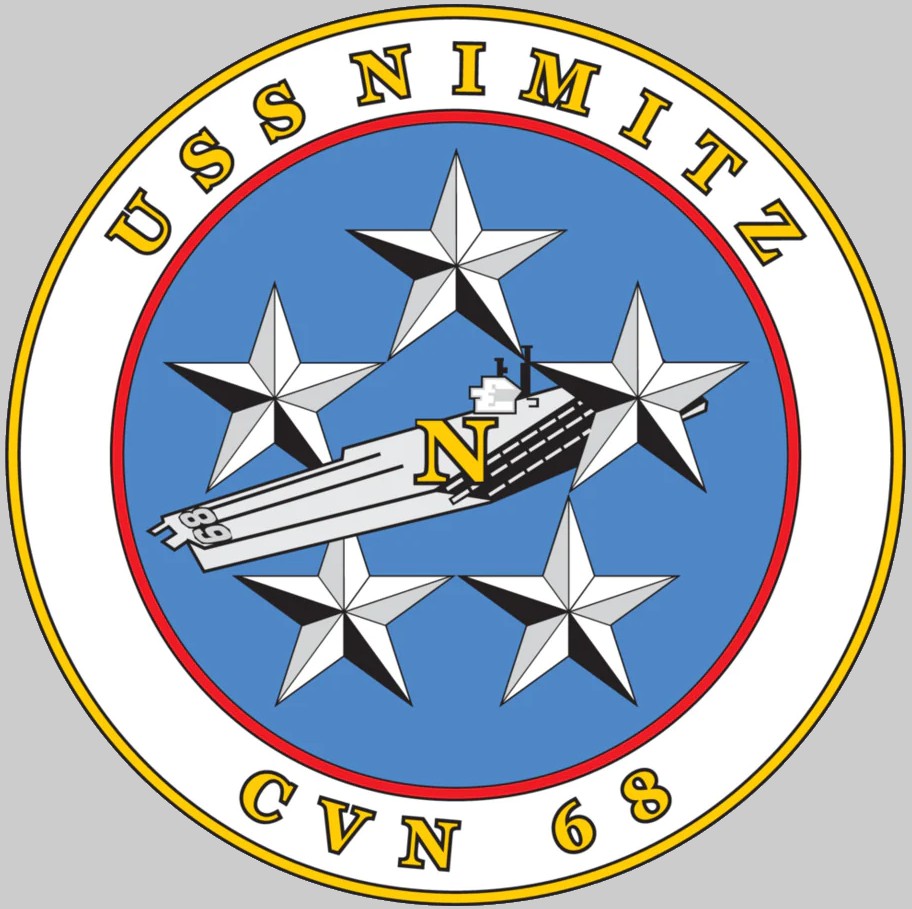 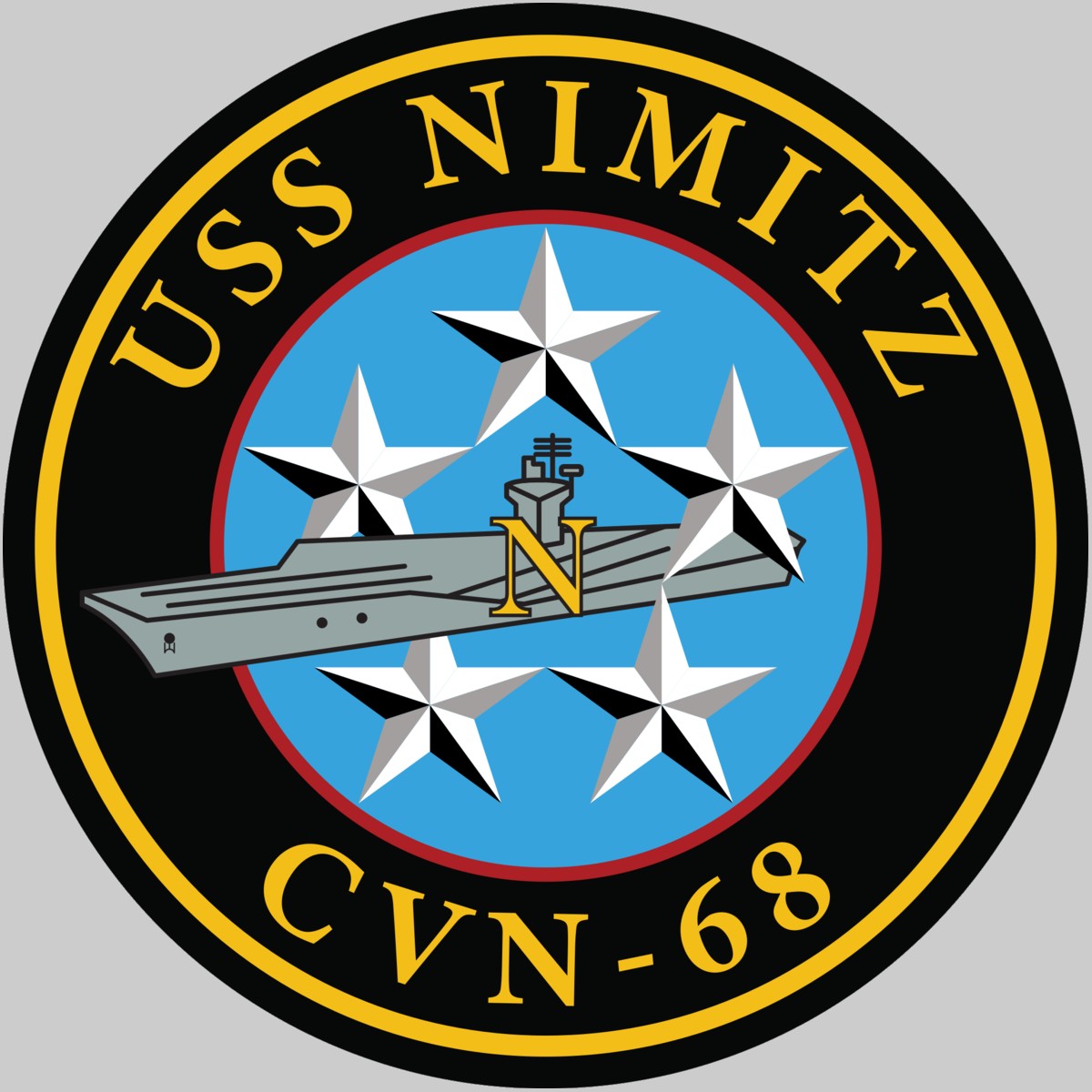 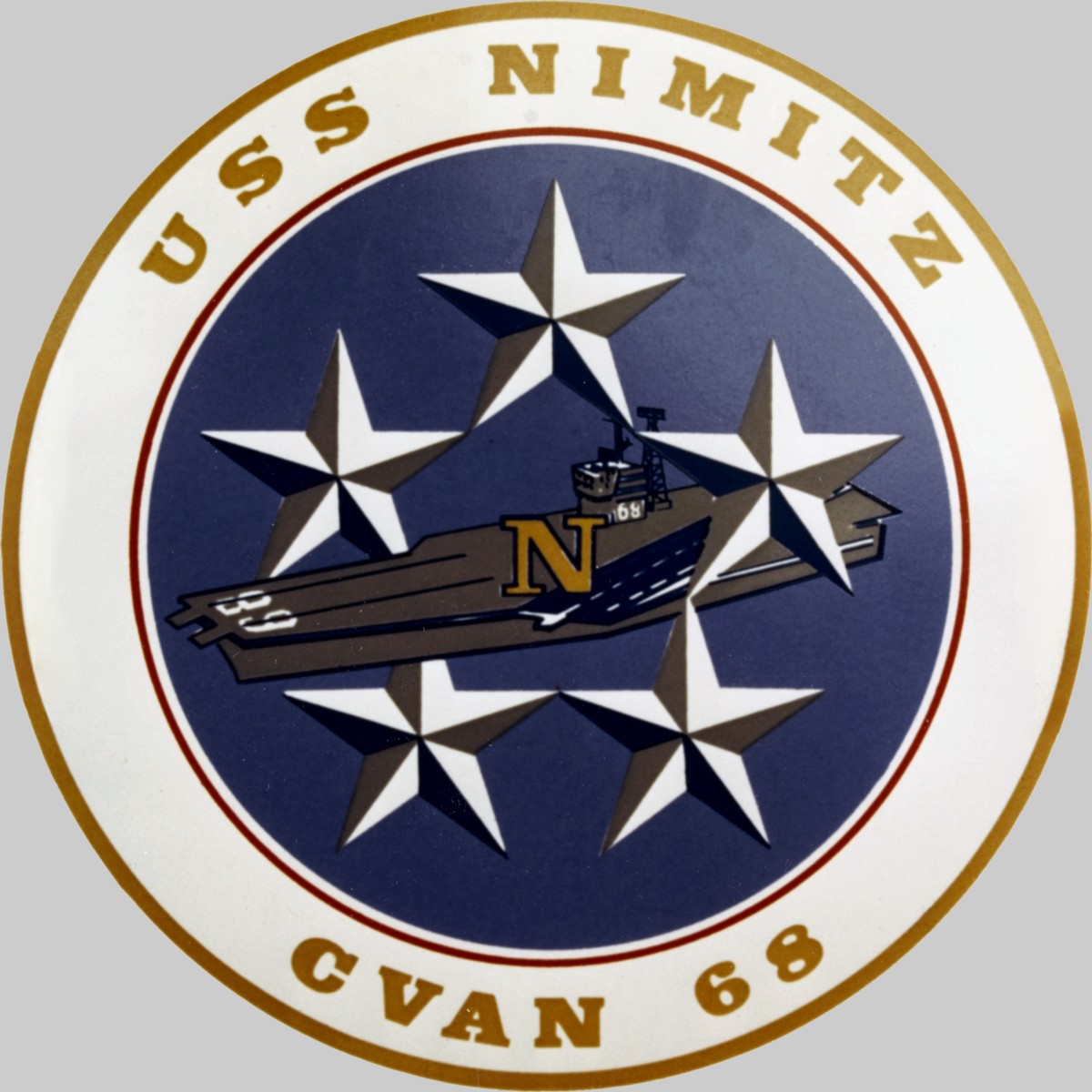 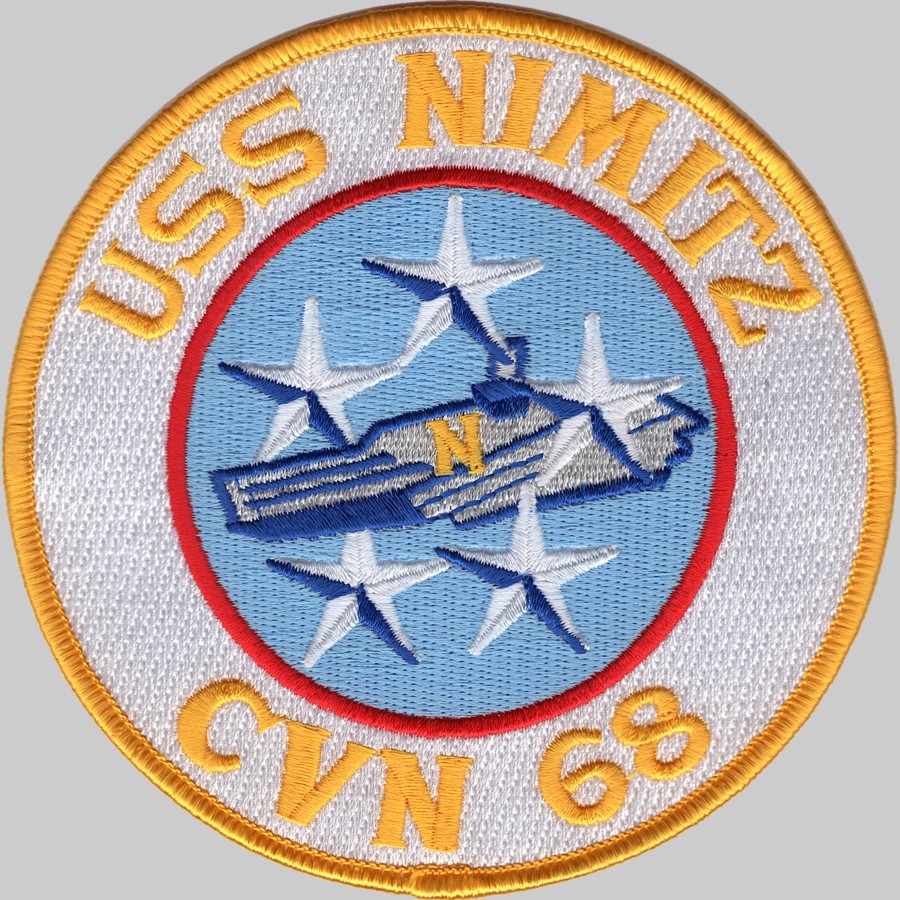 |
||
| | seaforces.org | USN ships start page | |
